Genetic analysis suggests that all the world’s yeasts originated in China



This site is made possible by member support. ❤️
Big thanks to Arcustech for hosting the site and offering amazing tech support.
When you buy through links on kottke.org, I may earn an affiliate commission. Thanks for supporting the site!
kottke.org. home of fine hypertext products since 1998.
Entries for July 2018
Being the book, an interview with an audiobook narrator
If you grew up in the 80s, you might remember Bronson Pinchot as Balki Bartokomous in Perfect Strangers or Serge in Beverly Hills Cop. But Pinchot has built a second career as an award-winning audiobook narrator. I recently listened to him read A Man on the Moon and while the story of the Apollo program is engrossing all by itself, his narration is fantastic. This interview of Pinchot by Jeff VanderMeer (author of the Southern Reach trilogy) is really interesting, particularly the bits about how he approaches his work.
Q: Do you have a philosophy of how to create the perfect audiobook experience?
A: I do, though, like all philosophical resolutions, I only intermittently achieve it. The essential task facing the narrator is to identify or invent a vivid personal definition of what “narrating” ought to be. I am uncomfortable with the chilliness of the word narration. It sounds very much outside the action - the voice on a National Geographic educational film intoning, “These giraffes are just learning how to mate”; or my mother, upon Audrey Hepburn’s entrance in My Fair Lady, informing the room: “She used to have such big doe eyes; what happened to her eyes?”
Simply “reading a book” aloud in an airless audio booth is the kind of mental and physical punishment only ever glimpsed in the lower section of Michelangelo’s Last Judgment. I decided early on that I should not “read” the book but “be” the book, the way I imagine Homer, in performance, “was” the Odyssey. We know he wasn’t “reading” it. In any case, if an audiobook listener doesn’t have the time to curl up with the actual physical text, he or she still yearns for, and deserves, the experience of being carried away by the author’s vision.
A 20-year time lapse of stars orbiting a massive black hole
The European Southern Observatory’s Very Large Telescope in Chile has been watching the supermassive black hole in the center of our galaxy and the stars that orbit it. Using observations from the past 20 years, the ESO made this time lapse video of the stars orbiting the black hole, which has the mass of four million suns. I’ve watched this video like 20 times today, my mind blown at being able to observe the motion of these massive objects from such a distance.
The VLT was also able to track the motion of one of these stars and confirm for the first time a prediction made by Einstein’s theory of general relativity.
New infrared observations from the exquisitely sensitive GRAVITY, SINFONI and NACO instruments on ESO’s Very Large Telescope (VLT) have now allowed astronomers to follow one of these stars, called S2, as it passed very close to the black hole during May 2018. At the closest point this star was at a distance of less than 20 billion kilometres from the black hole and moving at a speed in excess of 25 million kilometres per hour — almost three percent of the speed of light.
S2 has the mass of about 15 suns. That’s 6.6 × 10^31 pounds moving at 3% of the speed of light. Wowowow.
A quick visual story about welfare myths and food aid in America
From CityLab visual storyteller Ariel Aberg-Riger, How the Other Half Eats, a look at the myths surrounding welfare and how food aid (in the form of SNAP) works in the US.
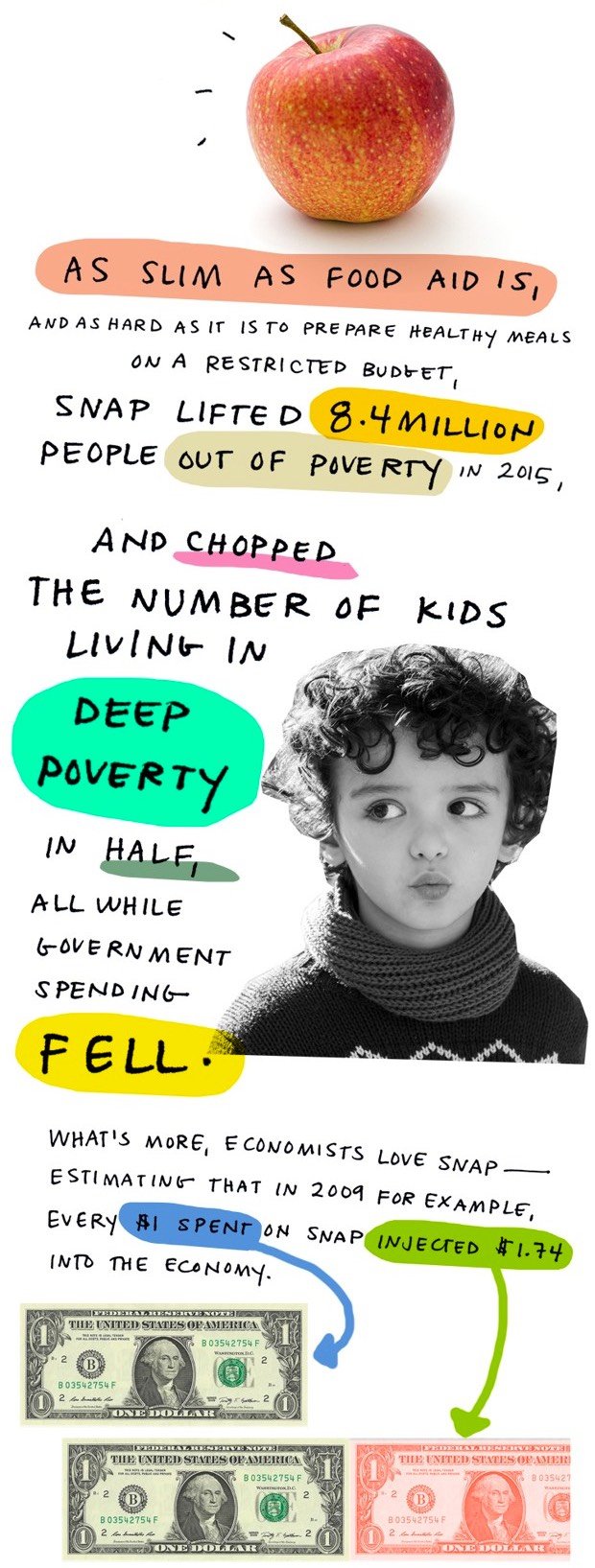
And don’t skip the extensive list of sources and recommended reading at the end of the piece…lots to dig into there.
The Mission Impossible movies are all heist films. From Lessons from the Screenplay, here’s how the filmmakers construct such compelling heists.
Five reasons why US restaurants are so loud. “5. Americans are loud.”
Cows, trees, corn, and golf - how America uses its land

Here’s How America Uses Its Land is a nice presentation by Bloomberg on land use in the US. The land and resources used for livestock makes a great case for Americans eating more vegetarian.
More than one-third of U.S. land is used for pasture — by far the largest land-use type in the contiguous 48 states. And nearly 25 percent of that land is administered by the federal government, with most occurring in the West. That land is open to grazing for a fee.
There’s a single, major occupant on all this land: cows. Between pastures and cropland used to produce feed, 41 percent of U.S. land in the contiguous states revolves around livestock.
Urban areas take up relatively less space but are growing the fastest. And only 100 people own a space the size of Florida? Wow.
On a percentage basis, urban creep outpaces growth in all other land-use categories. Another growth area: land owned by wealthy families. According to The Land Report magazine, since 2008 the amount of land owned by the 100 largest private landowners has grown from 28 million acres to 40 million, an area larger than the state of Florida.
It would be interesting to see this data sliced and diced in a few different ways. I’d love to see land use by state or area of the country or how much each category is growing or shrinking, with projections 5, 10, 20 years into the future.
What Do 90-Somethings Regret Most? “‘Do you wish you accomplished more?’ He responded, ‘No, I wished I loved more.’”
How one man rigged McDonald’s Monopoly and stole millions
For years, Jerry Jacobson was in charge of the security of the game pieces for McDonald’s Monopoly, one of the most successful marketing promotions in the fast food giant’s history. And for almost as long, Jacobson had been passing off winning pieces to family, friends, and “a sprawling network of mobsters, psychics, strip club owners, convicts, drug traffickers”, to the tune of more than million in cash & prizes.
Dent’s investigation had started in 2000, when a mysterious informant called the FBI and claimed that McDonald’s games had been rigged by an insider known as “Uncle Jerry.” The person revealed that “winners” paid Uncle Jerry for stolen game pieces in various ways. The $1 million winners, for example, passed the first $50,000 installment to Uncle Jerry in cash. Sometimes Uncle Jerry would demand cash up front, requiring winners to mortgage their homes to come up with the money. According to the informant, members of one close-knit family in Jacksonville had claimed three $1 million dollar prizes and a Dodge Viper.
When Dent alerted the McDonald’s headquarters in Oak Brook, Illinois, executives were deeply concerned. The company’s top lawyers pledged to help the FBI, and faxed Dent a list of past winners. They explained that their game pieces were produced by a Los Angeles company, Simon Marketing, and printed by Dittler Brothers in Oakwood, Georgia, a firm trusted with printing U.S. mail stamps and lotto scratch-offs. The person in charge of the game pieces was Simon’s director of security, Jerry Jacobson.
One of the winners, Jerry Columbo, a partner of Jacobson’s who was allegedly a member of the Mafia, even appeared in this TV commercial holding an oversized novelty key to a car he had “won”:
At the height of the scam, no normal person won any of the best Monopoly prizes…they were all arranged by Jacobson. This has to become a movie, right?
I remember when the Monopoly game started. We didn’t eat out that much when I was a kid, but we still played a few times here and there. But I distinctly remember studying the game board, looking at the odds of winning, and figuring out how they must restrict some single game pieces to make it all work. You could get Park Places all day long, but you’d never ever see a Boardwalk. After that realization, I lost interest in playing. It was an early lesson about not spending too much time and energy striving for unattainable goals. Besides, those delicious McDonald’s fries were reward enough.
Update: Ah, a movie version of the story is in the works with Matt Damon playing Jacobson and Ben Affleck directing.
Here comes the sunscreen


The three toughest things about being a parent are the sleep deprivation, knowing when to let kids push their boundaries vs keeping them safe, and applying sunscreen to a toddler. The NY Times has a slideshow of parents applying sunscreen to their kids and the struggle is real!
The good news for you parents of young children is that eventually they learn how to apply their own sunscreen. The bad news? They still would rather have a finger lopped off than to do it without complaining Every. Single. Freaking. Time.
Over the next six months, Ben Lecomte is swimming across the Pacific Ocean, from Japan to San Francisco. Follow his progress here.
Cross-section time lapse of a kidney bean growing into a plant
It’s fun to watch this kidney bean grow into a plant over the course of 25 days to the strains of The Blue Danube waltz by Johann Strauss. Thanks to this cross-sectional view, you can see the main root push down into the soil and the tendrils branching out to anchor the plant for its remarkable vertical growth to come.
Moon 101, a quick explainer video from National Geographic about the Moon
I have been going a little Moon crazy lately. There was the whole Apollo 11 thing, I finished listening to the excellent audiobook of Andrew Chaikin’s A Man on the Moon (which made me feel sad for a lot of different reasons), and am thinking about a rewatch of From the Earth to the Moon, the 1998 HBO series based on Chaikin’s book. This video from National Geographic answers a lot of questions about the Moon in a short amount of time.
Design-related baby names for creative parents (incl. Ascii, Lorem, Baskerville, and Zapf)
Virtually reality
From Vladimir Tomin, a fun augmented reality video where he uses a set of image editing tools to manipulate the scenery in fanciful ways. (It’s kinda hard to describe this…just give it 5 seconds and you’ll get the idea.)
(via Instagram’s explore page (yes, I’m the guy who uses the IG explore page))
What made Darth Vader such a visually iconic character
Darth Vader was only on screen in the original Star Wars movie for 8 minutes and for a little under 34 minutes in the whole original trilogy. In the latest Nerdwriter episode, Evan Puschak examines how the cinematography of the films (particularly Empire Strikes Back) helped make Vader into an iconic character despite such little screentime.
Today seems to be movie villain day on kottke.org: see also this morning’s post on Black Panther’s Killmonger.
Welcome to Marwen
Mark Hogancamp was beaten by five men outside a bar and left for dead. He spent nine days in a coma, lost his memory, and spent over a year in physical therapy. As part of his recovery, Hogancamp built a meticulously constructed WWII town in his backyard that he called Marwencol.
When his state-sponsored rehabilitative therapies ran out, Mark took his recovery into his own hands. In his backyard, he created a new world entirely within his control — a 1:6 scale World War II town he named Marwencol. Using doll alter egos of his friends and family, his attackers and himself, Mark enacted epic battles and recreated memories, which he captured in strikingly realistic photographs. Those photos eventually caught the eye of the art world, which lead to a series of gallery exhibitions, the award-winning documentary “Marwencol,” the acclaimed book “Welcome to Marwencol,” and a new identity for a man once ridiculed for playing with dolls.
Robert Zemeckis has turned Hogancamp’s story into a movie starring Steve Carell called Welcome to Marwen. Here’s the trailer; it comes out in December 2018:
In 2010, Jeff Malmberg made a documentary about Hogancamp & and his project. It’s a little hard to find these days despite a 98% rating on Rotten Tomatoes, but you can watch it on Amazon w/ a trial subscription or buy it on iTunes. Here’s the trailer:
Hogancamp also collected some of the photos of Marwencol into a book.
The SSL cert on didn’t get renewed. It should be fixed soon. For now, you can all go outside and play.
The artist who paints music



Melissa McCracken has synesthesia and experiences seeing the music she listens to as shifting colors. In an old artist statement, McCracken explained how she sees the world differently than many people:
Basically, my brain is cross-wired. I experience the “wrong” sensation to certain stimuli. Each letter and number is colored and the days of the year circle around my body as if they had a set point in space. But the most wonderful “brain malfunction” of all is seeing the music I hear. It flows in a mixture of hues, textures, and movements, shifting as if it were a vital and intentional element of each song.
Great Big Story did a short video profile of McCracken a couple of years ago:
I like how she says she dislikes how some songs sound but likes how they look. What a cool way to be able to experience the world.
McCracken is a bit coy on her site and Instagram about which songs inspired which paintings, but the paintings above are titled Love Is Touching Souls (from a Joni Mitchell lyric), Life on Mars (David Bowie), and Wasn’t It Kind of Wonderful (lyrics from a Lianne La Havas song?).
An interview with old school internet art collective JODI. “You can still make websites nowadays.”
How Black Panther created an empathetic antagonist for the hero
What makes a good movie villain? In this video, Lessons from the Screenplay discusses what I thought was the best and most interesting aspect of Black Panther: the empathetic villain in the form of Killmonger.
Killmonger is a great example of how an antagonist can challenge the hero not just through confrontation and violence, but by representing something that affects the hero emotionally.
Rather than pitting T’Challa against some “generically evil” villain, the filmmakers gave him a true foil that both he and the audience could empathize with. And by the end, Killmonger actually changes T’Challa’s mind on the central issue in the film and it felt earned.
Fire in Cardboard City
What happens when a city made entirely of cardboard catches fire? Nothing good, as Phil Brough’s 3D animated short film clearly illustrates. Fire in Cardboard City has been playing at film festivals around the world and now thanks to the New Yorker, you can watch the whole thing online. Sarah Larson talked with Brough about how the film came together.
The results look so realistic that they could almost be stop-motion. “I built a big virtual set, I guess, is how you could describe it,” he said. “The characters are like stop-motion marionettes in a way; they have joints to the arms and the knees and all of that, and controllers.” He then used a low-budget motion-capture process — a D.I.Y. version of Hollywood’s green screens and Ping-Pong-ball suits — using the XBox Kinect and special software. “It sees you doing the motions you want the character to do, and then you can transfer that to the animation so you can transfer that onto your characters,” he said. He considered having a giant robot attack Cardboard City, and then settled on fire: that looked kind of cool, too.
I *love* the DIY corrugated cardboard look of this film…I’d happily watch a feature-length version of this. See also Caine’s Arcade. (thx, karen)
Maps of the spread of the Agricultural & Industrial Revolutions
This is a map showing the spread of the cultivation of crops across Europe.
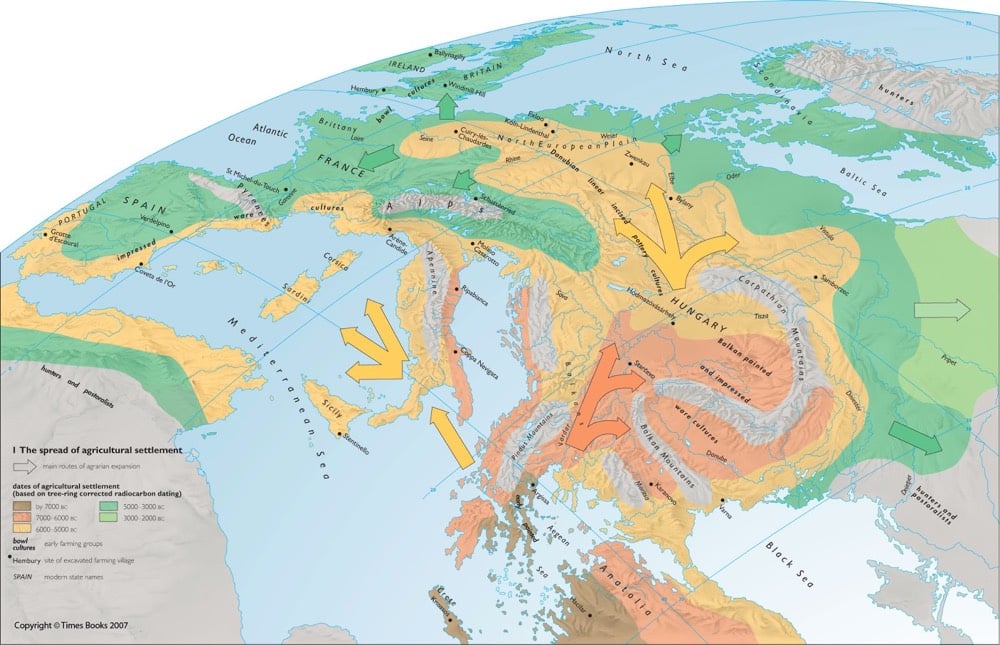
The legend is a bit hard to read, but the map indicates that it took ~2000-4000 years for farming to spread from Turkey to Britain. Several thousand years later, the Industrial Revolution boomeranged back out from Britain across Europe:

The dates and areas on both of these maps are rough & approximate1 but the important thing to notice here is the acceleration of the pace of technology. The technology of farming (seeds, techniques, tools, etc.) took thousands of years to spread across Europe but the expansion of industrial technology happened on the order of decades in the mid 19th century. That’s an incredible quickening.
And now? Seconds.2 An app launched in China can be downloaded moments later in a cottage in England or a cabin in Quebec and cutting edge scientific papers published in Brazil can be accessed almost instantaneously in India or Kenya. That’s fast enough that plotting it on a map doesn’t make sense…charts like these tell the story of technology adoption much better:
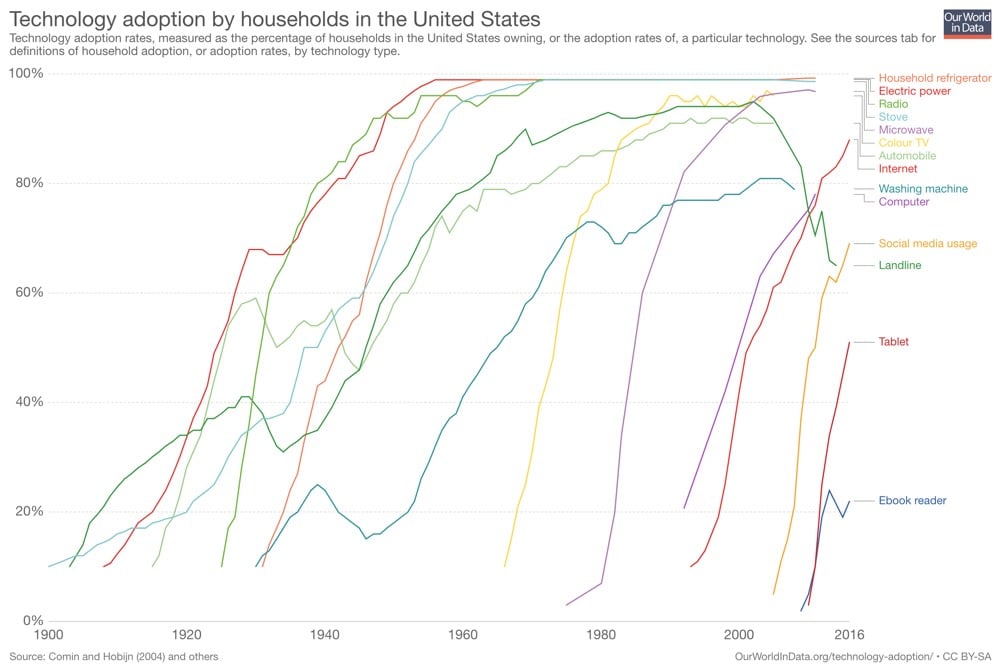

Maps like these are necessarily approximate, interpretive, and can change due to new discoveries and such. I’m not gonna give you a full rundown on the current state of the research into the spread of farming and industrialization. Check out Wikipedia (farming, industrialization) and work your way elsewhere if you’re really interested.↩
Acknowledging that just because something can be distributed worldwide in a couple seconds doesn’t mean everything is equally available in every part of the world. Even now, the William Gibson quote still holds: “The future is already here — it’s just not very evenly distributed.”↩
Natural selection in action: a pair of hurricanes changed the lizard population on Turks and Caicos. The post-hurricane lizards have bigger toes and legs for better grip in the wind.
City street orientations from around the world
Urban data scientist Geoff Boeing graphed the orientation of the streets in 50 cities from around the world. Here are 10 cities from his analysis:
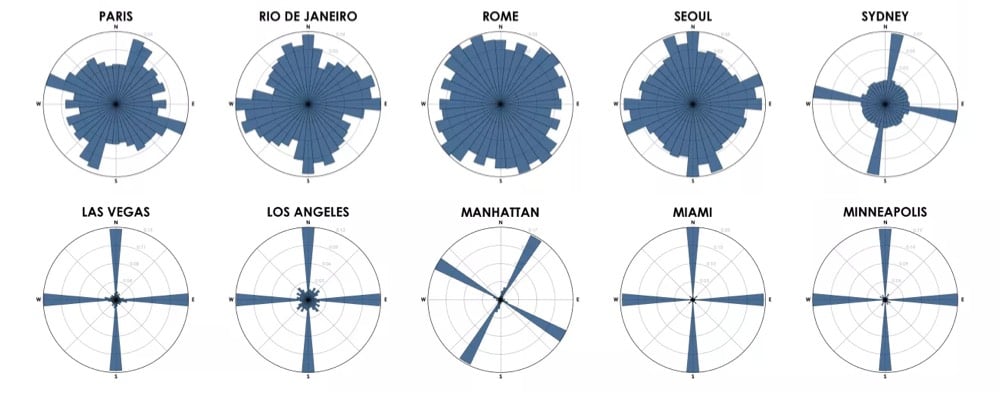
Each of the cities above is represented by a polar histogram (aka rose diagram) depicting how its streets orient. Each bar’s direction represents the compass bearings of the streets (in that histogram bin) and its length represents the relative frequency of streets with those bearings.
Looking at these graphs, you get a real sense of just how planned American cities are compared to much of the rest of the world, where cities grew more organically over longer periods of time. (Although I’m curious to see what the graph for all of NYC would look like…a bit more like Boston perhaps.)
Update: Using Mapbox, you can generate street orientation charts for any map view. I used it to verify that north-south roads outnumber east-west roads in New England, which is why it takes so long to go 30 miles across VT compared to up or down.
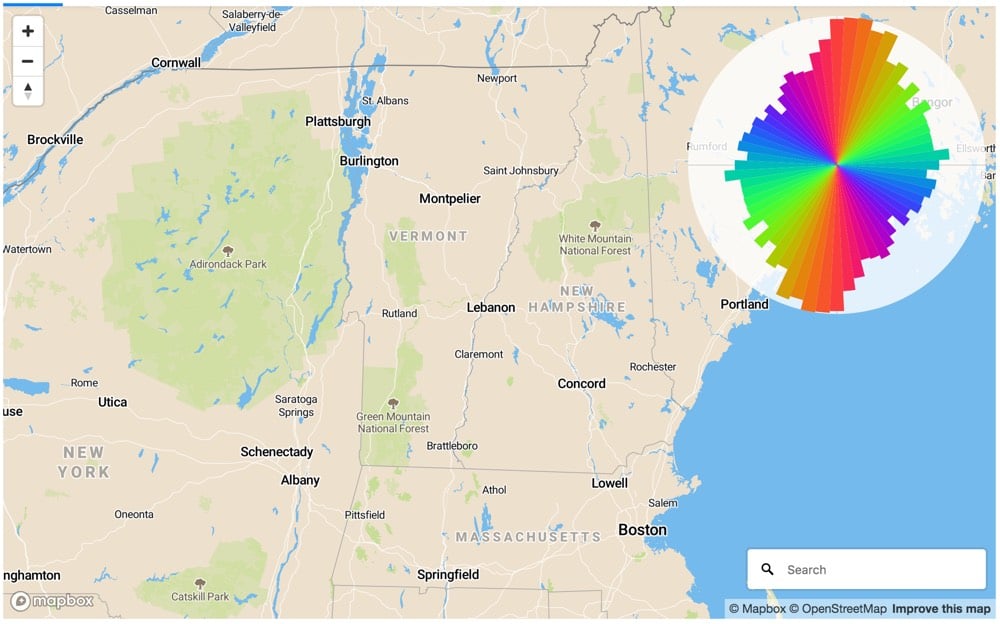
(via @dokas)
The Notorious Ruth Bader Ginsburg
I watched RBG last night, the documentary film about Supreme Court Justice Ruth Bader Ginsburg. What a remarkable person she is. Here’s the trailer:
If you’ve seen the movie (or even if you haven’t), Jeffrey Toobin’s 2013 New Yorker profile of Ginsburg goes easier on the memes and deeper into her legal process and views.
At this point, Ginsburg was a leader on the legal side of the women’s movement, especially when she became the first tenured woman at Columbia Law School, in 1972. She co-founded the first law review on women’s issues, Women’s Rights Law Reporter, and co-authored the first casebook on the subject. Also in 1972, she co-founded the women’s-rights project at the American Civil Liberties Union. When Sally Reed took her case to the Supreme Court, Ginsburg volunteered to write her brief.
“In very recent years, a new appreciation of women’s place has been generated in the United States,” the brief states. “Activated by feminists of both sexes, courts and legislatures have begun to recognize the claim of women to full membership in the class ‘persons’ entitled to due process guarantees of life and liberty and the equal protection of the laws.” In an opinion for a unanimous Court in Reed v. Reed, Chief Justice Burger overturned the Idaho law as “the very kind of arbitrary legislative choice forbidden by the Equal Protection Clause of the Fourteenth Amendment.” Sex discrimination, in other words, was unconstitutional. Susan Deller Ross, a professor at Georgetown University Law Center, who also worked as a lawyer on sex-discrimination cases during this period, said of Ginsburg, “She helped turn the Court a hundred and eighty degrees, from a very hands-off attitude, which had often been expressed very cavalierly, to one where they struck down law after law that treated the sexes differently.”
Building on the Reed precedent, Ginsburg launched a series of cases targeting government rules that treated men and women differently. The process was in keeping with Ginsburg’s character: careful, step by step. Better, Ginsburg thought, to attack these rules and policies one at a time than to risk asking the Court to outlaw all rules that treated men and women differently. Ginsburg’s secretary at Columbia, who typed her briefs, gave her some important advice. “I was doing all these sex-discrimination cases, and my secretary said, ‘I look at these pages and all I see is sex, sex, sex. The judges are men, and when they read that they’re not going to be thinking about what you want them to think about,’” Ginsburg recalled. Henceforth, she changed her claim to “gender discrimination.”
The piece mentions an impromptu serenade of opera fan Ginsburg by Plácido Domingo at Harvard…it’s a cute moment:
For a deeper dive, the best books about Ginsburg are The Legacy of Ruth Bader Ginsburg by Scott Dodson, My Own Words (a collection of her writing), and the more fun Notorious RBG: The Life and Times of Ruth Bader Ginsburg by Irin Carmon & Shana Knizhnik.
My media diet for early Summer 2018, special roadtrip edition
I’ve been keeping track of every media thing I “consume”,1 so here are quick reviews of some things I’ve read, seen, heard, and experienced in the past two months or so. My summer has been a little slow, media-wise…the World Cup, my roadtrip, and time spent enjoying the outdoors have conspired to limit my reading and watching time. This is not a bad thing. I’m still working my way through The Odyssey w/ the kids (now on hold b/c they’re at camp) and David Christian’s Origin Story. I wanted to get way more reading done this summer than I have…maybe I can pick up the pace in August. (Ignore the letter grades. Or don’t!)
Solo: A Star Wars Story. The movie was fine, but I liked the branding for it more. I would watch an Enfys Nest movie though. (B)
The Dave Chang Show w/ Helen Rosner. Chang is an engaging interviewer, and Rosner is a great guest. (B+)
RBG. What an extraordinary person. (B+)
American Innovations. Engaging and informative podcast hosted by Steven Johnson. (B)
Ocean’s 8. Pretty good but would have benefitted from a slightly more clever plot and direction by Soderbergh. (B+)
ye. As I’ve heard from more than one person: I hate that I like this album. (B+)
Skin in the Game: Hidden Asymmetries in Daily Life by Nassim Nicholas Taleb. This book contains a valuable central message and several fascinating insights but the constant ad hominems, irrelevant tangents, stereotyping, and general antagonistic tone of the writing makes for tough reading. I wish Taleb were a more generous writer. (B)
Incredibles 2. A solid sequel. Kids gave it two thumbs up. (A-)
Everything is Love. Ok, “The Carters”, but they smartly made this a Beyoncé album feat. Jay-Z. This has been on heavy rotation in my car. (A-)
The Disaster Artist. Gave up on this about 30 minutes in…zero interest. (-)
Justice League. Not as terrible as I was led to believe. But maybe DC can trade Wonder Woman to Marvel? (C+)
Caliphate. Finished this…what a great and important series. I know a lot of people think Serial is the podcast gold standard, but this was better and more significant. (A)
Seabiscuit. This one always gets me right in the feels. (B+)
Scorpion. Kanye’s latest album is 23 minutes long while Drake went for a full 90 minutes. I know there’s some controversy about it, but it was genuinely great hearing new music from Michael Jackson. (B)
The Handmaid’s Tale. The remainder of the second season was brutal. (A-)
A Man on the Moon: The Voyages of the Apollo Astronauts by Andrew Chaikin. An epic story of adventure and discovery, expertly told. (A)
Sharp Objects. This one is a slow burn, but I will watch Amy Adams in anything…she is mesmerizing. (B+)
Star Trek: Voyager. Still making progress on this…I’m about 70% of the way through. It’s better in the middle seasons than a lot of people give it credit for. (B)
Solo roadtrips. The world is a fascinating place…get out and explore it if you can. (A+)
Pacific Rim Uprising. They could have done more with this, but they didn’t. They really didn’t. (C+)
The 2018 FIFA World Cup. I missed most of the knockout stage because I was traveling, but I still loved every minute of this World Cup. (A-)
Jaws. My first time seeing it. (Yes, yes, I know.) Amazing to see so many of Spielberg’s filmmaking techniques on display so early in his career. (A-)
Westworld. This show asks, over and over again, “Is any of this real?” The result is a complete inability on my part to suspend my disbelief…I’m always very aware that what I’m watching is fake. (C-)
Hot Fuzz. Will watch this anytime. (A-)
Past installments of my media diet are available here.
You probably dislike the use of the word “consume” when it comes to media. So do I. It conjures up an image of mindlessly feeding on things that talented and artistic people have worked hard on. (See also “media diet”.) But different forms of work have different verbs associated with them: TV shows & movies are watched, books are read, podcasts are listened to, theme parks are experienced. What one word works for all of those? Enjoyed? I surely don’t enjoy all the stuff I watch/listen to/watch/experience (see!!). Experienced? That suggests a passiveness that doesn’t apply to how I watch/read things. “Consumed” works, for better or worse. Does anyone have a better suggestion? I am ready to consume it… ↩
Sci-fi spaceship designs inspired by everyday objects



Eric Geusz takes everyday objects like can openers, tongs, and potato peelers and turns them into spaceships that wouldn’t look out of place in Star Wars or Star Trek.
What a musical conductor actually does on stage
I love hearing people talk about how they work. In this quick video, conductor James Gaffigan explains what it is he does on stage and how different composers like Leonard Bernstein shape and enhance the performance of the musicians they’re leading.
If you’ve ever seen an orchestra perform you’ve probably had a difficult time looking away from the person dead center on the stage — the conductor. It’s hard to miss someone as they swing their arms around pointing at the musicians that seem to be focused instead on their music stands. So what exactly is the conductor doing?
The Russian Prison Tapping Code. “Through the grim stone wall we could sense the joy of the man on the other side. At last we had understood!”
The web’s transition from nomadism to feudalism
This comparison by designer Alexander Singh of the development of the web from home pages to massive content farms like Facebook with the development of agriculture really got some of the ol’ neurons firing.
Over the past 25 years, the web appears to have transitioned from a primarily nomadic culture to a mostly agrarian one, mirroring the Neolithic Revolution 10,000 years ago.
The simplicity of HTML-only site building, spaces like Geocities & Angelfire, and cultural artifacts such as web rings coupled with poor search engine tech saw us navigate the web like nomads: from point to point, link to link.
The web has developed & so have the skills necessary to build within it. HTML was easy. CSS took a little more time & JS more again, alienating most and establishing a class hierarchy. Discovery was solved, weakening point-to-point navigation.
The literate Priesthood can still build & interface with the web, but the vast majority of people are relegated to the peasantry. “Fortunately” for them, motivated benefactors have offered a Faustian bargain to make their lives “easier”.
Corporate Feudalism has emerged to create centralized, “safe” spaces for the peasantry to work & play. Attention is farmed and sold in exchange for convenience, protection, mediated self-expression & an indifferent audience. You can do anything if it’s within their borders.
Very interesting. What comes next? What does the web’s Renaissance or Enlightenment look like? (via @pieratt)
Secret Life of an Autistic Stripper. “I’ve always had trouble reading social cues, but in the strip club, where rules and roles are crystal clear, I finally learned to connect.”
A new book from David Grann about a polar journey gone wrong: The White Darkness
Author and New Yorker writer David Grann is out with a new book in the fall: The White Darkness. The book tells the story of polar explorer Henry Worsley, who attempted to duplicate the polar voyages of Ernest Shackleton, and is based on a long NYer piece written by Grann earlier this year.

The man felt like a speck in the frozen nothingness. Every direction he turned, he could see ice stretching to the edge of the Earth: white ice and blue ice, glacial-ice tongues and ice wedges. There were no living creatures in sight. Not a bear or even a bird. Nothing but him.
It was hard to breathe, and each time he exhaled the moisture froze on his face: a chandelier of crystals hung from his beard; his eyebrows were encased like preserved specimens; his eyelashes cracked when he blinked. Get wet and you die, he often reminded himself. The temperature was nearly minus forty degrees Fahrenheit, and it felt far colder because of the wind, which sometimes whipped icy particles into a blinding cloud, making him so disoriented that he toppled over, his bones rattling against the ground.
The story has also been optioned for a movie, joining Grann’s previous book, Killers of the Flower Moon, which is being adapted by Martin Scorsese & Leonardo DiCaprio.
Film and Furniture, a Site About the Decor in Movies
On Film and Furniture, you’ll find info about the production and set designers of films & TV shows and features about the furniture and wallpaper in Phantom Thread, the Parr’s massive new home in Incredibles 2 (Pixar listed the place on Zillow), and some of the cooler items from Blade Runner 2049.

They also have a store from which you can buy items from your favorite movies: whiskey tumblers from Blade Runner, a sofa from Ex Machina, lounge chairs from 2001: A Space Odyssey, and, of course, the Overlook Hotel rug from The Shining. (thx to several ppl who sent this in)
A map of the most lewd-sounding town names in each state. Who’s up for a roadtrip from Short Pump, VA to Dickshooter, ID?
What if you detonated a nuclear bomb in the Marianas Trench?
In response to a dumb viral video with almost 20 million views that suggests detonating a powerful nuclear device at the bottom of the ocean would unleash global chaos, Kurzgesagt provides a counterpoint using, you know, science. This was also an early What If? query:
The bubble grows to about a kilometer across in a couple of seconds. The water above bulges up, though only slightly, over a large area. Then the pressure from that six miles of water overhead causes it to collapse. Within a dozen or so seconds, the bubble shrinks to a minimum size, then ‘bounces’ back, expanding outward again.
It goes through three or four cycles of this collapse and expansion before disintegrating into, in the words of the 1996 report, “a mass of turbulent warm water and explosion debris.” According to the report, as a result of such a deep-water closed bubble creation and dissipation, “no wave of any consequence will be generated.”
An orchestral take on Ibiza club hits
Gosh, I don’t know what micro-fraction of regular readers are going to be interested in this, but I sure was! In 2015, DJ Pete Tong and the Heritage Orchestra (under director Jules Buckley) collaborated on a performance of a bunch of Ibiza club hits from the likes of Moby, Fatboy Slim, Orbital, Brainbug, and Daft Punk. Here’s a Spotify playlist of the songs they covered.
Did I get goosebumps when the violins started in on Robert Miles’ Children? Possibly! Some of this stuff was the soundtrack to my web design work & play in the late 90s. kottke.org circa 1999 was at least 20% Fatboy Slim, Orbital, BT, Robert Miles, The Orb, and Daft Punk.
Update: And here’s an album of the performance itself on Spotify as well as a subsequent album featuring different club tracks. Tong and the orchestra are also touring the show around England, Ireland, and Scotland.
Ta-Nehisi Coates Is Leaving The Atlantic. “I want to be a writer, I’m not a symbol of what The Atlantic wants to do or whatever.”
Using weeds, pests, and invasive species to make sustainable sushi
At Miya’s Sushi in New Haven, CT, chef owner Bun Lai makes sustainable sushi using invasive species and other typically overlooked ingredients.
By collecting invasive seafood on shell-fishing beds, we are basically providing a free weeding service… We hope that this will do a few things. First of all, it could potentially curb the dominance of invasive species in the ecosystem. Secondly, it would provide the seafood industry a greater supply of native seafood and reduce the stresses on those populations already fished. Finally, we hope that it would encourage greater balance in the inter-regenerative relationship between man and the oceans. If we were to have thirty Miya’s in thirty different places, each one would have a slightly different menu, each reflecting the problems of its local universe.
Take a look at the current menu…there are entire sections dedicated to dishes made from invasive species (like Kentucky silver carp, Japanese knotweed, and Florida lionfish) and sustainable seafood.
How to see kung fu films
In this video, MoMA film curator La Frances Hui gives us a very quick and informative overview of what to look for when watching kung fu and martial arts films. Aside from Jackie Chan & more recent stuff like Crouching Tiger & Hero, I’ve never been super into martial arts movies, but after watching this, I’m excited to watch some of Lau Kar-leung’s films, particularly The 36th Chamber of Shaolin (which is currently streaming on Amazon Prime). Lau also directed and did the fight choreography for Drunken Master II, a favorite of mine that I haven’t seen in awhile.
A thagomizer is an arrangement of spikes on the tail of a Stegosaurus. The term was coined by Gary Larson in a Far Side cartoon and is now used by actual paleontologists. And why not, it’s a perfectly cromulent word!
This AI Makes High-Quality Slow Motion Videos from Regular 30 fps Video
NVIDIA trained a deep learning framework to take videos filmed at 30 fps and turn them into slow motion videos at the equivalent of 240 or even 480 fps. Even though the system is guessing on the content in the extra frames, the final results look amazingly sharp and lifelike.
“There are many memorable moments in your life that you might want to record with a camera in slow-motion because they are hard to see clearly with your eyes: the first time a baby walks, a difficult skateboard trick, a dog catching a ball,” the researchers wrote in the research paper. “While it is possible to take 240-frame-per-second videos with a cell phone, recording everything at high frame rates is impractical, as it requires large memories and is power-intensive for mobile devices,” the team explained.
With this new research, users can slow down their recordings after taking them.
Using this technique and what Peter Jackson’s team is doing with WWI footage, it would be interesting to clean up and slow down all sorts of archival footage (like the Zapruder film, just to choose one obvious example).
The weird and wonderful American roadtrip with John Margolies

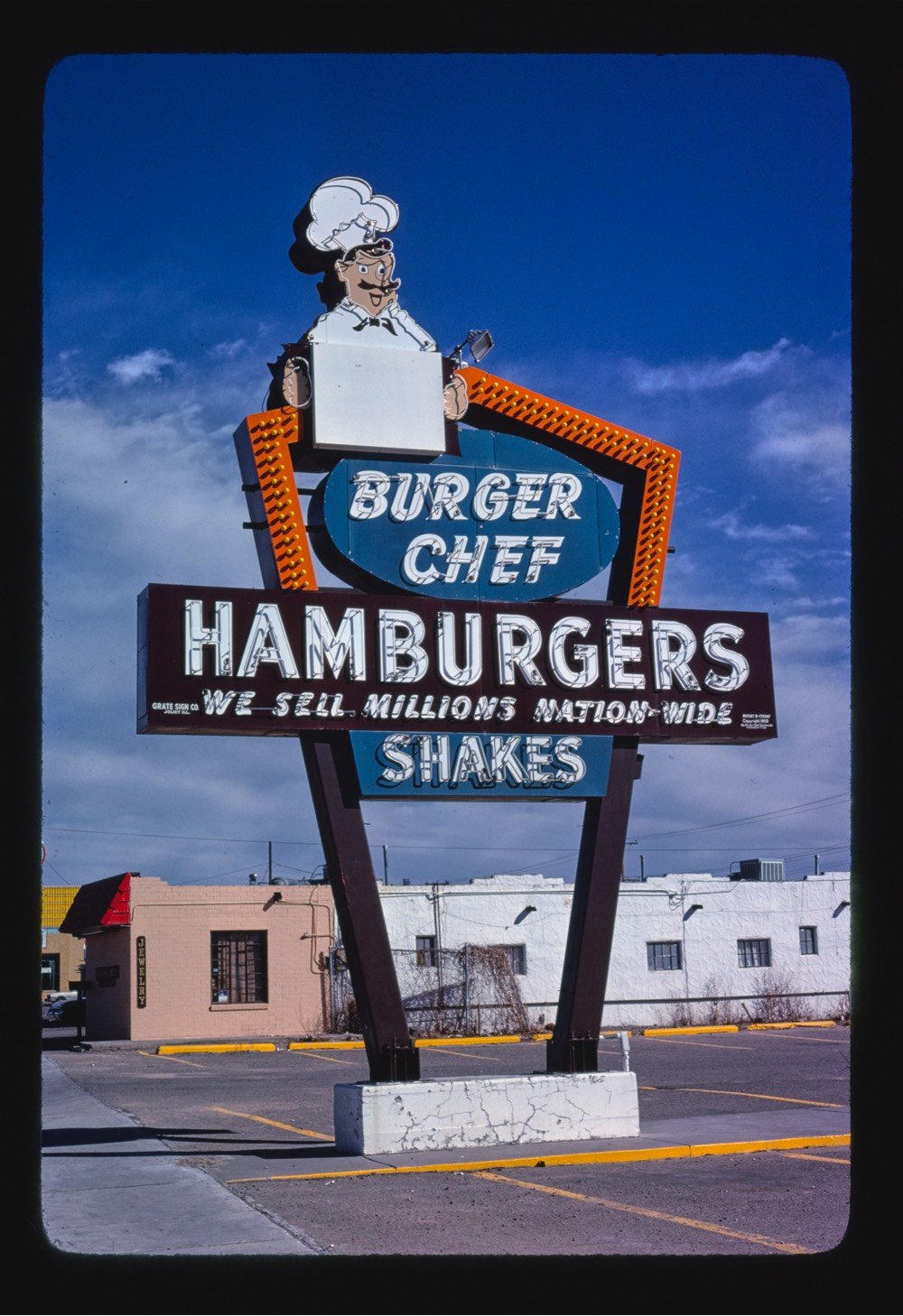
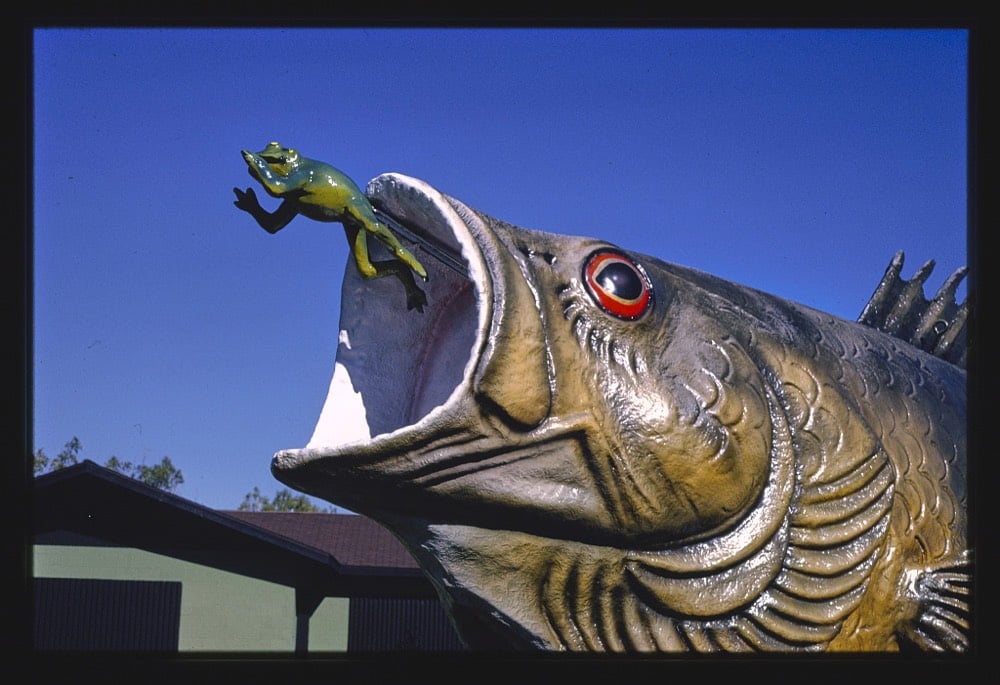
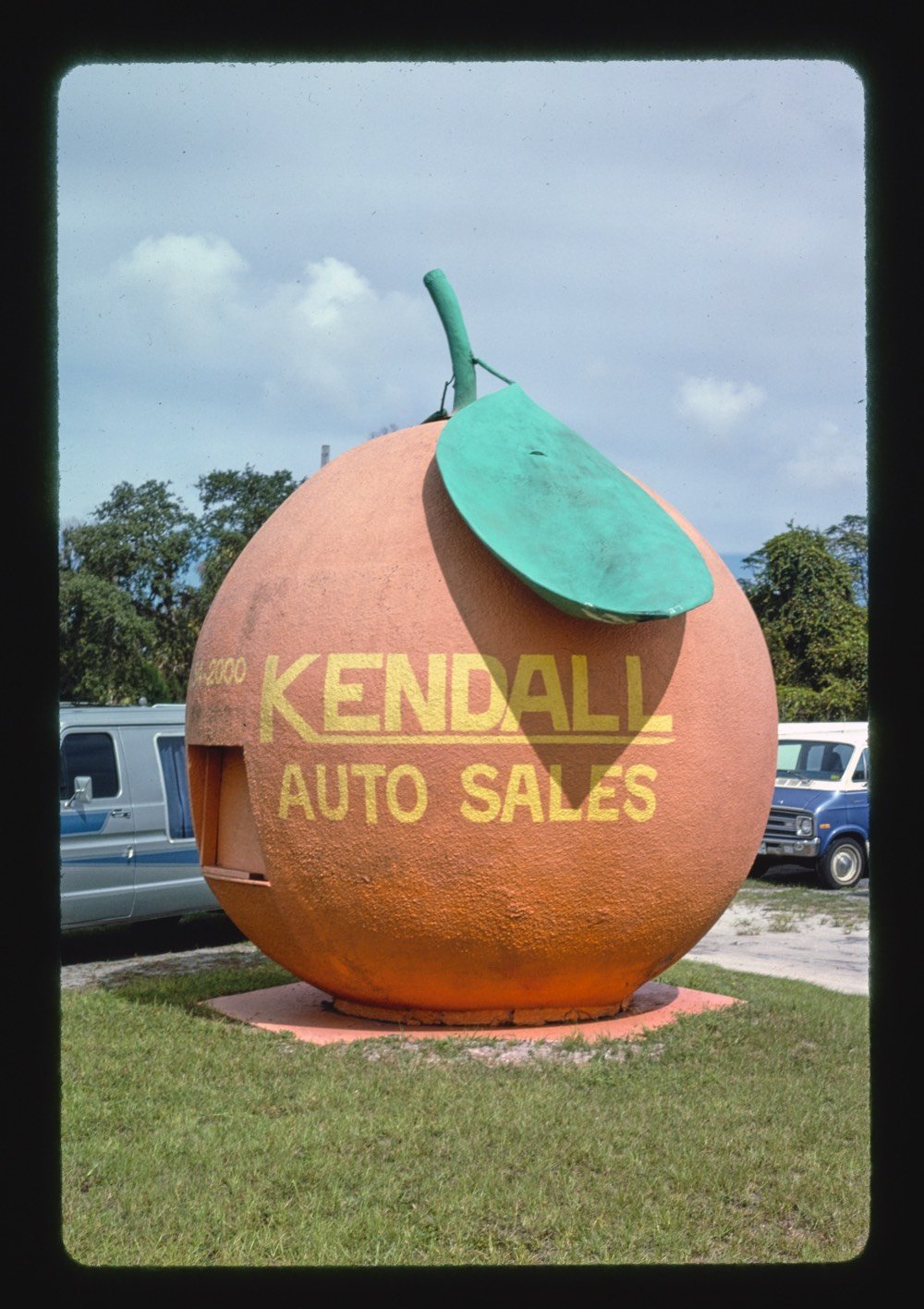
For more than 30 years beginning in the 1960s, photographer John Margolies criss-crossed the USA documenting the roadside architecture of a pre-corporate America, taking photos of diners, weird sculptures, mini golf courses, and signs that don’t exist anymore in great numbers.
Before the advent of corporate communications and architectural uniformity, America’s built environment was a free-form landscape of individual expression. Signs, artifacts, and even buildings ranged from playful to eccentric, from deliciously cartoonish to quasipsychedelic. Photographer John Margolies spent over three decades and drove more than 100,000 miles documenting these fascinating and endearingly artisanal examples of roadside advertising and fantasy structures, a fast-fading aspect of Americana.
In addition to publishing his work in a book, Margolies released his images into the public domain. The Library of Congress has posted over 11,000 of his photos online, a treasure trove of 60s & 70s Americana. Good luck spending less than 30 minutes poking around in there…
What does sleep do?

Sleep may be the most important everyday phenomenon that we understand the least well. It’s like the oceans; it’s everywhere, but we’ve only explored the surfaces. But scientists are still working to establish better knowledge of what sleep does, how it works, and why every animal does it (and needs to do it). National Geographic has a very pretty and pretty thorough summary of the latest theories of sleep scientists on what we do when we fall asleep.
The waking brain is optimized for collecting external stimuli, the sleeping brain for consolidating the information that’s been collected. At night, that is, we switch from recording to editing, a change that can be measured on the molecular scale. We’re not just rotely filing our thoughts—the sleeping brain actively curates which memories to keep and which to toss.
It doesn’t necessarily choose wisely. Sleep reinforces our memory so powerfully—not just in stage 2, where we spend about half our sleeping time, but throughout the looping voyage of the night—that it might be best, for example, if exhausted soldiers returning from harrowing missions did not go directly to bed. To forestall post-traumatic stress disorder, the soldiers should remain awake for six to eight hours, according to neuroscientist Gina Poe at the University of California, Los Angeles. Research by her and others suggests that sleeping soon after a major event, before some of the ordeal is mentally resolved, is more likely to turn the experience into long-term memories.
It’s basically a maintenance cycle. At deeper levels of sleep, we’re literally cleaning away waste products of waking life in the brain.
Good sleep likely also reduces one’s risk of developing dementia. A study done in mice by Maiken Nedergaard at the University of Rochester, in New York, suggests that while we’re awake, our neurons are packed tightly together, but when we’re asleep, some brain cells deflate by 60 percent, widening the spaces between them. These intercellular spaces are dumping grounds for the cells’ metabolic waste—notably a substance called beta-amyloid, which disrupts communication between neurons and is closely linked to Alzheimer’s. Only during sleep can spinal fluid slosh like detergent through these broader hallways of our brain, washing beta-amyloid away.
Dreams, too, reflect this heightened activity of the brain, but it’s unclear whether dreams themselves are a kind of harmless aftereffect or whether they perform a key function at reinforcing memory.
Lately, I’ve been fascinated by my own dreams, not least because reality has so often been disappointing. One recurring theme has been universities: libraries, offices, classrooms, campuses, over and over again. This isn’t terribly surprising: I spent a shade less than half my life, and most of my adult life, either going to school or working at one. But it’s difficult to make sense of. Do I miss the security/adventure of those times? Am I consolidating those memories to make room for new ones? Is an oracular entity trying to convince me to go back to school? I’m not sure. But understanding that SOMEthing is going on is a kind of balm that’s useful to me in ways I can’t totally articulate.
How to ask a favor
Some very useful advice from Valet magazine (which I confess I don’t read — thanks Yuri Victor!) on how to ask for a favor. It’s step by step and super simple:
- Be direct with your request;
- Give your reason why;
- Provide an opportunity for escape.
This last step, in particular, is nicely articulated:
This is really just good manners and keeps your relationship in good standing. It shows the other person you respect their time and that this isn’t a guilt trip. When you ask a favor, always offer the other person the opportunity to easily and graciously decline. End your request with something like, “I understand if you can’t do this now,” or “Please don’t feel obligated, if you aren’t comfortable with this.” Say this and mean it. Because a favor you aren’t able to refuse isn’t a favor at all. It’s an order or a command.
You can embroider this with lots of detail specific to the kind of behavior you’re asking for, but the core here is pretty spot-on. There’s also a nice bit of advice for folks granting a favor, that basically boils down to “do it or don’t do it, but don’t be a jerk about it.”
The history of the BBC Radiophonic Workshop

I am a sucker for high-tech analog art: magnetic tape, early wireless, punch cards, film and vinyl, the telephone, telegraph, and typewriter, and electricity before the transformation of digital technology. Consequently, and unsurprisingly, I love the BBC Radiophonic Workshop, and was delighted to read an article on its history from The Guardian.
Radiophonics owes everything to the invention of the tape recorder. Once you could capture sound, using a workable material, you could play with it: slow it down until it thundered, feed it back on itself until it shrieked and echoed, or simply slice bits out. However extreme these experiments became, there was always something eerily familiar to the ear, because they were made from real objects or events.
The term “radiophonic” came about because these mutated everyday sounds were put to the service of radio. “It is a new sound,” said the BBC, “suggestive of emotion, sensation, mood, rather than the literal moaning of the wind or the opening of a door.” Such things are now so easily achieved with digital technology that it’s hard to grasp how laborious - and groundbreaking - this all was.
The piece, riffing on a new book by does a nice job of eschewing undue nostalgia while digging into some of the Workshop’s most famous work — Doctor Who, The Hitchhiker’s Guide to the Galaxy — while also pointing out that most of the work was on simple education programs (which nevertheless introduced whole generations to new sonic possibilities). It restores the place of the many women who came through the workshop, including the inventive Delia Derbyshire, who played a huge role even as they often couldn’t get jobs at record studios or elsewhere in the recording industry.
My only complaint: it’s too darn short. I gotta read a book or something.
Trump’s Tax Cut Hasn’t Done Anything for Workers. “Wages were supposed to rise. Instead, they’ve fallen.”
Live TV coverage of the Apollo 11 landing and Moon walk
In May 1961, President John F. Kennedy stood before Congress and said:
I believe that this nation should commit itself to achieving the goal, before this decade is out, of landing a man on the moon and returning him safely to the earth.
A little more than 8 years later, it was done. On July 20, 1969, 49 years ago today, Neil Armstrong and Buzz Aldrin landed on the Moon, took a walk, and returned safely to Earth a few days later. And the whole thing was broadcast live on television screens around the world.
For the 40th anniversary of the landing in 2009, I put together a page where you can watch the original CBS News coverage of Walter Cronkite reporting on the Moon landing and the first Moon walk, synced to the present-day time. Just open this page in your browser and the coverage will start playing at the proper time. Here’s the schedule (all times EDT):
4:10:30 pm: Moon landing broadcast starts
4:17:40 pm: Lunar module lands on the Moon
4:20:15 pm: Break in coverage
10:51:27 pm: Moon walk broadcast starts
10:56:15 pm: First step on Moon
11:51:30 pm: Nixon speaks to the Eagle crew
12:00:30 am: Broadcast end (on July 21)
You can add these yearly recurring events to your calendar: Moon landing & Moon walk.
Here’s what I wrote when I launched the project, which is one of my favorite things I’ve ever done online:
If you’ve never seen this coverage, I urge you to watch at least the landing segment (~10 min.) and the first 10-20 minutes of the Moon walk. I hope that with the old time TV display and poor YouTube quality, you get a small sense of how someone 40 years ago might have experienced it. I’ve watched the whole thing a couple of times while putting this together and I’m struck by two things: 1) how it’s almost more amazing that hundreds of millions of people watched the first Moon walk *live* on TV than it is that they got to the Moon in the first place, and 2) that pretty much the sole purpose of the Apollo 11 Moon walk was to photograph it and broadcast it live back to Earth.
I’ve been listening to the audiobook of Andrew Chaikin’s account of the Apollo program, A Man on the Moon, and the chapter about Apollo 11’s Moon landing was riveting.1 I’ve watched the TV footage & listened to the recordings dozens of times and I was still on the edge of my seat, sweating the landing alongside Armstrong and Aldrin. And sweating they were…at least Armstrong was. Take a look at his heart rate during the landing; it peaked at 150 beats per minute at landing (note: the “1000 ft altitude” is mislabeled, it should be “100 ft”):
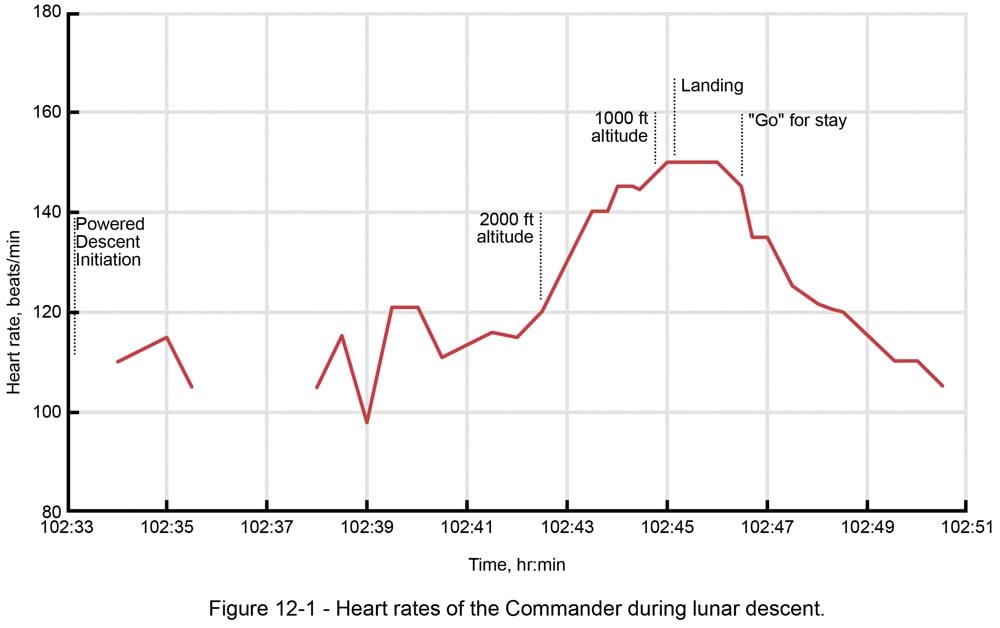
For reference, Armstrong’s resting heart rate was around 60 bpm. There are a couple of other interesting things about this chart. The first is the two minutes of missing data starting around 102:36. They were supposed to be 10 minutes from landing on the Moon and instead their link to Mission Control in Houston kept cutting out. Then there were the intermittent 1201 and 1202 program alarms, which neither the LM crew nor Houston had encountered in any of the training simulations. At the sign of the first alarm at 102:38:26, Armstrong’s heart rate actually appears to drop. And then, as the alarms continue throughout the sequence along with Houston’s assurances that the alarm is nothing to worry about, Armstrong’s heart rate stays steady.
Right around the 2000 feet mark, Armstrong realizes that he needs to maneuver around a crater and some rocks on the surface to reach a flat landing spot and his heart rate steadily rises until it plateaus at the landing. At the time, he thought he’d landed with less than 30 seconds of fuel remaining. That Neil Armstrong was able to keep his cool with unknown alarms going off while avoiding craters and boulders with very little fuel remaining and his heart rate spiking while skimming over the surface OF THE FREAKING MOON doing something no one had ever done before is one of the most totally cold-blooded & badass things anyone has ever done. Damn, I get goosebumps just reading about it!
Update: The landing broadcast just aired and I wanted to explain a little about what you saw (you can relive it here).
The shots of the Moon you see during the landing broadcast are animations…there is obviously no camera on the Moon watching the LM descend to the surface. There was a camera recording the landing from the LM but that footage was not released until later. This is in contrast to the footage you’ll see later on the Moon walk broadcast…that footage was piped in live to TV screens all over the world as it happened.
The radio voices you hear are mostly Mission Control in Houston (specifically Apollo astronaut Charlie Duke, who acted as the spacecraft communicator for this mission) and Buzz Aldrin, whose job during the landing was to keep an eye on the LM’s altitude and speed — you can hear him calling it out, “3 1/2 down, 220 feet, 13 forward.” Armstrong doesn’t say a whole lot…he’s busy flying and furiously searching for a suitable landing site. But it’s Armstrong that says after they land, “Houston, Tranquility Base here. The Eagle has landed.”. Note the change in call sign from “Eagle” to “Tranquility Base”. :)
Two things to listen for on the broadcast: the 1201/1202 program alarms I mentioned above and two quick callouts by Charlie Duke about the remaining fuel towards the end: “60 seconds” and “30 seconds”. Armstrong is taking all this information in through his earpiece — the 1202s, the altitude and speed from Aldrin, and the remaining fuel — and using it to figure out where to land.
The CBS animation shows the fake LM landing on the fake Moon before the actual landing — when Buzz says “contact light” and then “engine stop”. The animation was based on the scheduled landing time and evidently couldn’t be adjusted. The scheduled time was overshot because of the crater and boulders situation mentioned above.
Cronkite was joined on the program by former astronaut Wally Schirra. When Armstrong signaled they’d landed, Schirra can be seen dabbing his eyes and Cronkite looks a little misty as well as he rubs his hands together.
The book is read by Bronson Pinchot, who played Balki Bartokomous on the 80s sitcom Perfect Strangers. He is a fantastic audiobook narrator.↩
The last working fore-edge painter in the world
This is a short video profile of Martin Frost, who might be the last remaining professional fore-edge painter in the world.
Dating back centuries, the delicate art form places intricate scenes on the side of books, cheekily hidden beneath gold gilded pages. The beautiful paintings are only visible to the trained eye, but once you unlock the secret, you’ll find pure magic.
I love the two-way paintings…you fan the book’s pages out one way it depicts one scene and if you fan them out the other, you get another scene.
We should be building cities for people, not cars
Devon Zuegel says that our cities and the people who live in them would be much better off if we designed them around people and not cars.
Unfortunately, America’s inherited infrastructure is more like the old Embarcadero Highway than the boulevard that replaced it. Urban planners spent the 20th century building cities for cars, not people, and alternatives to driving have been systemically undervalued. This legacy has resulted in substandard health outcomes, missed economic opportunities, and a shortage of affordable housing.
We can’t wait around for another earthquake to reverse generations of bad policy. Luckily, it doesn’t require a natural disaster to begin reshaping our infrastructure. Small changes can have an outsized impact in expanding alternatives for how people move around. Rebuilding our infrastructure to enable walking, cycling, and mass transit would bring health and economic benefits that far outweigh its price tag.
People who live in rural areas more or less need their own cars in order to do anything, but private cars in cities are much less necessary. Cities should optimize for buses, subways, cyclists, and pedestrians — they get people to where they’re going without all the outsized infrastructure, waste, and pollution. *repeatedly sticks pin into voodoo doll of Robert Moses*
Update: Alissa Walker writing for Curbed: Don’t ban scooters. Redesign streets. (because there’s still too much space allocated to cars).
Market Street offers a glimpse of how contemporary U.S. cities might be edging towards that shared-street mentality (a proposal to completely ban private cars from the street was ahead of its time). But it also illustrates something else — if you give people ample space to move at a safe speed using the mode of their choice, anyone can use the street.
All over the country, city leaders are spending their summers devoting careful thought to the number of rentable e-bikes that can be deployed on streets at once, where electric scooters might be parked, and how dockless companies should be punished for violating these terms. Just this week, the National Association of City Transportation Officials, which collates best practices from its 62 member cities, released draft guidelines around the regulation of “small vehicles.”
Yet largely absent from these decisions — at least the public-facing ones — are how cities plan to quickly and dramatically reconfigure their streets to allow people to actually use anything but a car.
Winners of the 2018 Audubon Photography Awards



The National Audubon Society has announced the winners of their ninth annual photography contest. The winning photos, which “evoke the splendor, resilience, and ingenuity of birdlife”, were drawn from over 8000 entries from all over the US and Canada.
The photos above are a great grey owl by Steve Mattheis, a long-tailed tit by Diana Rebman, and a flock of cobalt-winged parakeets by Liron Gertsman. Gertsman swept the youth category with the winning image and both honorable mentions. Here’s what he had to say about the parakeets:
Three days in a row I waited in a blind near a clay lick that Cobalt-winged Parakeets and other birds of the Amazon frequent. When hundreds of the birds finally descended from the tree canopy to the mineral-rich forest floor on the third morning, I was ready. I used a slow shutter speed to accentuate the blues in their wings. I don’t think I’ll ever forget the sight of the birds or the deafening roar of parakeet chatter.
A list of the top 100 photos is available here. (via in focus)
Watch Eloma Simpson Barnes channel Martin Luther King Jr. in a thrilling oration
On Twitter this morning, Craig Mod asked:
What’s the best conference talk/public speech you’ve seen? Topic can be anything. Just the most engaging talk you’ve been present for?
And bonus points: Is there any one particular speaker who’s so good you make an effort to see?
I’ve been to a lot of conferences and seen some very engaging speakers, but the one that sticks out most in my mind is Eloma Simpson Barnes’ performance of a Martin Luther King Jr. speech at PopTech in 2004 (audio-only here).
Her oration is actually a combination of excerpts from two King speeches: his address at the Great Walk to Freedom in Detroit in June 1963 and his Drum Major Instinct sermon given at Atlanta’s Ebenezer Baptist Church in February 1968. King’s Detroit address is notable for being a test run of sorts for his I Have a Dream speech in Washington D.C. two months later. If you look at the Detroit transcript, you’ll notice some familiar words:
And so this afternoon, I have a dream. (Go ahead) It is a dream deeply rooted in the American dream.
I have a dream that one day, right down in Georgia and Mississippi and Alabama, the sons of former slaves and the sons of former slave owners will be able to live together as brothers.
I have a dream this afternoon (I have a dream) that one day, [Applause] one day little white children and little Negro children will be able to join hands as brothers and sisters.
In the Drum Major Instinct sermon given two months to the day before his assassination, King told the congregation what he wanted to be said about him at his funeral:
I’d like somebody to mention that day that Martin Luther King, Jr., tried to give his life serving others.
I’d like for somebody to say that day that Martin Luther King, Jr., tried to love somebody.
I want you to say that day that I tried to be right on the war question.
I want you to be able to say that day that I did try to feed the hungry.
And I want you to be able to say that day that I did try in my life to clothe those who were naked.
I want you to say on that day that I did try in my life to visit those who were in prison.
I want you to say that I tried to love and serve humanity.
Some of the power of Barnes’ performance is lost in the video, particularly when audio from King’s actual speeches are available online, but sitting in the audience listening to her thundering away in that familiar cadence was thrilling. I can’t imagine how it must have felt to experience the real thing.
Peter Jackson is remastering old WWI film footage
Working with the 14-18 NOW project, Peter Jackson is making a film about the experience of the soldiers fighting in World War I. As part of the process, Jackson and his special effects team (who have worked on the LOTR films, etc.) have been remastering and reimagining film footage from the collection of the Imperial War Museums. Here’s Jackson talking about the project and showing some of the remastered video:
The footage has been stabilized, the grain and scratches cleaned up, and the pace slowed down to from comedic to lifelike. Jackson’s also planning on using colorization to make the people in that old footage seem as contemporary as possible. Here are some split-screen stills comparing the old footage with the remastered video:

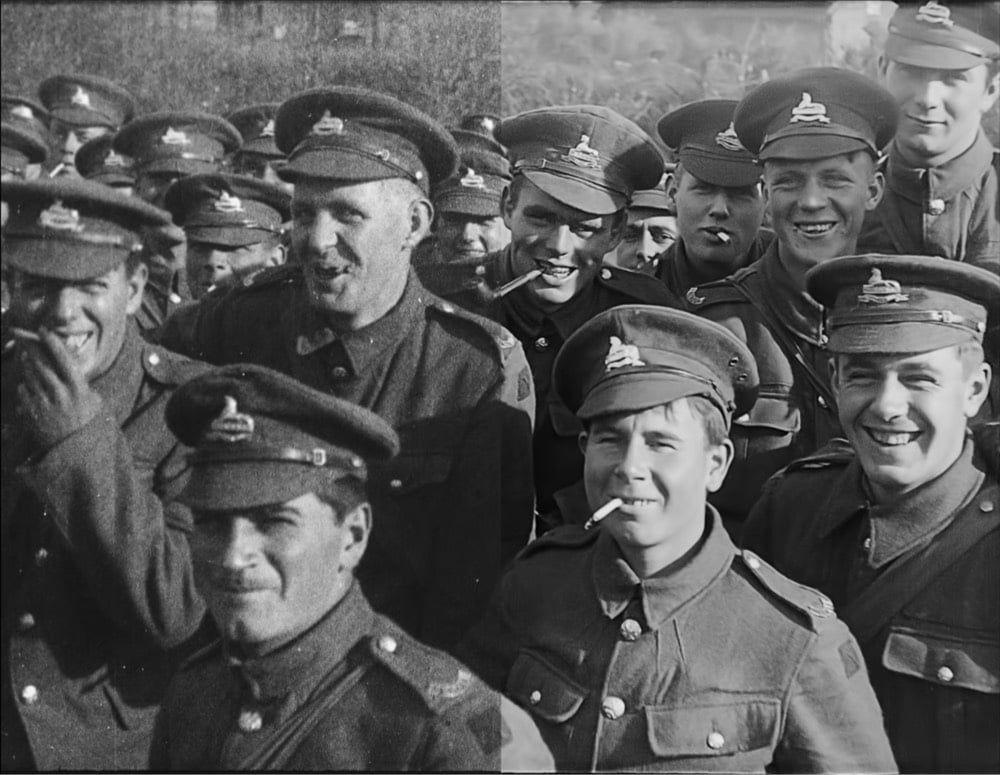

The finished product will be shown in theaters and schools around the UK in the fall and also on the BBC. (via open culture)
Chance the Rapper bought the Chicagoist website and announced it in a new song. “I bought the Chicagoist just to run you racist bitches outta bidness.”
Gmorning, Gnight!, a book of affirmations from Lin-Manuel Miranda
On Twitter, Hamilton creator Lin-Manuel Miranda often begins and ends his days by posting affirmations for his fans & readers. Stuff like:
Good night. Your mind is yours alone and you decide who and what gets in. Draw the curtains. Make yourself at home.
Good morning. Do NOT get stuck in the comments section of life today. Make, do, create the things. Let others tussle it out. Vamos!
Gnight. Don’t forget to look up your work & let real life in. It makes your work better.
Good morning. You are perfectly cast in your life. I can’t imagine anyone but you in the role. Go play.
Miranda has collaborated with illustrator Jonny Sun on a collection of this inspirational tweets called Gmorning, Gnight!: Little Pep Talks for Me & You. It’s out in October, but you can pre-order it now. It doesn’t fit the theme but I hope they found a way to fit this all-time Hall of Fame tweet in there.
I just saw Jaws for the first time. AMA.
Everyone has that one obviously great and popular movie that they haven’t seen yet for no good reason. Mine is Jaws. Or at least it was. Last night, I finally watched it. What an experience to get to witness the invention of the blockbuster movie and the storytelling gifts of a young Steven Spielberg already approaching full strength.
In this video, Julian Palmer analyzes the beach scene in Jaws and explains what makes it so effective. He compares Spielberg’s filmmaking to Alfred Hitchcock’s and the parallels are apt.
I think the reason why Spielberg is so popular with audiences is because he is so adept at putting the viewer through the ringer. He doesn’t just objectively play out a scene, he engages the viewer directly and makes them experience the same emotions as his characters.
(video via @veganstraightedge)
Remembering the girls of the Leesburg Stockade
In Georgia in 1963, 15 African-American girls aged 12 to 15 were arrested for trying to buy movie tickets at the whites-only theater entrance. They were arrested and held without charge for up to 45 days, their parents unaware of their whereabouts.
Instead of forming a line to enter from the back alley as was customary, the marchers attempted to purchase tickets at the front entrance. Law enforcement soon arrived and viciously attacked and arrested the girls. Never formally charged, they were jailed in squalid conditions for forty-five days in the Leesburg Stockade, a Civil War era structure situated in the back woods of Leesburg, Georgia. Only twenty miles away, parents had no knowledge of where authorities were holding their children. Nor were parents aware of their inhumane treatment.

Sickening. And to top it off, their parents each had to pay a $2 boarding fee when the girls were finally released. The Leesburg Stockade incident is a timely reminder that tyrants in America on the wrong side of justice have often separated children from their parents for political leverage. It wasn’t right then, and it’s not right now.
Why do people go crazy for sports? Sports fans whose teams win experience almost the same surge of feel-good brain chemicals as the athletes do.
The Constructive-Destructive Axis
In his biography of Apple founder Steve Jobs, Walter Isaacson reports on some comments Jobs made over dinner to News Corp’s Rupert Murdoch about Fox News in 2010.
In return for speaking at the retreat, Jobs got Murdoch to hear him out on Fox News, which he believed was destructive, harmful to the nation, and a blot on Murdoch’s reputation. “You’re blowing it with Fox News,” Jobs told him over dinner. “The axis today is not liberal and conservative, the axis is constructive-destructive, and you’ve cast your lot with the destructive people. Fox has become an incredibly destructive force in our society. You can be better, and this is going to be your legacy if you’re not careful.” Jobs said he thought Murdoch did not really like how far Fox had gone. “Rupert’s a builder, not a tearer-downer,” he said. “I’ve had some meetings with James, and I think he agrees with me. I can just tell.”
Such an insightful comment by Jobs. As John Gruber notes:
This line from Jobs — “The axis today is not liberal and conservative, the axis is constructive-destructive” — is truly the best summary of Trumpism I’ve seen.
It’s been eight years since that conversation and the Republican Party & their voters have doubled down in destroying opportunities for people (particularly those with little power), driven by the likes of Fox News. This destruction will be felt for generations to come.
An entomologist rates ant emojis

An entomologist rates the ant emoji from a number of services including Facebook, Apple, Microsoft, and Twitter. You can check out more reviews here.
A lost 1956 screenplay by Stanley Kubrick was recently uncovered. It’s adapted from a Stefan Zweig novella and is finished enough to “be completed by film-makers today”.
When you do a DNA test and find out your dad is not your father
Sarah Zhang writes about a support group on Facebook for people who have discovered surprising parentage through DNA testing.
Lisa, 44, admits she is still trying to go of that anger. She had always felt out of place in her family. Her hair — which she always straightened — was naturally fine and curly, her skin dark. “People would think I’m Hispanic, and would speak Spanish to me on the street,” she says. So when an DNA test in 2015 revealed her biological father was likely African American, it clicked into place. But her mom denied it. “She wouldn’t answer me. She would change the subject,” recalls Lisa. When she kept pressing, her mother broke down, saying it would destroy the family and that her dad — the man she grew up with — would kill her. She refused to say anything else about Lisa’s biological father.
I’ve written about this before (here and here) and reading these stories never gets any less heartbreaking. Back in 2010, I shared this:
I know someone who adopted a baby and they have never told her that she’s adopted and don’t plan to (she’s now in her 20s). When DNA testing becomes commonplace in another 5-15 years, I wonder how long that secret will last and what her reaction will be.
DNA testing confirms what we should have known all along: family is more than what biology says it is. Families already look quite differently than they did 40-50 years ago and they will continue to shift in the future, MAGA be damned.
The 10 Horniest Men in Literature. “1. Nino Sarratore – The Neapolitan novels by Elena Ferrante”
Anthony Bourdain on travel, luxury, the Despot’s Club, and more
Back in February, Maria Bustillos was set to interview Anthony Bourdain and she figured she’d get about 15 minutes of his highly scheduled time. Instead, the pair spent two-and-a-half hours chatting about anything and everything and the result is this great dialogue, one of the last extensive interviews Bourdain gave before he died in early June.
I like the idea of inspiring or encouraging people to get a passport and go have their own adventures. I’m a little worried when I bump into people, and it happens a lot — “We went to Vietnam, and we went to all the places you went.” Okay that’s great, because I like those people and I like that noodle lady, and I’m glad they’re getting the business, and it pleases me to think that they’re getting all these American visitors now.
But on the other hand, you know, I much prefer people who just showed up in Paris and found their own way without any particular itinerary, who left themselves open to things happening. To mistakes. To mistakes, because that’s the most important part of travel. The shit you didn’t plan for, and being able to adapt and receive that information in a useful way instead of saying, like, “Oh, goddamnit, they ran out of tickets at the Vatican!” or whatever, “That line at the Eiffel Tower is you know, six hours!” and then sulk for the rest of the day.
On my recent trip, I had some things that I wanted to see but largely ended up playing it by ear. And that thing about the mistakes…that hits really really close to home. I also loved his recontextualization of luxury:
I do find that my happiest moments on the road are not standing on the balcony of a really nice hotel. That’s a sort of bittersweet — if not melancholy — alienating experience, at best. My happiest moments on the road are always off-camera, generally with my crew, coming back from shooting a scene and finding ourselves in this sort of absurdly beautiful moment, you know, laying on a flatbed on those things that go on the railroad track, with a putt-putt motor, goin’ across like, the rice paddies in Cambodia with headphones on… this is luxury, because I could never have imagined having the freedom or the ability to find myself in such a place, looking at such things.
To sit alone or with a few friends, half-drunk under a full moon, you just understand how lucky you are; it’s a story you can’t tell. It’s a story you almost by definition, can’t share. I’ve learned in real time to look at those things and realize: I just had a really good moment.
Luxury as freedom of time, place, and companions. Read the whole thing…lots of great stuff in there. Like: he gave away all the royalties to Kitchen Confidential to “various deserving people”.
Seven bits of advice from Kurt Vonnegut to people living 100 years in the future
In 1988, at the behest of Volkswagen, author Kurt Vonnegut wrote a letter of advice to people living on Earth 100 years in the future. In it, he urged people to live more in harmony with the natural world through these seven steps:
The sort of leaders we need now are not those who promise ultimate victory over Nature through perseverance in living as we do right now, but those with the courage and intelligence to present to the world what appears to be Nature’s stern but reasonable surrender terms:
1. Reduce and stabilize your population.
2. Stop poisoning the air, the water, and the topsoil.
3. Stop preparing for war and start dealing with your real problems.
4. Teach your kids, and yourselves, too, while you’re at it, how to inhabit a small planet without helping to kill it.
5. Stop thinking science can fix anything if you give it a trillion dollars.
6. Stop thinking your grandchildren will be OK no matter how wasteful or destructive you may be, since they can go to a nice new planet on a spaceship. That is really mean, and stupid.
7. And so on. Or else.
(via open culture)
America’s ramen obsession
The latest video in the New Yorker’s Annals of Obsession tracks the transformation of ramen from a cheapo dorm room food to current culinary obsession showing no signs of abating. I ate the cheap ramen in college, dined at David Chang’s Momofuku Noodle Bar early on, and might pick ramen as my death-bed food,1 so I guess this video was pretty much made for me. Honestly the toughest part about where I live right now is the 2-hour roundtrip drive to eat ramen.
The hyperrealistic drawings by this 11-year-old Nigerian artist are incredible
Kareem Waris Olamilekan is 11 years old and makes very realistic drawings like these of his friends, family, and other faces he runs across (like Rihanna):
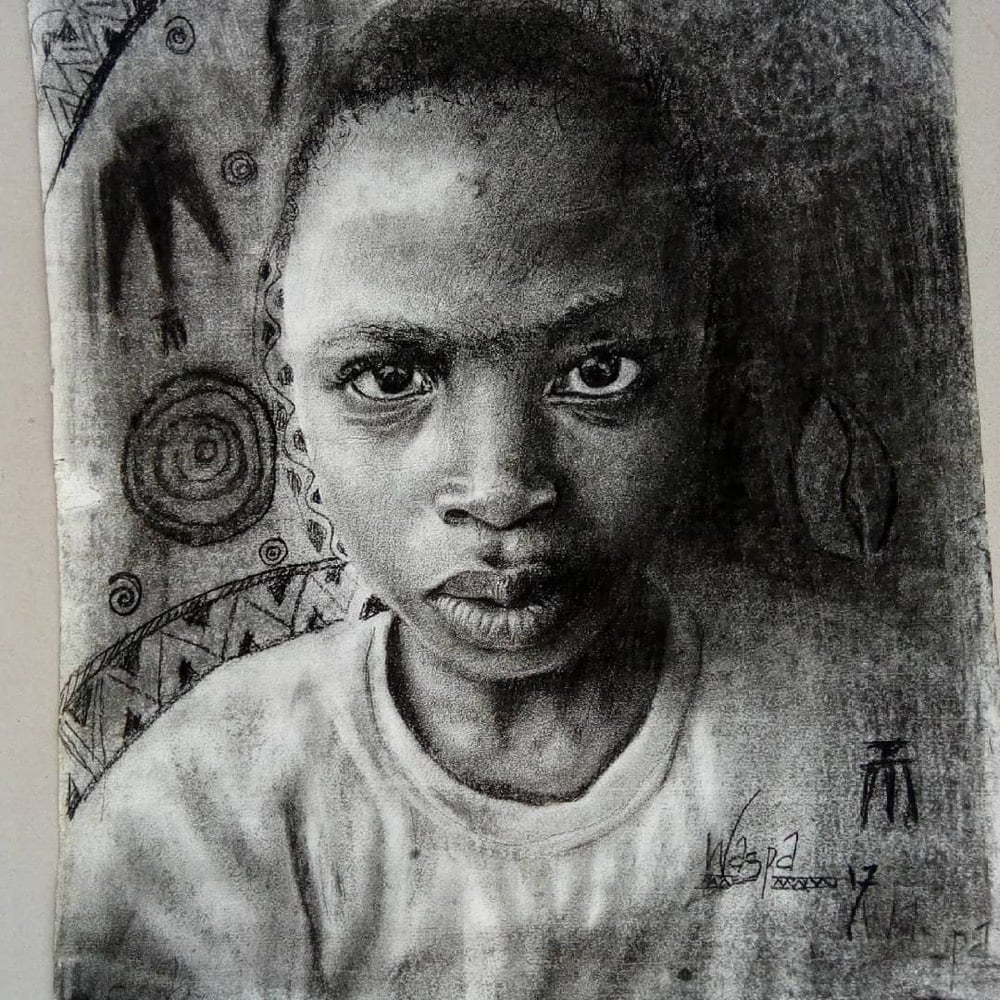

Olamilekan, who goes by Waspa on Instagram, is inspired by Michelangelo and fellow Nigeria artist Arinze Stanley Egbengwu and is a full-on prodigy in my book. BBC recently did a one-minute video look at Olamilekan’s work:
Which came first, bread or farming?
Based on the available archaeological evidence, researchers had assumed that bread and agriculture developed around the same time. But a recent find in Jordan of a 14,500-year-old flatbread indicates that bread was first made some 4000 years before agriculture was invented.
No matter how you slice it, the discovery detailed on Monday shows that hunter-gatherers in the Eastern Mediterranean achieved the cultural milestone of bread-making far earlier than previously known, more than 4,000 years before plant cultivation took root.
The flatbread, likely unleavened and somewhat resembling pita bread, was fashioned from wild cereals such as barley, einkorn or oats, as well as tubers from an aquatic papyrus relative, that had been ground into flour.
And now researchers are wondering, did the invention of bread drive the invention agriculture?
“We now have to assess whether there was a relationship between bread production and the origins of agriculture,” Arranz-Otaegui said. “It is possible that bread may have provided an incentive for people to take up plant cultivation and farming, if it became a desirable or much-sought-after food.”
University of Copenhagen archeologist and study co-author Tobias Richter pointed to the nutritional implications of adding bread to the diet. “Bread provides us with an important source of carbohydrates and nutrients, including B vitamins, iron and magnesium, as well as fibre,” Richter said.
Some Reflections on My Roadtrip Across the Western United States
Last week, I stood in the middle of the caldera of a supervolcano, walked on rocks billions of years old, and traveled back in time simply by driving down a mountain. I looked a bison in the eye at five yards. I witnessed the final resting place of a 12 million-year-old fossilized horse buried in volcanic ash. I saw a rainbow emerging from a mighty thundercloud — powerful with a little bit of tender. I talked civilly with red hatters in red states and found some common ground at least. I drove across the western United States, from Iowa to Oregon, over the course of 10 days. Here is some of what I saw and learned.
Biggest surprise of the trip, part 1: The Bighorn Mountains and The Bighorn National Forest. I had planned to just drive though, up and over, on my way to Yellowstone, but I ended up stopping here for quite a while. The Bighorns aren’t as spectacular as Yellowstone or some of the other parks, but it’s a hell of a lot less crowded. I’d go back and spend a few days here easy.
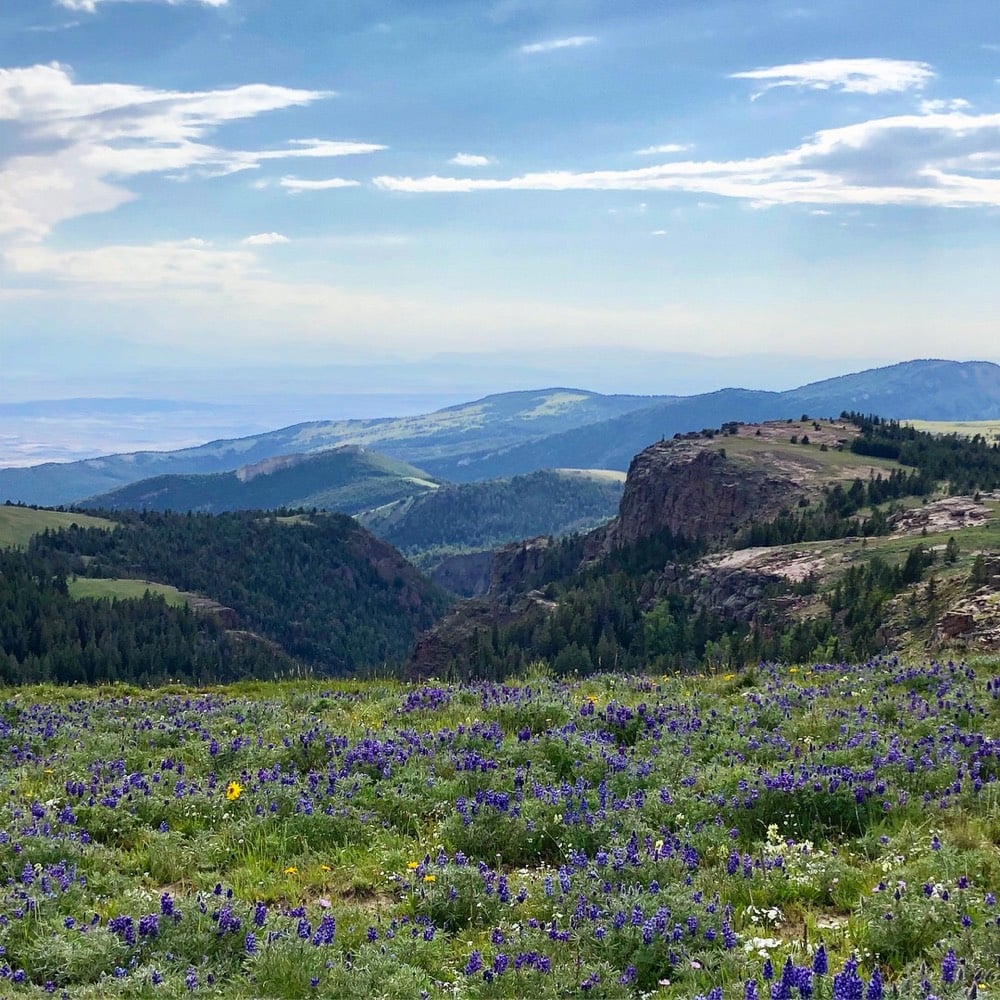
Surprisingly, despite spending 57 hours in the car, I was not bored a single minute of my trip. I marveled at the landscape, played music, and thought. I thought a lot. I expected to listen to a bunch of audiobooks but only managed to finish one I was most of the way through and the first third of another…the landscape was just too distracting most of the time. My experience leads me to believe I might be a good candidate for a solo Mars mission (aside from the one-way thing).
Animals seen on my trip, a partial list: rabbits, prairie dogs, antelope, ducks, geese, pelicans, pheasants, a moose, a wolf, elk, bison, deer, and a bunch of birds I couldn’t identify. The prairie dogs sat near their holes peeping at each other…it was really cute. The moose was a juvenile male in Yellowstone who looked lost & confused; he trotted alongside the road for a bit, then swam across the river and took off into the woods. I was apprehensive about not seeing a bison on my trip, but I shouldn’t have worried…Yellowstone was lousy with ‘em. Pro tip: bring a good pair of binoculars, possibly left over from eclipse-watching.
Yellowstone was one of the highlights (with a caveat that I’ll get to in a second). A single park containing all these different landscapes, from volcanic wastelands to mountain peaks to verdant river valleys to evergreen forests to grasslands…it’s a geographic marvel. But here’s the but: it’s also really crowded in the summer. At times, it felt like a nature mall, with herds of consumers moving from the bison shop to the geyser store. Reminded me a bit of my experience at the Louvre, itself a wonderful place too crowded to enjoy.
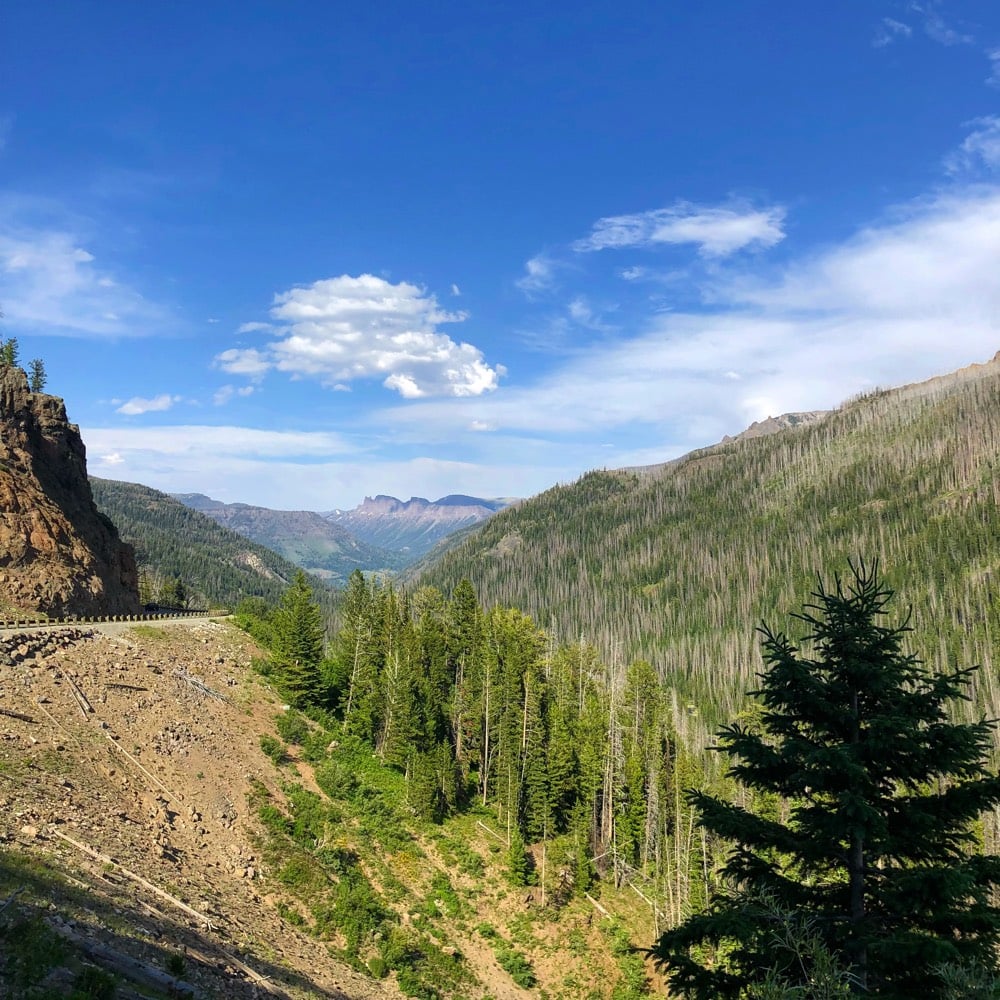
Final roadtrip stats: 2748 miles driven in 10 days and a total of 57 hours in the car. 718 photos and videos taken. I visited seven states — Iowa, Nebraska, South Dakota, Wyoming, Montana, Idaho, and Oregon — and spent at least one night in each save Idaho. Lowest point: 810’. Highest point: 11,070’.
Somewhere west of the Missouri River, which separates Iowa & Missouri from Nebraska & Kansas, the dominance in the eastern US of human activity & organization gives way to geology and geography. Even in the sparser areas of the Midwest, you look down from an airplane and see the Jefferson grid: square parcels of land, each with a group of buildings contained somewhere within it. Further west, hills and mountains and volcanoes and rivers and streams and forests and plains dominate the landscape and how people move within it. The West is not yet tamed, not by a long shot, and acknowledging this goes a long way toward understanding the people who live here.
Biggest surprise of the trip, part 2: High altitude wildflower meadows. When I stopped my car at a scenic overlook at 9400’ in the Bighorn Mountains and saw a path down a gentle slope through a meadow of wildflowers growing very close to the ground, I didn’t think a whole lot about it. Pretty scene, right? I grabbed my daypack from the car and as soon as I stepped down onto the path and into the meadow, this amazing smell sent me reeling. For 20 minutes, I walked in an olfactory daze to the crest of the next hill and back. OMG, what an amazing sensation…a definite high-water mark.
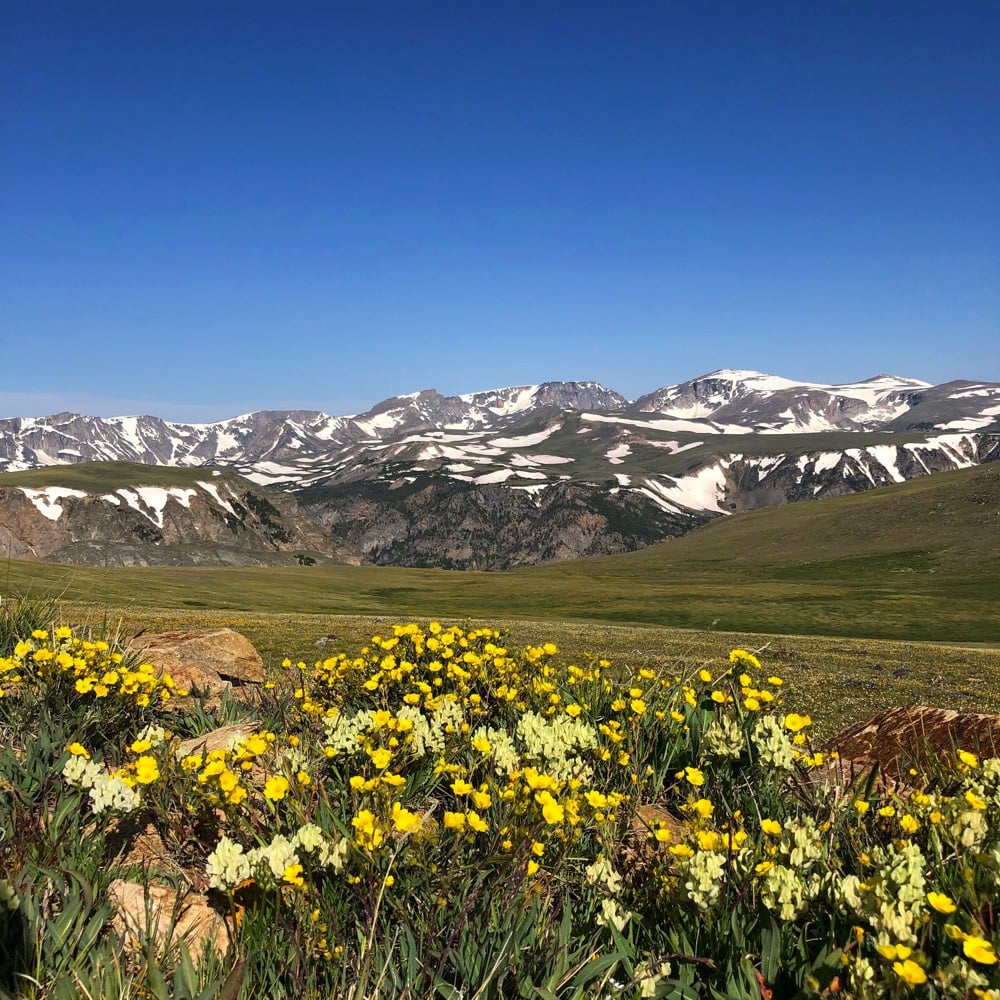
The speed limit on the freeways in South Dakota, Wyoming, Montana, and Idaho was 80 mph. On some rural undivided two-lane highways, the limit was still 70 mph, which I found astounding. But the lanes and the shoulders were way wider than in Vermont, the roads flatter and straighter, and traffic was few and far between most of the time. Still, even just that little extra speed really cuts down on drivers’ potential reaction times.
I had high hopes for the Badlands, and it lived up to the hype. Magnificent desolation, accessible, and not super crowded. I could (and probably should) have spent a couple of days there easy.
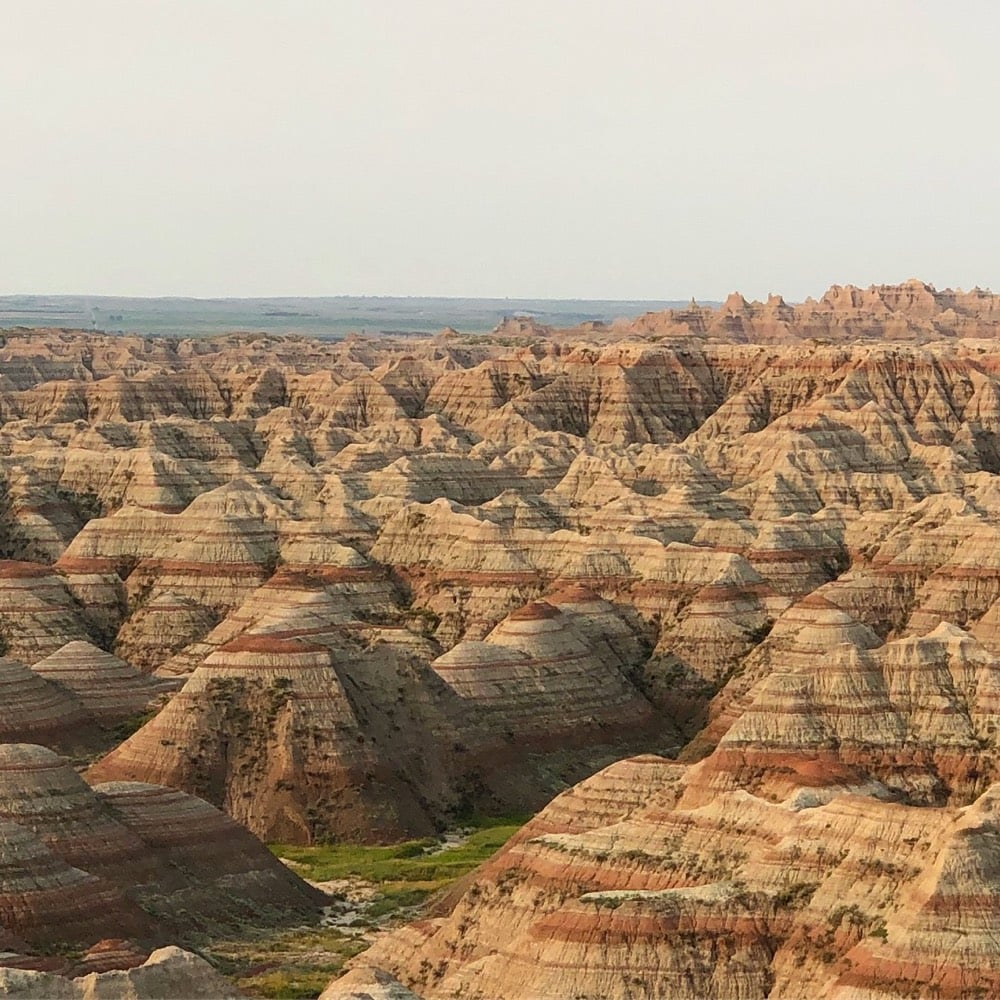
Food was not a highlight or a focus of this trip, mostly because I didn’t spend a tremendous amount of time seeking out good places to eat. I had some Thai lettuce wraps w/ bison in SD that were pretty good, some just-fine sushi in Missoula, and a delicious tostada scramble in Rhododendron, OR. Maybe the best thing I ate was a homemade breakfast burrito I bought at a gas station in Red Lodge, Montana. It was a struggle to find non-meat things to eat — I’m not a vegetarian, but man cannot subsist on burgers & hot dogs & steaks & BBQ for a week and a half w/o GI discomfort. With some notable exceptions, food in the US is more homogenous than ever…you can get anything almost anywhere.
Biggest surprise of the trip, part 3: The hosts at the B&B I stayed at in Wyoming advised me to enter Yellowstone via the Beartooth Highway and I am so glad I took their advice. The 68-mile drive was called “the most beautiful drive in America” by former CBS correspondant Charles Kuralt and he might be right. At the top of the pass, you drive just short of 11,000’ above sea level; I climbed above the 11K mark for a stunning 360° view of the entire area. Reader, I may have done the arms-wide-on-the-bow-of-the-Titanic gesture on top of a rock at the top of the world…no apologies.
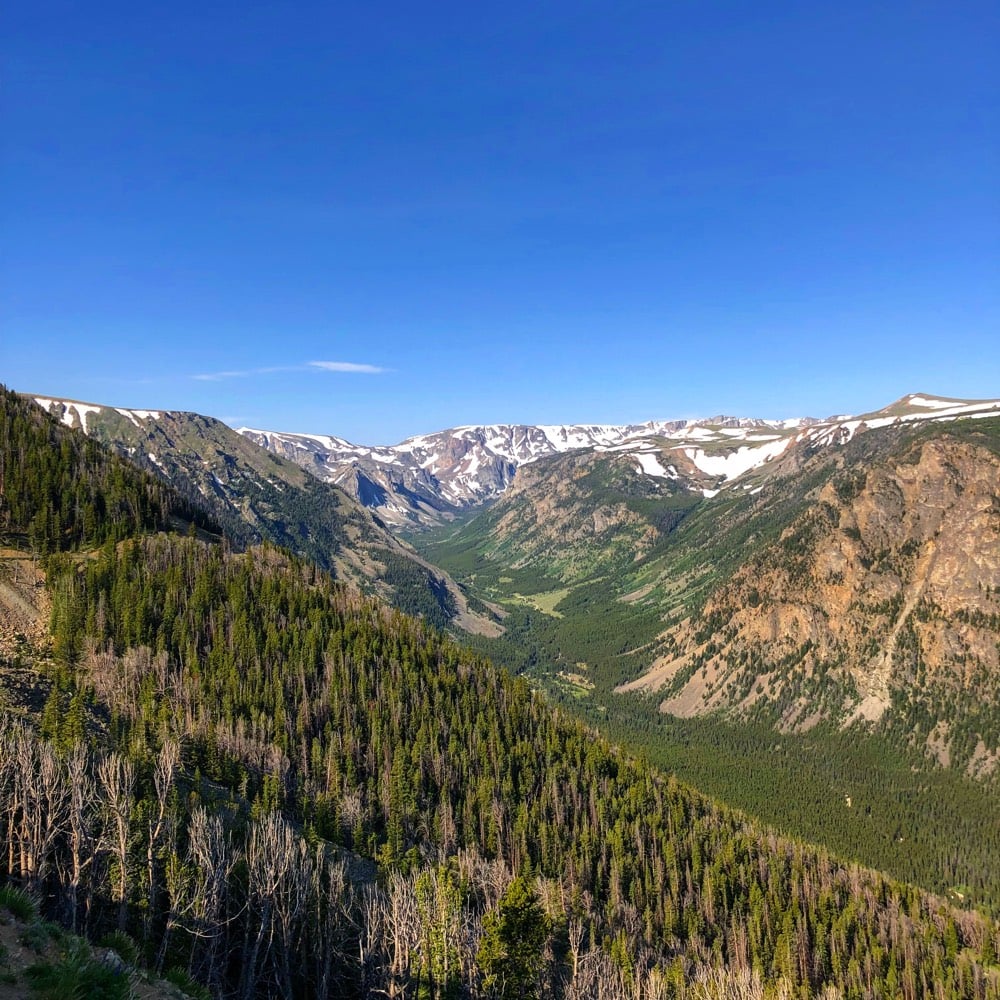
About 5 minutes after I checked into my B&B near Cody, WY, I looked out my window to see a rain cloud off in the distance with a rainbow coming out of it. Chuckling, I asked my host if that was a common occurence around here. “Pretty much,” he replied, “especially with climate change.” A life-long resident of the area, he went on to explain that it rains a lot more there now than “20-30 years ago”. “See all that grass out there? It’s supposed to be brown this time of year.”
Several people told me before my trip that Devils Tower was worth the effort, but as I spotted it off in the distance on my approach, I had my doubts. But as it got closer, I realized they’d all been right. Totally crazy geological thing worth seeing in the flesh.
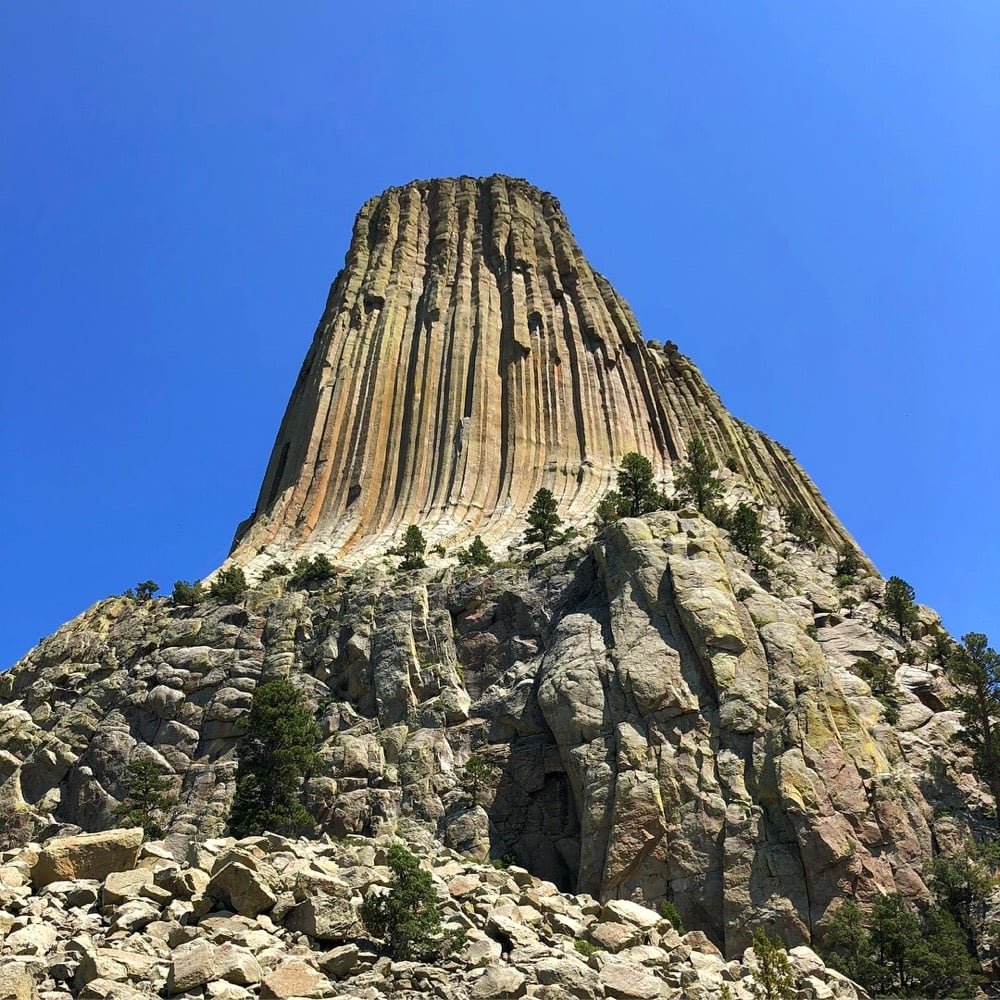
At a gas station in southern South Dakota, a man noticed the Texas plates on my rental car and asked, “What’s the price of gas in Texas these days?” I explained my situation, and he said, “I’m from Texas originally and I can tell by your accent that you ain’t. What’re ya doing in this godforsaken country?”
In Wyoming, I stayed less than a mile from the Heart Mountain Relocation Center, a WWII Japanese American confinement site. From 1942 to 1945, this concentration camp held almost 14,000 people, making it the third-largest town in Wyoming at the time. The majority were American citizens and had done nothing wrong and committed no crimes…they were put there for being of Japanese heritage. I regret that my plans didn’t allow for a visit; if I’d had known beforehand that it was going to be so close, I would have made the time, given our present administration’s treatment of its Muslim citizens and asylum seekers from Central and South America. As Faulkner said, “The past is never dead. It’s not even past.”
I saw some cool thunderstorms:
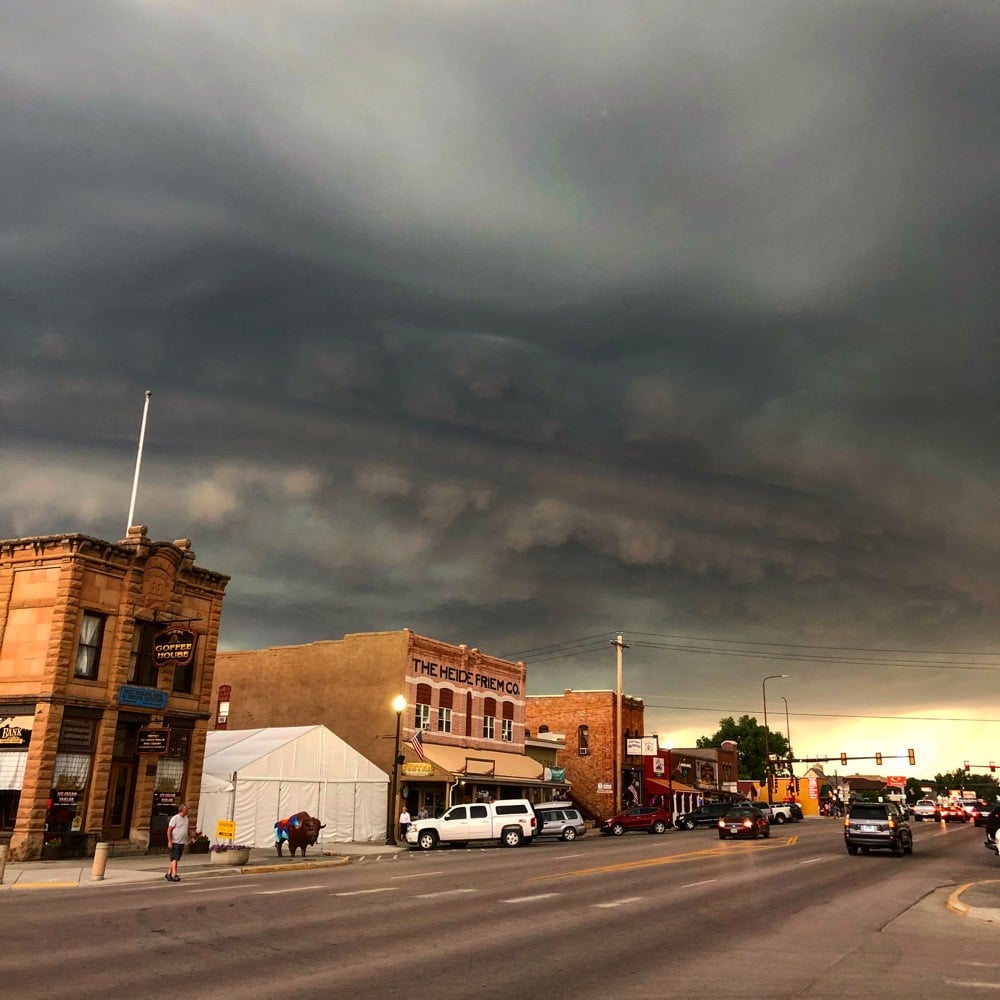
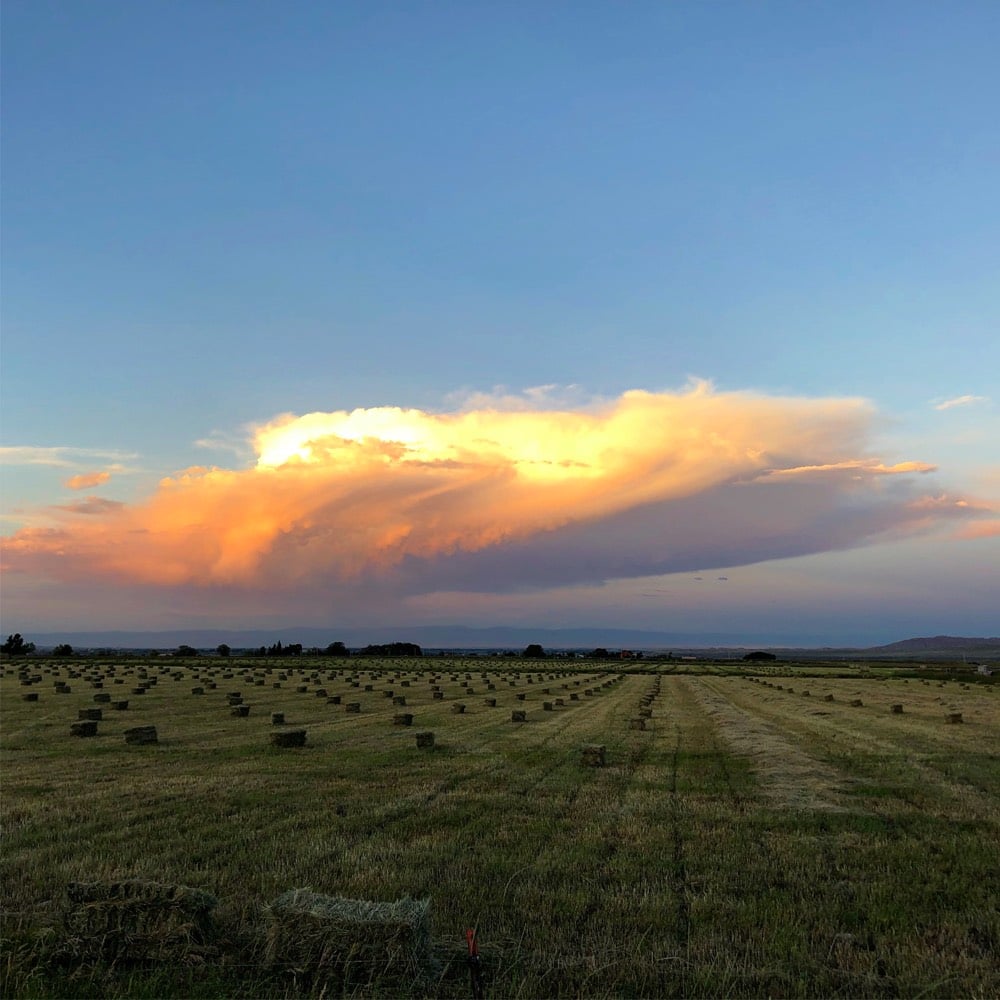
If I had a time machine, I would tell myself from two weeks ago to skip Mt Rushmore, Wind Cave, and the volcanic stuff in Yellowstone. And perhaps Wall Drug. I also would have opted to fly out of Salt Lake City instead of Portland, OR to give me more time to explore Montana and Wyoming…the trip ended up having too much driving and not enough being out in nature.
You can see more photos from my trip on Instagram and in this saved Instagram Story. I feel very lucky to have had the time and resources to take this trip. It definitely took me out of my comfort zone in both good ways and bad — the journey definitely wasn’t all sunshine and lollipops, despite what my photos might indicate. To many of us, it seems like a perilous time in our nation’s history, with many debts, old and new, coming due in rapid-fire succession. Doing this roadtrip reminded me of many great things about this country & the people who live in it and gave me the time & space to ponder how I fit into the puzzle, without the din of the news and social media. If you can manage it, I encourage you all to do the same, even if it’s just visiting someplace close that you’ve never been to: get out there and see the world and visit with its people. This world is all we have, and the more we see of it, the better we can make it.
Open offices result in less collaboration among employees
In a recent study called The impact of the ‘open’ workspace on human collaboration, a pair of researchers tracked the digital and real life interactions of workers at a company that shifted to an open office plan before and after the shift. Here were the two key findings of the study:
Contrary to what’s predicted by the sociological literature, the 52 participants studied spent 72% less time interacting face-to-face after the shift to an open office layout. To make these numbers concrete: In the 15 days before the office redesign, participants accumulated an average of around 5.8 hours of face-to-face interaction per person per day. After the switch to the open layout, the same participants dropped to around 1.7 hours of face-to-face interaction per day.
At the same time, the shift to an open office significantly increased digital communication. After the redesign, participants sent 56% more emails (and were cc’d 41% more times), and the number of IM messages sent increased by 67%.
That’s a pretty dramatic shift…and productivity suffered. The authors theorized that the lack of physical boundaries in the open office made constructing social barriers necessary.
Like social insects which swarm within functionally-determined zones ‘partitioned’ by spatial boundaries (e.g. hives, nests or schools), human beings — despite their greater cognitive abilities — may also require boundaries to constrain their interactions, thereby reducing the potential for overload, distraction, bias, myopia and other symptoms of bounded rationality.
This jibes with my experience working in open offices. For almost 10 years, I worked in an open office plan at Buzzfeed. In the beginning, when there were just a few of us, the level of IRL interaction was high. But as the number of people in the office increased past a certain point, people spent more and more time at their desks, headphones on, ignoring everything but their screens. And yet companies keep doubling down on this…
2018 Amazon Prime Day deals
It’s Prime Day! Or is it tomorrow? Prime Day, a holiday invented by Amazon to sell stuff in the lull between Memorial Day and Labor Day, now stretches a full 36 hours, so…Happy Prime Day And A Half? Doesn’t quite roll off the tongue. Anyway, if you are an Amazon Prime member (or want to sign up for a 30-trial), there are some good deals to be had if your life doesn’t have enough stuff in it.
- The Kindle Paperwhite, the device on which I read almost all of my books, is on sale for only $80. The regular Kindle is just $50.
- This 50-inch 4K TV with built-in Fire TV (voice control via Alexa & access to Netflix, Prime Video, Hulu, HBO, etc. w/ subscriptions) is an absurd $290. I wish the economics of healthcare worked like that of consumer electronics…having a baby would cost about $5.
- The Echo, Amazon’s flagship wifi speaker w/ voice control via Alexa, is $70 while the smaller Echo Dot is just $30.
- The Anova sous vide cooker is $109 (45% off). I’ve been using my Anova more and more over the past few months and it’s really upped my game. The last round of steaks I cooked (and then finished on the grill) were right up there with any I’ve had at a restaurant.
- Whoa, this littleBits kit is only $40 (60% off). My kids love their littleBits sets.
- Hold the phone! One of my favorite items on Amazon that shows up on my gift guide each year, the 55-gallon drum of personal lubricant (a bargain at $1,468.80), has some competition all of a sudden. This 55-gallon drum of lube is only $475 while this one is even cheaper…only $378. When is Wirecutter going to issue a buy recommendation in this critical category?!
Maybe I’ll add some more deals later…or you can check here yourself in the meantime.
Update: Some more deals:
- The 6-quart Instant Pot is only $60.
- If you buy a $25 gift card, you get $5 extra when using the code “GCPRIME18”.
- 4TB external hard drive for $80. 4TB was probably more than the total amount of hard drive storage in every single computer when I was a kid.
- Want to start a podcast? The Yeti is a great microphone on sale for $90.
- I just bought this electric toothbrush…$30 w/ coupon.
P.S. You may also wish to know that Amazon workers in Europe are on strike today, protesting poor working conditions.
Amazon workers primarily in German, Poland, and Spain are participating, with union representatives alleging Amazon has been working to freeze salaries, reduce medical leave pay rates, and strip other rights from its warehouse workforce.
The geography of the US is weirder than you think
Americans generally have a skewed view of their country’s place in the world, both metaphorically and geographically speaking. For instance, the US state closest to Africa is… Maine? And Minneapolis is as far north as Venice, Italy.
They didn’t cover my favorite US geographical oddity though: what’s the northernmost state in the contiguous 48 states? Unless you know it by rote, the answer will probably be surprising to you.
Tenements, Towers & Trash: An Unconventional Illustrated History of New York City
I really like these drawings of NYC with a historical bent by illustrator and “amateur historian” Julia Wertz.
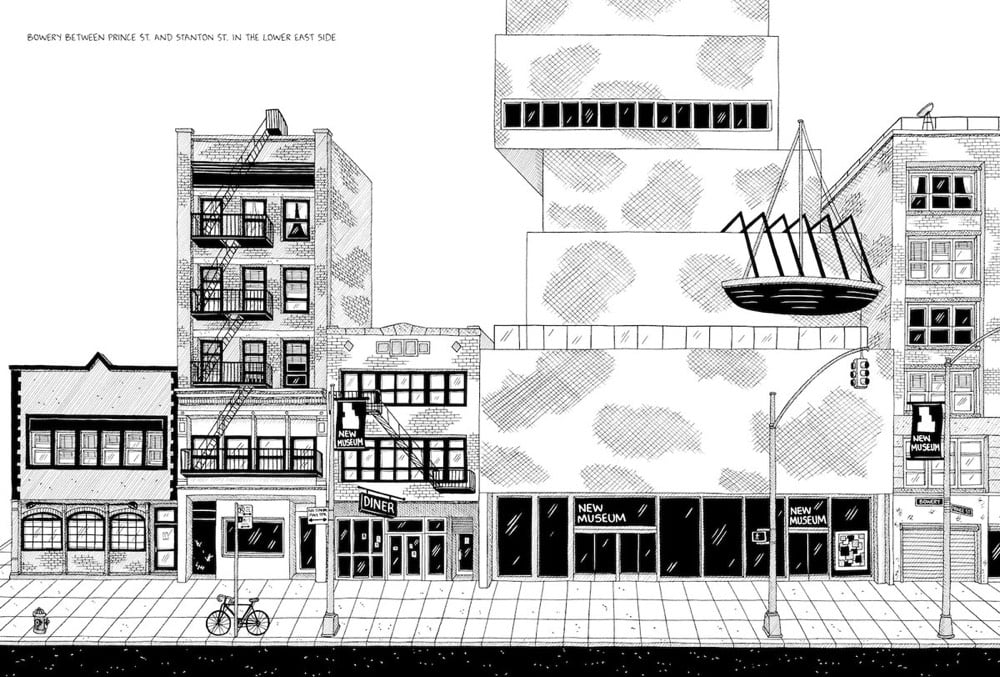
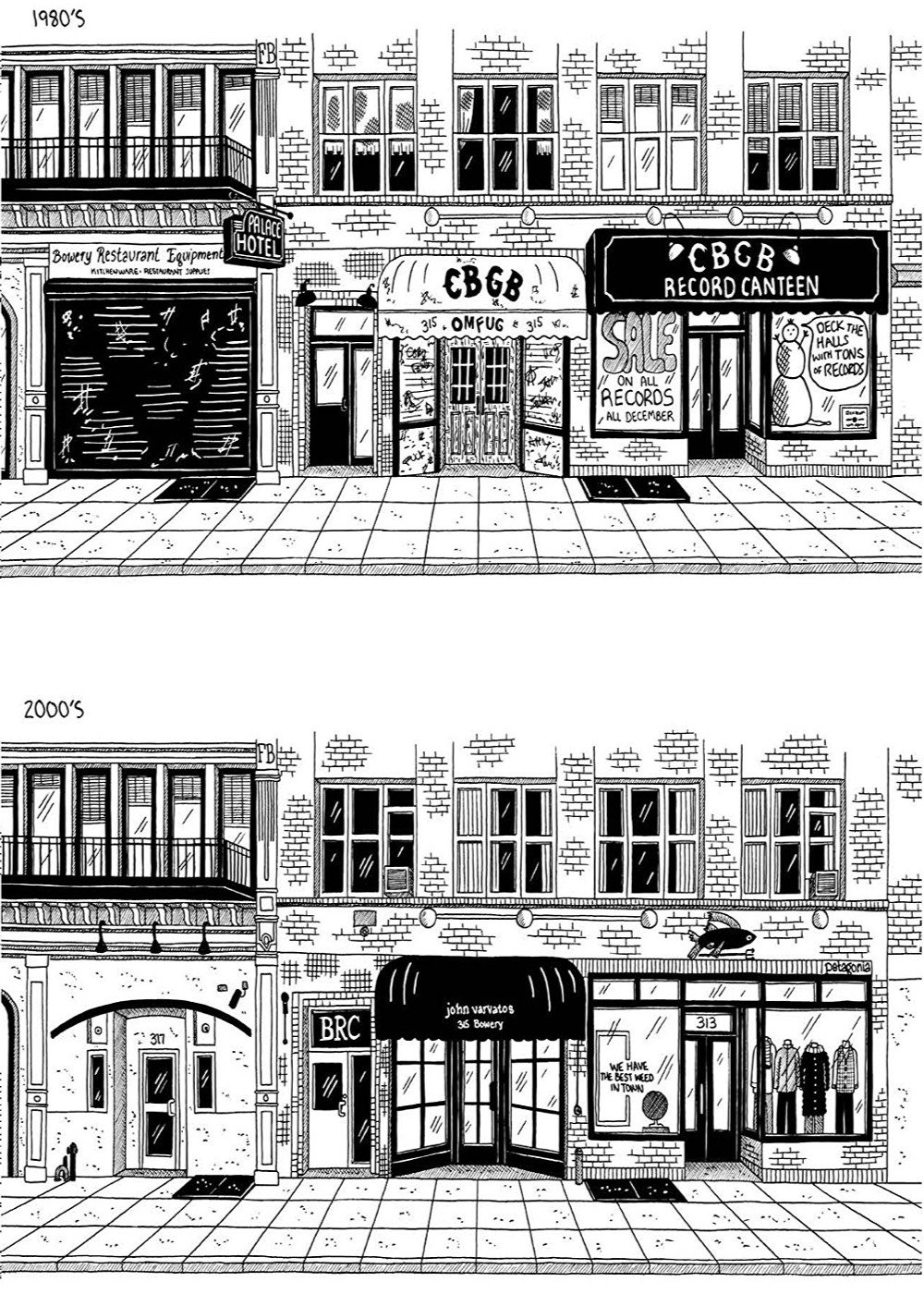
They’re from a book Wertz wrote & illustrated called Tenements, Towers & Trash: An Unconventional Illustrated History of New York City. Gothamist recently interviewed Wertz about the book and her work.
Q: Bob Dylan (and my boss, Jake Dobkin) both like to exclaim that “nostalgia is death.” Which probably says more about them, and their own particularly complex relationships with nostalgia, than anything else. But do you think of yourself as a nostalgic person? How does nostalgia play into your appreciation of the urban landscape?
A: I understand what people mean by that expression, but it categorizes nostalgia in too simple a way. Nostalgia is like an intoxicant — in moderation it can be a rewarding experience, but if abused/overused, it becomes toxic. To indulge in nostalgia is to romanticize the past and stop living in the present. This could be totally fine for short periods of time, just a nice way to remember a pleasant time you experienced, but if it becomes a way of thinking, it ruins the present because there’s no way the present moment can compare to a fabricated, romanticized version past. Nostalgia has a way of erasing the shitty parts of reality. Like when people are nostalgic for, say, NYC in the 1800’s — the horse and buggies, the handmade shop signs, the elaborate suits and dresses — they’re forgetting (or perhaps never knew) that the city then was a filthy cesspool of trash and sewage, disease was rampant, and the clothing was insufferably hot and restrictive, and sometimes even deadly for women cooking with open flame.
Wes Anderson & Juman Malouf are curating an exhibition at the Kunsthistorisches Museum in Vienna called “The Spitzmaus Mummy in a Coffin and Other Treasures”. Opens in November.
Michael Ian Black on why cruises are cool. “For the cost of a good hotel room, you get a mostly-all-inclusive break from our whirling hyper-culture.”
I really liked season 2 of The Handmaid’s Tale, but this criticism has merit. “This isn’t a feminist rallying cry or a cathartic airing of grievances, it’s just a fandom.”
“I Know What Incarceration Does to Families. It Happened to Mine.” Michiko Kakutani on her family’s imprisonment in a WWII Japanese internment camp.
Kylie Jenner started a cosmetics company two years ago that’s worth nearly $800 million now (based on revenues). She’s 20 years old & owns 100% of the company.
Barack Obama’s 2018 Summer Reading List
President Obama is heading to Africa this week for the first time since he left office. In preparation, he shared a recommended summer reading list that’s heavy on African authors. Here’s the full list:
Things Fall Apart by Chinua Achebe
A true classic of world literature, this novel paints a picture of traditional society wrestling with the arrival of foreign influence, from Christian missionaries to British colonialism. A masterpiece that has inspired generations of writers in Nigeria, across Africa, and around the world.A Grain of Wheat by Ngugi wa Thiong’o
A chronicle of the events leading up to Kenya’s independence, and a compelling story of how the transformative events of history weigh on individual lives and relationships.Long Walk to Freedom by Nelson Mandela
Mandela’s life was one of the epic stories of the 20th century. This definitive memoir traces the arc of his life from a small village, to his years as a revolutionary, to his long imprisonment, and ultimately his ascension to unifying President, leader, and global icon. Essential reading for anyone who wants to understand history — and then go out and change it.Americanah by Chimamanda Ngozi Adichie
From one of the world’s great contemporary writers comes the story of two Nigerians making their way in the U.S. and the UK, raising universal questions of race and belonging, the overseas experience for the African diaspora, and the search for identity and a home.The Return by Hisham Matar
A beautifully-written memoir that skillfully balances a graceful guide through Libya’s recent history with the author’s dogged quest to find his father who disappeared in Gaddafi’s prisons.The World As It Is by Ben Rhodes
It’s true, Ben does not have African blood running through his veins. But few others so closely see the world through my eyes like he can. Ben’s one of the few who’ve been with me since that first presidential campaign. His memoir is one of the smartest reflections I’ve seen as to how we approached foreign policy, and one of the most compelling stories I’ve seen about what it’s actually like to serve the American people for eight years in the White House.
One of the books on my summer reading list is The Book of Forgiving: The Fourfold Path for Healing Ourselves and Our World by Desmond Tutu & Mpho Tutu, recommended to me by a reader a few months ago.
Each of us has a deep need to forgive and to be forgiven. After much reflection on the process of forgiveness, Tutu has seen that there are four important steps to healing: Admitting the wrong and acknowledging the harm; Telling one’s story and witnessing the anguish; Asking for forgiveness and granting forgiveness; and renewing or releasing the relationship. Forgiveness is hard work. Sometimes it even feels like an impossible task. But it is only through walking this fourfold path that Tutu says we can free ourselves of the endless and unyielding cycle of pain and retribution.
Making Amazon Alexa respond to sign language using AI
Using a JavaScript machine learning package called TensorFlow.js, Abhishek Singh built a program that learned how to translate sign language into verbal speech that an Amazon Alexa can understand. “If voice is the future of computing,” he signs, “what about those who cannot [hear and speak]?”
See also how AirPods + the new Live Listen feature “could revolutionize what it means to be hard of hearing”.
How Trajan became the go-to typeface for movie posters
In the early 90s, a digital typeface designed in the 80s — but based on the letterforms used in a Roman column completed in 113 AD — became the go-to typeface for movie poster designers. (Reminder: everything is a remix.) It was used on posters for movies like The Bodyguard, Crouching Tiger Hidden Dragon, Children of Men, and Quiz Show. This Vox video details the rise of the Trajan typeface in movie poster design and why its not used that often by big movies anymore.
The original Mac OS Control Panel done in cross-stitch

iOS programmer Glenda Adams made a cross-stitch embroidery of the original Control Panel for the Macintosh. Lots of parallels between designing cross-stitch patterns and pixel drawings & fonts. For instance, check out designer Susan Kare’s drawings for some of the original Mac OS icons and compare them to cross-stitch patterns. (P.S. Check out that date…)
See also this Lego Macintosh.
Manually pixelated food


Art director Yuni Yoshida has created these pixelated food photos by manually cutting up the foods in question into little cubes. Love these.
See also censored fruit.
Winners of National Geographic Travel Photographer of the Year competition for 2018


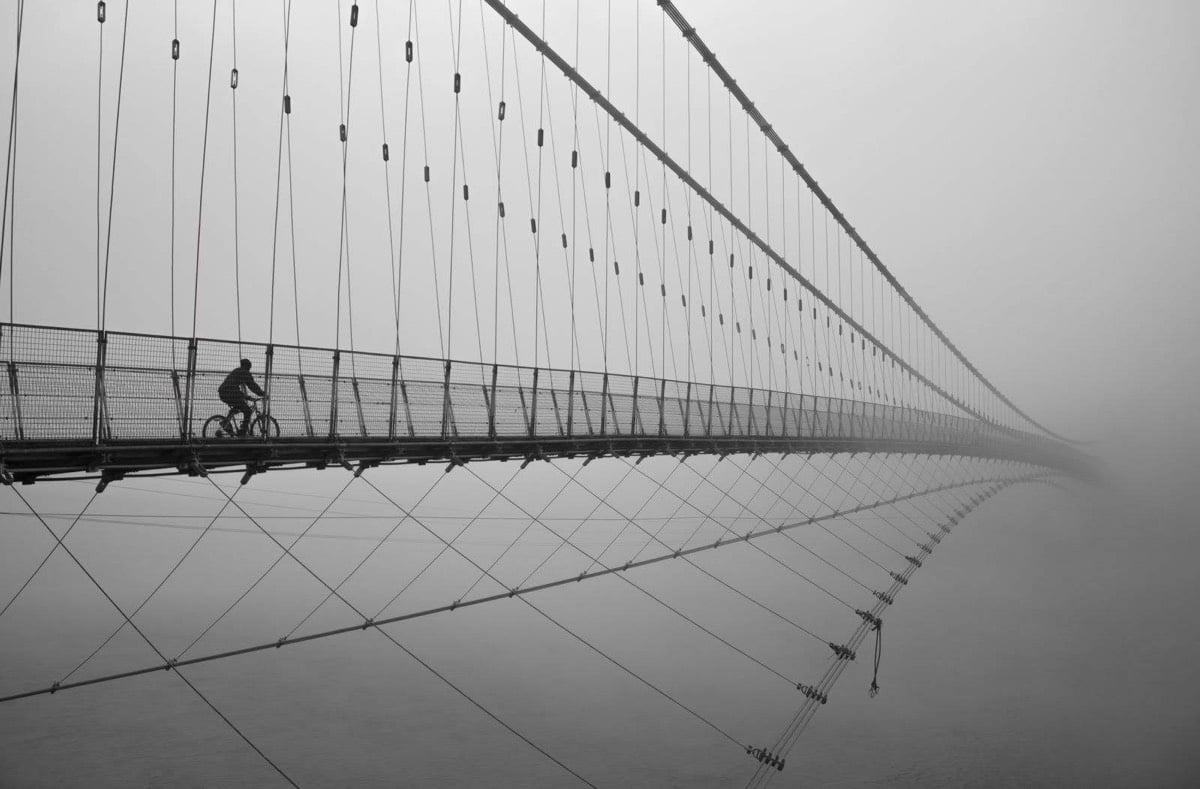
National Geographic recently announced the winners of the Travel Photographer of the Year contest for 2018. You can look at the winners here and the people’s choice awards here.
You can also download the winning images as wallpaper for your computer, phone, or tablet.
The US national anthem is terrible (unless it’s sung by Whitney Houston). “No one with a normal esophagus can sing it without screaming.”
A movie adaptation of Sapiens is coming
Ridley Scott and Asif Kapadia are working on a film adaptation of Yuval Noah Harari’s Sapiens: A Brief History of Humankind. Scott (Blade Runner, Gladiator, Alien) is producing while Kapadia (the excellent documentaries Amy & Senna) will direct. Harari, you’ll recall, is a Prophet and states in Sapiens that the Agricultural Revolution is “history’s biggest fraud”.
Rather than heralding a new era of easy living, the Agricultural Revolution left farmers with lives generally more difficult and less satisfying than those of foragers. Hunter-gatherers spent their time in more stimulating and varied ways, and were less in danger of starvation and disease. The Agricultural Revolution certainly enlarged the sum total of food at the disposal of humankind, but the extra food did not translate into a better diet or more leisure. Rather, it translated into population explosions and pampered elites. The average farmer worked harder than the average forager, and got a worse diet in return. The Agricultural Revolution was history’s biggest fraud.
At any given time in their lives, people have two dozen regular haunts. It’s like a Dunbar number for places rather than people.
Headline of the year? “How Noisy Males Control the Gnu’s Cycle”
Some great commentary about the meaning of the movie Casablanca. “Casablanca came out in 1942 … Real refugees from the Nazis, afraid for their lives, watched this movie and took heart.”
Shade: A Tale of Two Presidents

Pete Souza spent 8 years photographing President Obama as the official White House photographer. Souza compiled some of the best of those photos (including the ones with kids) into a book, Obama: An Intimate Portrait. Since Trump took office in January 2017, Souza has used his Instagram account to post photos of Obama in response to Trump’s actions — for instance, when Trump initiated the travel ban against Muslim nations, Souza posted a photo of Obama meeting with a refugee girl.
Souza has collected all of that shade into another book of Presidential photos: Shade: A Tale of Two Presidents.
Shade is a portrait in Presidential contrasts, telling the tale of the Obama and Trump administrations through a series of visual juxtapositions. Here, more than one hundred of Souza’s unforgettable images of President Obama deliver new power and meaning when framed by the tweets, news headlines, and quotes that defined the first 500 days of the Trump White House.
The book comes out in October, but you can preorder it now from Amazon.
The story of the last survivor of the Atlantic slave trade
In the late 1920s & early 1930s, African-American writer Zora Neale Hurston interviewed an Alabama man named Cudjo Lewis about his life. Lewis was the last survivor of the last slave ship to arrive in America in 1860, decades after the international slave trade had been made illegal in the US. Hurston attempted to publish Lewis’ story as a book, but her extensive use of Lewis’ “unique vernacular” kept publishers away. Last month, Barracoon: The Story of the Last “Black Cargo” was finally published.
In 1927, Zora Neale Hurston went to Plateau, Alabama, just outside Mobile, to interview eighty-six-year-old Cudjo Lewis. Of the millions of men, women, and children transported from Africa to America as slaves, Cudjo was then the only person alive to tell the story of this integral part of the nation’s history. Hurston was there to record Cudjo’s firsthand account of the raid that led to his capture and bondage fifty years after the Atlantic slave trade was outlawed in the United States.
In 1931, Hurston returned to Plateau, the African-centric community three miles from Mobile founded by Cudjo and other former slaves from his ship. Spending more than three months there, she talked in depth with Cudjo about the details of his life. During those weeks, the young writer and the elderly formerly enslaved man ate peaches and watermelon that grew in the backyard and talked about Cudjo’s past-memories from his childhood in Africa, the horrors of being captured and held in a barracoon for selection by American slavers, the harrowing experience of the Middle Passage packed with more than 100 other souls aboard the Clotilda, and the years he spent in slavery until the end of the Civil War.
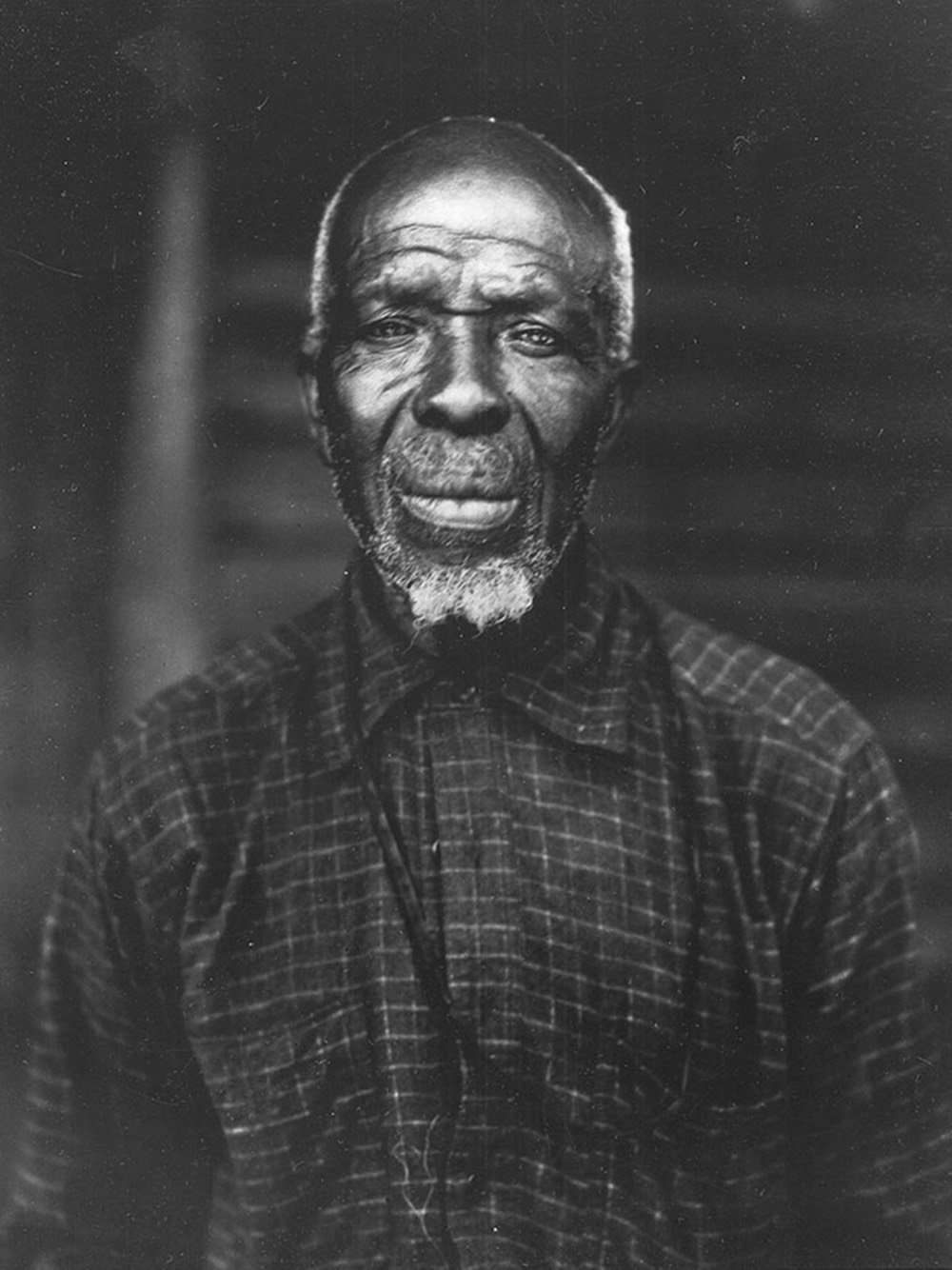
Vulture has an excerpt of the book.
De King of Dahomey, you know, he got very rich ketchin slaves. He keep his army all de time making raids to grabee people to sell. One traitor from Takkoi (Cudjo’s village), he a very bad man and he go straight in de Dahomey and say to de king, “I show you how to takee Takkoi.” He tellee dem de secret of de gates. (The town had eight gates, intended to provide various escape routes in the event of an attack.)
Derefore, dey come make war, but we doan know dey come fight us. Dey march all night long and we in de bed sleep. It bout daybreak when de people of Dahomey breakee de Great Gate. I not woke yet. I hear de yell from de soldiers while dey choppee de gate. Derefore I jump out de bed and lookee. I see de great many soldiers wid French gun in de hand and de big knife. Dey got de women soldiers too and dey run wid de big knife and dey ketch people and saw de neck wid de knife den dey twist de head so it come off de neck. Oh Lor’, Lor’! I see de people gittee kill so fast!
There’s an audiobook version as well…I bet it’s amazing to listen to.
The meaning of the ending of 2001 according to Stanley Kubrick
Few directors allowed their movies to speak for themselves more than Stanley Kubrick. Still, when it came to 2001: A Space Odyssey and its mysterious ending, he did attempt to let viewers know what his intention was. In a 1969 interview with Joseph Gelmis, he quickly summed up the entire plot in two paragraphs:
You begin with an artifact left on earth four million years ago by extraterrestrial explorers who observed the behavior of the man-apes of the time and decided to influence their evolutionary progression. Then you have a second artifact buried deep on the lunar surface and programmed to signal word of man’s first baby steps into the universe — a kind of cosmic burglar alarm. And finally there’s a third artifact placed in orbit around Jupiter and waiting for the time when man has reached the outer rim of his own solar system.
When the surviving astronaut, Bowman, ultimately reaches Jupiter, this artifact sweeps him into a force field or star gate that hurls him on a journey through inner and outer space and finally transports him to another part of the galaxy, where he’s placed in a human zoo approximating a hospital terrestrial environment drawn out of his own dreams and imagination. In a timeless state, his life passes from middle age to senescence to death. He is reborn, an enhanced being, a star child, an angel, a superman, if you like, and returns to earth prepared for the next leap forward of man’s evolutionary destiny.
But recently, an audio clip from a never-released Japanese documentary recorded in 1980 surfaced in which the director shares his view of the ending of the film in more detail.
I’ve tried to avoid doing this ever since the picture came out. When you just say the ideas they sound foolish, whereas if they’re dramatized one feels it, but I’ll try.
The idea was supposed to be that he is taken in by god-like entities, creatures of pure energy and intelligence with no shape or form. They put him in what I suppose you could describe as a human zoo to study him, and his whole life passes from that point on in that room. And he has no sense of time. It just seems to happen as it does in the film.
They choose this room, which is a very inaccurate replica of French architecture (deliberately so, inaccurate) because one was suggesting that they had some idea of something that he might think was pretty, but wasn’t quite sure. Just as we’re not quite sure what do in zoos with animals to try to give them what we think is their natural environment.
Anyway, when they get finished with him, as happens in so many myths of all cultures in the world, he is transformed into some kind of super being and sent back to Earth, transformed and made into some sort of superman. We have to only guess what happens when he goes back. It is the pattern of a great deal of mythology, and that is what we were trying to suggest.
So that’s the plot stated plainly, but luckily it takes nothing away from any of the metaphorical meanings that people have ascribed to the film over the past 50 years.
Hallucinatory rollercoaster
Using a 360° GoPro camera, Jeb Corliss films his ride on a roller coaster and, with some help from image stabilization in the editing phase, turns the footage into a trippy Wonka-esque thrill ride.
Give it a sec to get going and watch the whole thing…the really mind-bending stuff starts happening after about 20 seconds. (via digg)
Luminescent fruit
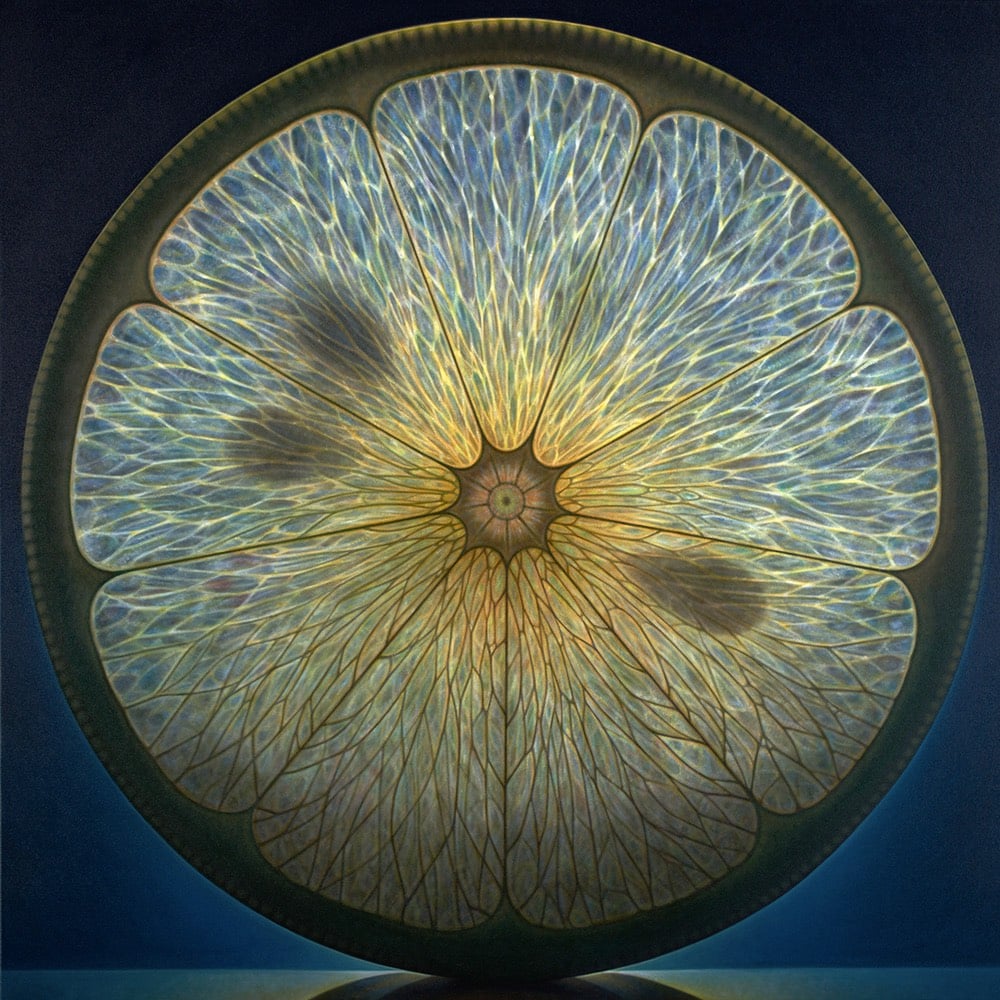

At first, I thought these images by Dennis Wojtkiewicz were photographs of backlit fruit slices, but they’re actually super-realistic paintings four or five feet across. Ok, “super-realistic” is probably not the right description. Under scrutiny, the images are too perfect. Wojtkiewicz refers to his technique as a “heightened approach to realism”, a conscious journey into the uncanny valley.
This Nonsense of Earning a Living
From a 1970 issue of New York magazine, Buckminster Fuller on the massive economic lever of technology:
We must do away with the absolutely specious notion that everybody has to earn a living. It is a fact today that one in ten thousand of us can make a technological breakthrough capable of supporting all the rest. The youth of today are absolutely right in recognizing this nonsense of earning a living. We keep inventing jobs because of this false idea that everybody has to be employed at some kind of drudgery because, according to Malthusian-Darwinian theory, he must justify his right to exist. So we have inspectors of inspectors and people making instruments for inspectors to inspect inspectors. The true business of people should be to go back to school and think about whatever it was they were thinking about before somebody came along and told them they had to earn a living.
That was written almost 50 years ago…the capability of technology to generate wealth has increased greatly since then.
Trump’s Unprecedented Relationship with Fox News
Brian Stelter is known for media scoops, but sometimes, he can bring the insight too. On CNN and in his nightly newsletter, he briefly outlines what I think anyone has to agree is an unusual symbiosis of the Presidency and a single news outlet, Fox News. (Trump hiring Fox News’s Bill Shine to run his communications shop is just one symptom of the bigger entanglement.)
— No president has ever endorsed a network to this degree before: Promoting it, telling people when and where to tune in, while trashing all of its rivals…
— And no network has ever propped up a president quite like this before…
— The back-scratching benefits both sides. Trump benefits from the friendly segments and softball Q’s. Fox benefits from Trump’s preferential treatment and constant promos…
— The beating heart of this relationship is Sean Hannity, who reportedly golfed with Trump on Sunday. Hannity is an adviser, a booster, an attack dog, a friend. No TV host has ever had this kind of alliance with a US president…
— And no president has never treated a TV channel like it’s an intelligence agency the way Trump treats Fox…
My point: This is new. And weird. And we shouldn’t get used to it. There’s been almost a merger between a culture war TV station and a culture war president. In the essay, I asked, rhetorically, “What would Trump do without Fox?”
Is this the weirdest thing about the Trump presidency, or the most dangerous? Probably not. But it’s one of the legs that props up all the other legs. And it’s definitely weird, and I’d argue, dangerous.
How the safety bicycle changed the world
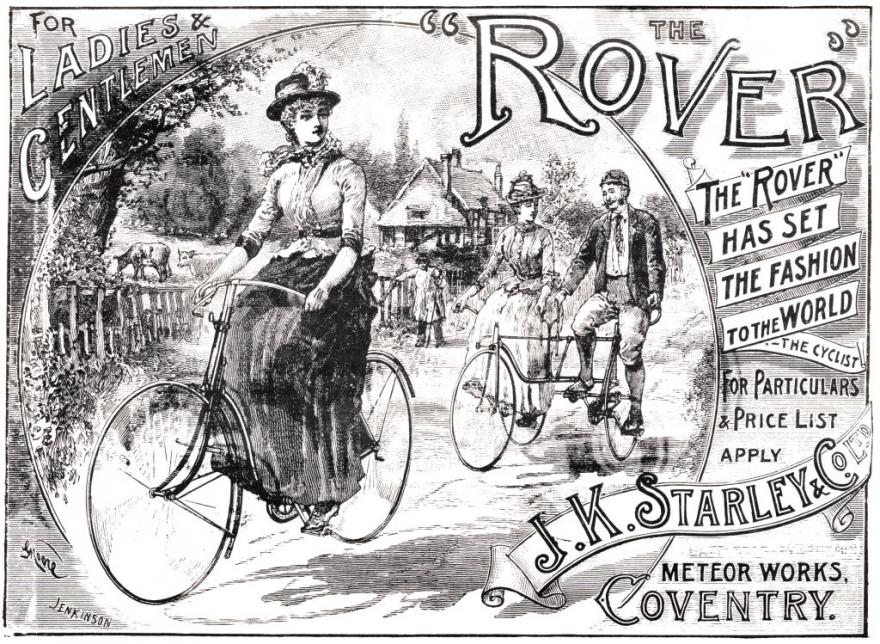
This excerpt from Margaret Guroff’s history The Mechanical Horse focuses on the democratization of the bicycle at the end of the nineteenth century, as new designs made bikes more appealing to businessmen, children, and especially women.
In the 1890s, bikes got lighter as well as more comfortable. The average weight of a bicycle dropped by more than half during the decades first five years, falling from 50 pounds to 23. And since new gearings were able to mimic wheels larger than those of the largest Ordinary, speed records fell too. In 1894, while riding a pneumatic-tired safety around a track in Buffalo, New York, the racer John S. Johnson went a mile in just over one minute and thirty-five seconds, a rate of nearly thirty-eight miles an hour. He beat the previous mile record for a safety by fourteen seconds, and the record for an Ordinary by nearly a minute — and the record for a running horse by one-tenth of a second.
The Ordinary — which had by then acquired the derisive nickname of penny-farthing, after the old British penny and much smaller farthing (quarter-penny) coins — became obsolete. High-wheelers that had sold for $150 to $300 just a year or two earlier were going for as little as $10.
The first safeties, meanwhile, cost an average of $150 during a time when the average worker earned something like $12 a week. At such prices, the new bikes targeted the same upscale demographic as the tricycle. But a strong market for safeties among well-to-do women goosed production, and competition among manufacturers reduced prices, making the bikes affordable to more would-be riders and further fueling demand. In 1895, Americas 300 bicycle companies produced 500,000 safeties at an average price of $75, according to one encyclopedias yearbook. Even manufacturers were surprised at the demand among women, who thrilled to the new machines exhilarating ride. As one female journalist wrote, “If a pitying Providence should suddenly fit light, strong wings to the back of a toiling tortoise, that patient cumberer of the ground could hardly feel a more astonishing sense of exhilaration than a woman experiences when first she becomes a mistress of her wheel.”
Nabokov’s dreams
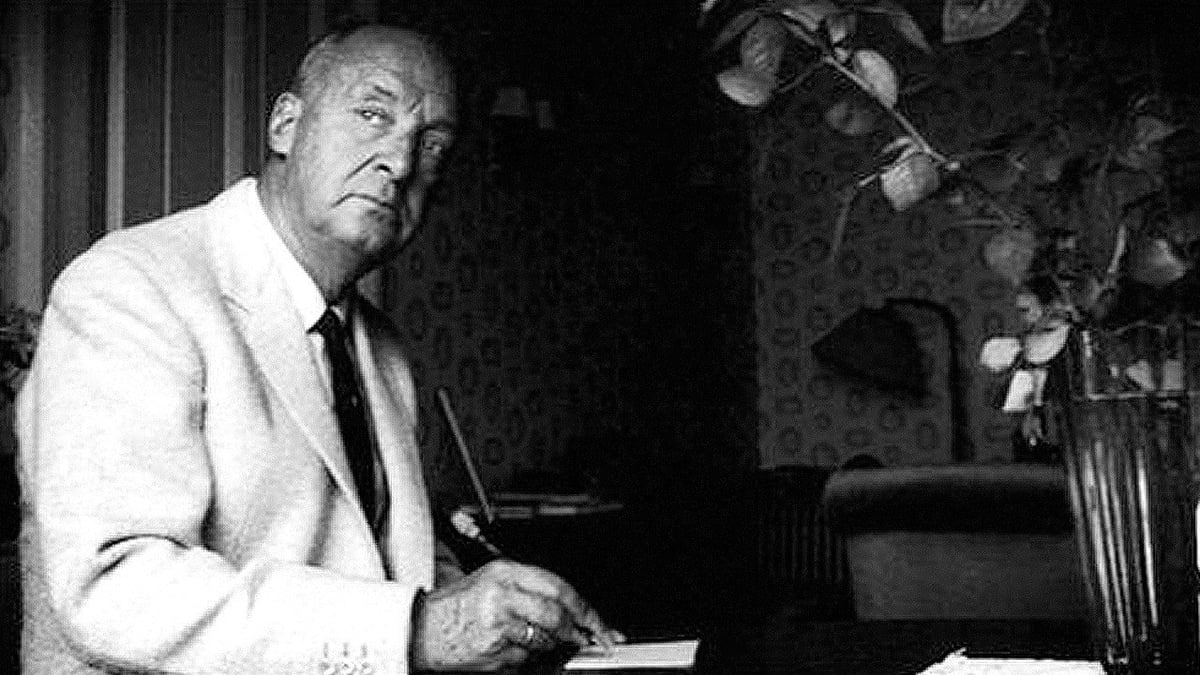
Lately, I’ve been getting more and more interested in dreams, as experiences and as psychological phenomena. I don’t have a fancy theory of dreams as yet beyond “brain garbage,” but brain garbage is still a pretty interesting idea.
A British writer named JW Dunne, writing in the 1920s, did have a fancy theory of dreams — he thought they were a way to access a different kind of consciousness of time, giving clues to precognition and all sorts of other metaphysical leaps. And Dunne’s philosophies appealed to many writers, including Vladimir Nabokov, who kept records of his dreams on neat stacks of index cards. (Nabokov loved index cards.)
Though he kept up his index-card routine for eighty nights, [Nabokov] drifted from Dunne’s method. Rather than flagging his dreams for their precognitive potential, he began to find patterns among them, breaking them into categories: nostalgic or erotic, shaped by current events or professional anxieties. Apart from a dry spell he referred to as “dream constipation,” Nabokov was a prodigious dreamer, his mind a wellspring of trenchant, tender, and perturbing images that he recounts with verve. An old Cambridge classmate “gloomily consumes a thick red steak, holding it rather daintily, the nails of his long fingers glisten[ing] with cherry-red varnish.” A cryptic caller “wonders how I knew she was Russian. I answer dream-logically that only Russian women speak so loud on the phone.” There are capers: in one, Nabokov and his son, Dmitri, “are trying to track down a repulsive plump little boy who has killed another child—perhaps his sister.” And there are intimations of mortality: “A tremendous very black larch paradoxically posing as a Christmas tree completely stripped of its toys, tinsel, and lights, appeared in its abstract starkness as the emblem of permanent dissolution.”
Nabokov’s dream thinking found its apex in the novel Ada, where he writes, “What are dreams? A random sequence of scenes, trivial or tragic, viatic or static, fantastic or familiar, featuring more or less plausible events patched up with grotesque details, and recasting dead people in new settings.” Dreams are “tricks of an agent of Chronos… Some law of logic should fix the number of coincidences, in a given domain, after which they cease to be coincidences, and form, instead, the living organism of a new truth.”
When you’ve died and gone to book heaven

No, you’re burned out and just want to look at pretty pictures of books artfully arranged in architecture! Luckily, Condé Nast Traveler has an article featuring “17 Places Book Lovers Need to Visit,” which fits the bill. Just check out the Royal Portuguese Cabinet of Reading in Rio de Janeiro.

Or China’s Zhongshuge Yangzhou, which uses curved bookshelves and mirrors to create amazing optical illusions. (Dezeen has more pics of this place.)

Moscow’s Cafe Pushkin is also bookishly gorgeous. Oh, just check out the whole thing. Some of the places are less visually exciting, others you’ve heard of a million times, but it’s a nice little piece. Then when you’re done, check out Rachel Leow’s “Bookporn” archives over at a historian’s craft for more of the good stuff.

How to make tea

Last fall, The Big Picture did a series of photographs of tea workers in China. According to the accompanying short article, “The Chinese tea industry employs around 80 million people as farmers, pickers and sales people. Tea pickers tend to be seasonal workers who migrate from all parts of the country during harvest time. The pickers work from early morning until evening for an average wage of around 120 RMB (around 16 euros) a day.”



Why Don’t We Dream About Our Smartphones? (Answer: No one knows, and yes, sometimes we do)
Google’s keyword voids
This was a new term for me:
keyword void, or search void, n.: a situation where searching for answers about a keyword returns an absence of authoritative, reliable results, in favor of “content produced by a niche group with a particular agenda.”
An article by Renee DiResta at Wired uses the example of Vitamin K shots, a common treatment given to newborn babies at hospitals, but whose top search results are dominated by anti-vaccination groups.
There’s an asymmetry of passion at work. Which is to say, there’s very little counter-content to surface because it simply doesn’t occur to regular people (or, in this case, actual medical experts) that there’s a need to produce counter-content. Instead, engaging blogs by real moms with adorable children living authentic natural lives rise to the top, stating that doctors are bought by pharma, or simply misinformed, and that the shot is risky and unnecessary. The persuasive writing sounds reasonable, worthy of a second look. And since so much of the information on the first few pages of search results repeats these claims, the message looks like it represents a widely-held point of view. But it doesn’t. It’s wrong, it’s dangerous, and it’s potentially deadly.
I wondered what other examples of keyword voids might be out there, so I searched for it. Unsurprisingly — in retrosepect — you don’t get a lot of relevant results. It’s mostly programming talk, when you literally want a function to return no results.
Writing as bureaucracy vs. writing as magic

Michael Erard pokes away at the “administrative hypothesis,” the idea that ancient writing had its origin in accounting bureaucracies and existed primarily as a function of state power. There’s just as much evidence, he argues, that states and proto-states co-opted already-existing symbols used by pre-state farmers to keep tallies and mark time, and more provocatively, by priests who used writing as a script for prophecy, narrative, and magic spells.
Over and over, what we see is that writing is more like gunpowder than like a nuclear bomb. In each of the four sites of the independent invention of writing, there’s either no evidence one way or the other, or there’s evidence that a proto-writing pre-dated the administrative needs of the state. Even in Mesopotamia, a phonetic cuneiform script was used for a few hundred years for accounting before writing was used for overtly political purposes. As far as the reductive argument that accountants invented writing in Mesopotamia, it’s true that writing came from counting, but temple priests get the credit more than accountants do. ‘Priests invented writing’ is a reduction I can live with - it posits writing as a tool for contacting the supernatural realm, recording the movement of spirits, inspecting the inscrutable wishes of divinities.
It’s a complex argument, because it has at least two parts:
1) writing wasn’t invented by states (even writing for accounting purposes);
2) writing has been invented for reasons other than an accounting function.
So most of Erard’s examples are arguing against one part of the most robust version of the adminstrative hypothesis, rather than refuting it outright. This is hardly a knockout blow, but it makes for some notable asterisks. (I wish there were more here about China.)
Did blogs ruin the web? Or did the web ruin blogs?
Here are three essays that make very different arguments but are worth reading, and (I think) worth reading together.
1. “How the Blog Broke the Web,” by Amy Hoy. Hoy’s essay is alternately nostalgic for the early days of blogs and smartly critical of the choices that were made then and how they affected the later development of the web.
Suddenly people weren’t creating homepages or even web pages, but they were writing web content in form fields and text areas inside a web page.
Suddenly, instead of building their own system, they were working inside one.
A system someone else built.
In particular, Hoy argues, the push towards chronological organization and frequent chronological updates privileged blogs over other kinds of early web production, and drove out sites that had a weirder, more perpendicular relationship to time.
2. Dave Winer, “What Became of the Blogosphere?” Winer is focused on a narrower problem, but he gives it wide implications.
What changed is we lost the center. I know something about this because I created and operated weblogs.com. It worked at first, but then the blogosphere grew and grew, and weblogs.com didn’t or couldn’t scale to meet it. Eventually I sold it because it was such a personal burden for me.
The blogosphere is made of people, but the people treated the center like a corporation, and it wasn’t. If we ever want to reboot the center, there has to be a cooperative spirit, and a limit to its scope to avoid the scaling problems. You can’t put a big corp at the center of something so independent, or it ceases to be independent…
There used to be a communication network among bloggers, but that’s gone now.
3. Navneet Alang, “Ding Dong, The Feed Is Dead.” Alang is interested in how the disappearing story is coming to displace the chronological archive.
Even if a tweet didn’t ruin your life, you still have an archive of embarrassment that Facebook has diligently saved for you: ill-advised jokes, too-earnest expressions of emotion, and photos in which we simply look terrible. While movements like #deletefacebook were ostensibly about protecting your data from corporations, perhaps they also reflected a desire for another kind of privacy: a way to just erase all that unflattering history.
What happens next is probably not the overthrow of Facebook or Twitter especially now that those platforms are making a lot of noise about how they want to change. The need for an online presence, even if it’s just LinkedIn, is a big historical shift, not just a fad. But instead of a handful of big, public platforms, I wonder if we can expect a proliferation of smaller, more private platforms to find their place. Not only are they safer and friendlier, but they also foster a loyalty and intimacy that the big networks simply can’t….
These smaller, temporary spaces produce a similar effect to traditional social media—a space to vent and laugh and carebut without the downsides of a public forum.
There are some things that reverse chronology is good for, and some things where it isn’t. There are some cases where a greater visibility and intercommunication is exactly what you want, and some where you want the exact opposite. But we’re also riding the wave of dozens if not hundreds of subtly shaping decisions that are not ours, and maybe were never ours. We can only change them if we understand them first.
That’s a tall order for anyone, even if you weren’t here for the entire history of how everything unfolded in the first place.
Rethinking “The Great Migration”
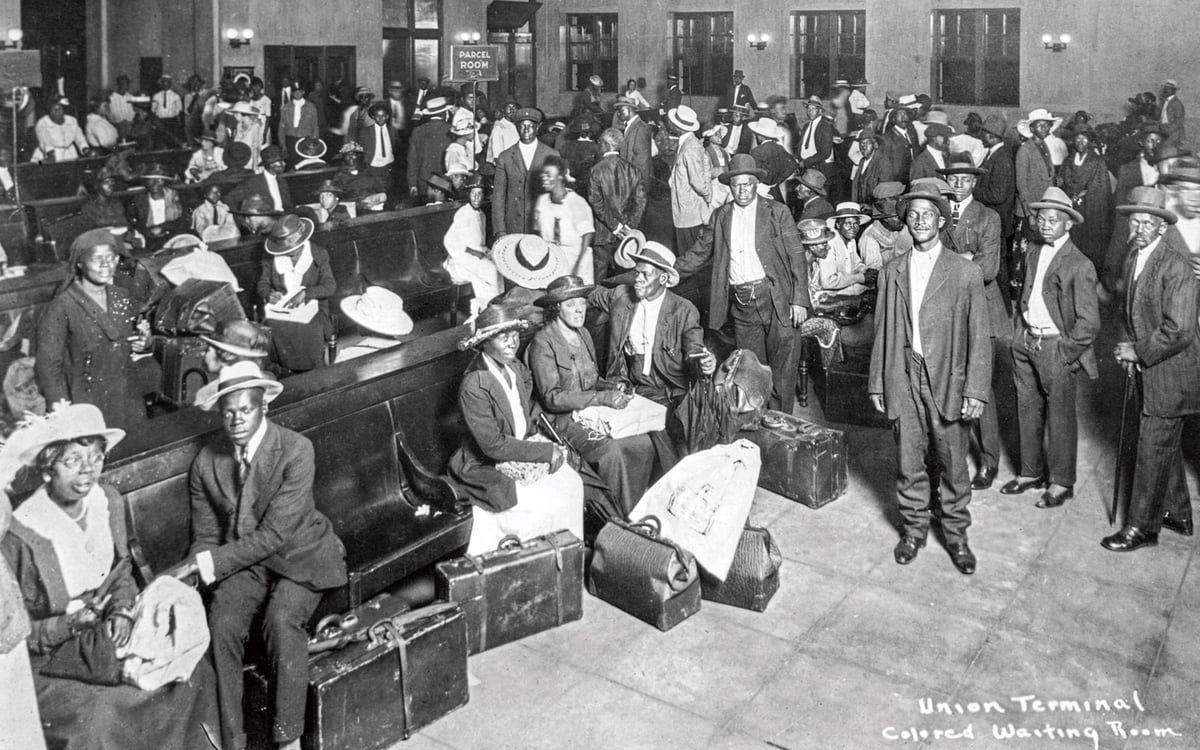
At CityLab, Brentin Mock makes a compelling case for rethinking the causes and consequences of black Americans’ 20th century relocation from the rural South to the industrialized north.
“The Great Migration” makes it sound like a bunch of people just packed up their bags headed for better jobs and homes—no different than the recent trend of Amazon-ian and Apple-American tech nerds moving in droves from Silicon Valley to greener, more affordable pastures in the former Rust Belt. In reality, the stakes for African Americans in the 20th century were much grimmer and urgent—they were moving to save their lives, as Bryan Stevenson, the racial justice advocate behind the lynching memorial and museum, regularly emphasizes. It probably should be called The Great Massive Forced Exodus.
When you look even closer, the idea of a single migration gets even messier, since black Americans weren’t free from lynching and other forms of violence, legal or extralegal, even after they reached the north. (The Autobiography of Malcolm X, among other books, tells this story very well.)
Race riots, redlining, white flight, followed by gentrification and police harassment continue to have the same effect of alternately pushing and constraining the black population around the country. So what you have is a kind of continual, whirling diaspora, shaped by similar forces, but taking on different forms, that continues to and through the present.
Batman’s Wedding

Wonder Woman aside, DC’s recent movies haven’t been very good, but their recent comics have been extraordinary. In particular, writer Tom King has two contemporary masterpieces running side by side, the accessible-but-oh-so-intelligent Batman and the experimental/psychological war-and-family comic Mister Miracle.
Batman has been building beautifully towards Batman’s wedding to Catwoman, culminating in this week’s 50th issue. The ending was spoiled three days early in an article in the New York Times’ Vows column — Abraham Riesman has an interview at Vulture with the author, who regrets the spoilage — but the comic holds up beautifully, even if you know how it ends.
It’s filled with gorgeous artwork from artists who’ve played a key part in Batman and Catwoman’s history together, and each page acts as a kind of counterpoint to the one opposite it. (Writers and other important figures from the Batman mythos get their head nods elsewhere, as names of buildings, streets, and rooms in Wayne Manor.) And it has its share of moving moments, like this quiet embrace between Bruce Wayne and Alfred.
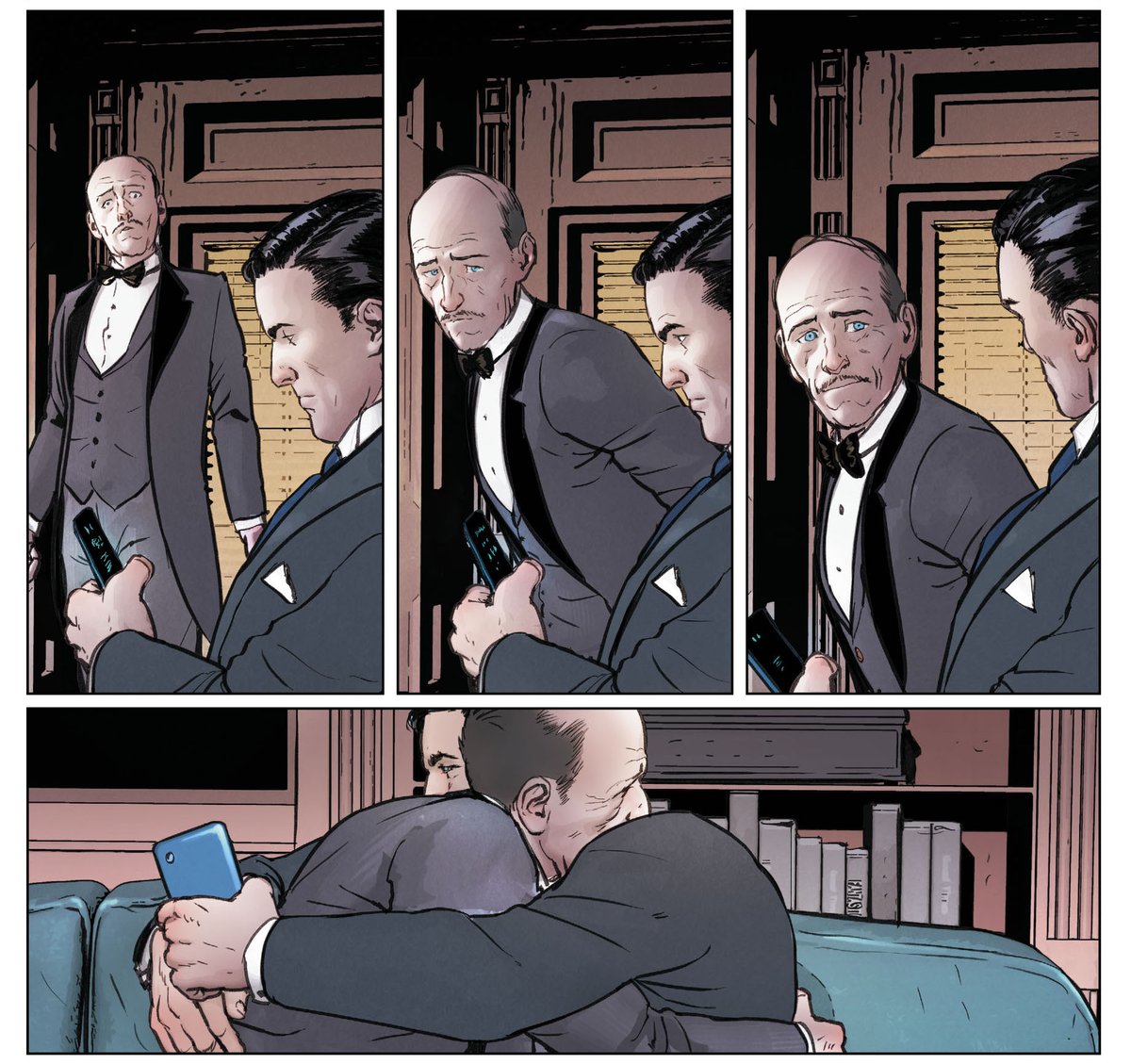
The real thrill is probably in the run-up, which you can read in trade paperbacks now. My favorite issue might be number 36, where Superman and Batman separately explain to Lois Lane and Catwoman, respectively, what they admire about each other. I mean, this is just superhero nerd gold.
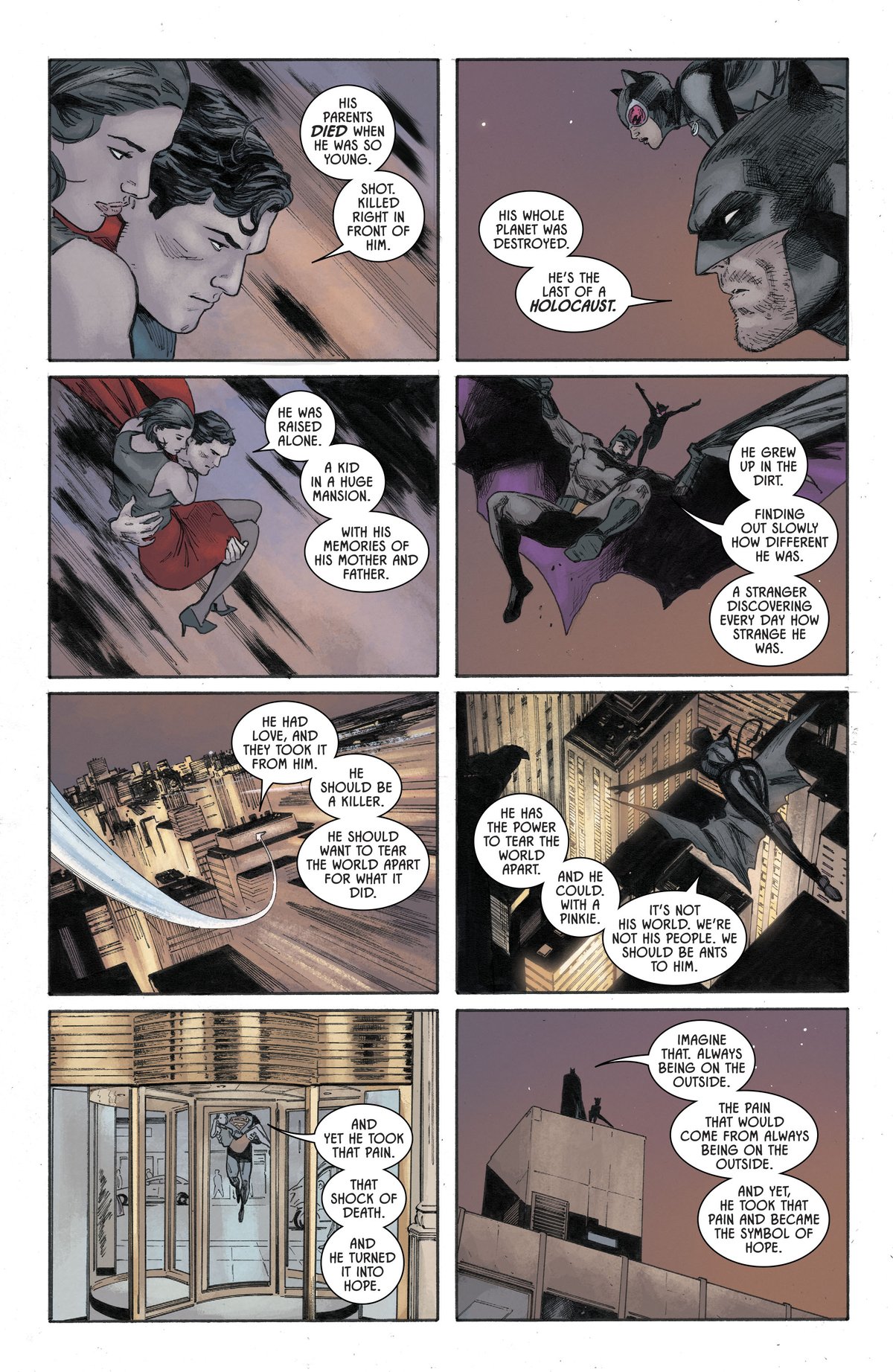
This is all to say: despite some blockbuster fatigue, I think we’re still quite far from exhausting superheroes as a concept. Every time I think we’re there, someone comes up with rich, thoughtful, emotionally moving stories that bring me right back again.
Partners in prewar Greenwich Village
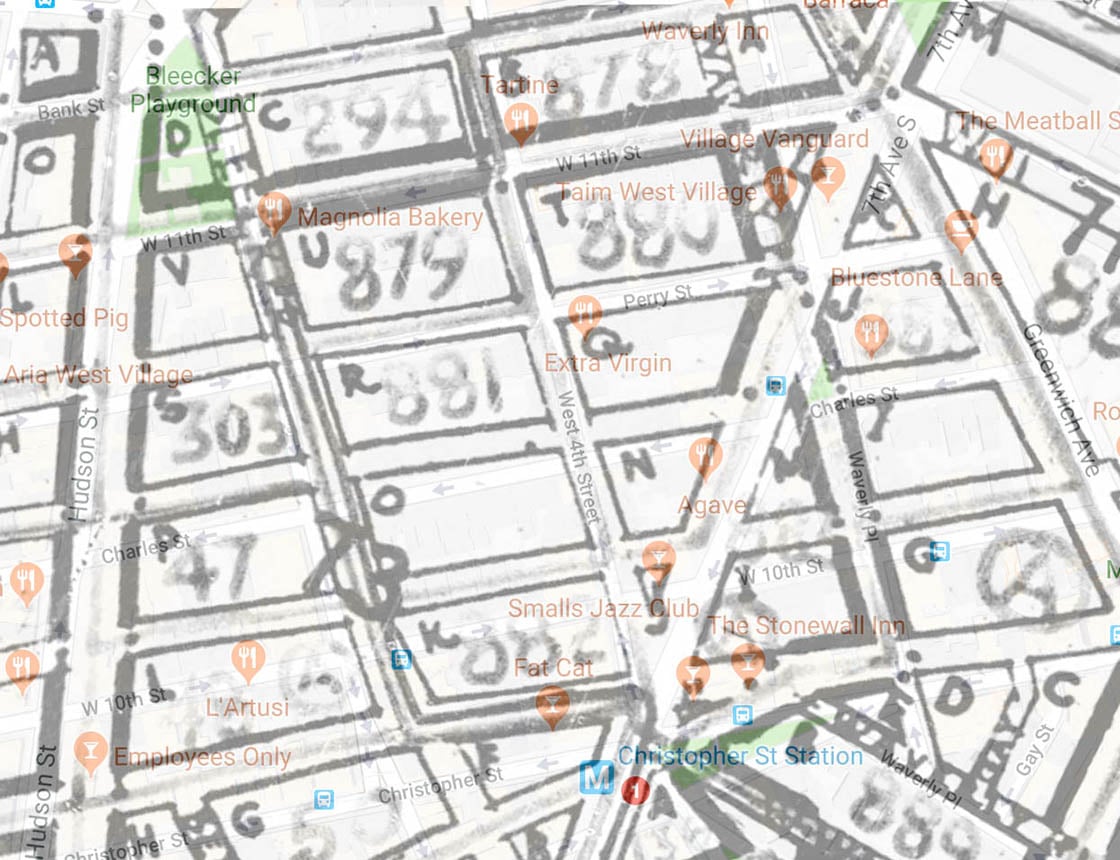
My friend, the historian Dan Bouk, has a fascinating find in the 1940 U.S. census. Over 200,000 people are listed as “partners” on census accountings of households, despite the fact that the census instructions make no particular allowance for “partners” as a category.
What’s more, partners show up disproportionately in neighborhoods where we know gay people settled: Greenwich Village, parts of the Upper East Side, and so forth.
All we can say for sure about Brand and Grant—and the other 11 partnerships that Davis recorded—is that they shared a sink. It seems likely that at least some of these households did live together as lesbian or gay couples. But it could also be that we find so many partnerships in this gay neighborhood, because the presence of queer folk indicated or amplified social and cultural spaces in which people could live openly in odd (that is, unusual), but non-sexual arrangements. The census didn’t ask about sexual identity or sexual behavior, and so we cannot know from the census alone.
As for those other partnerships, five partners were women living with another woman, the pairs always within a few years in age. They included a pair of doctors, two travel agents (who may have been business partners, if nothing else), an editor and a secretary, and a secretary and a stenographer who both worked for the YMCA(!). Two of the partners were male-male, including a police detective who lived with a patrolman.
As Bouk writes of his own (romantic) partner, “I thought we were being very modern, that this was a new sort of relationship.” But partners seem to have been around and declared for a very long time.
Maps of love
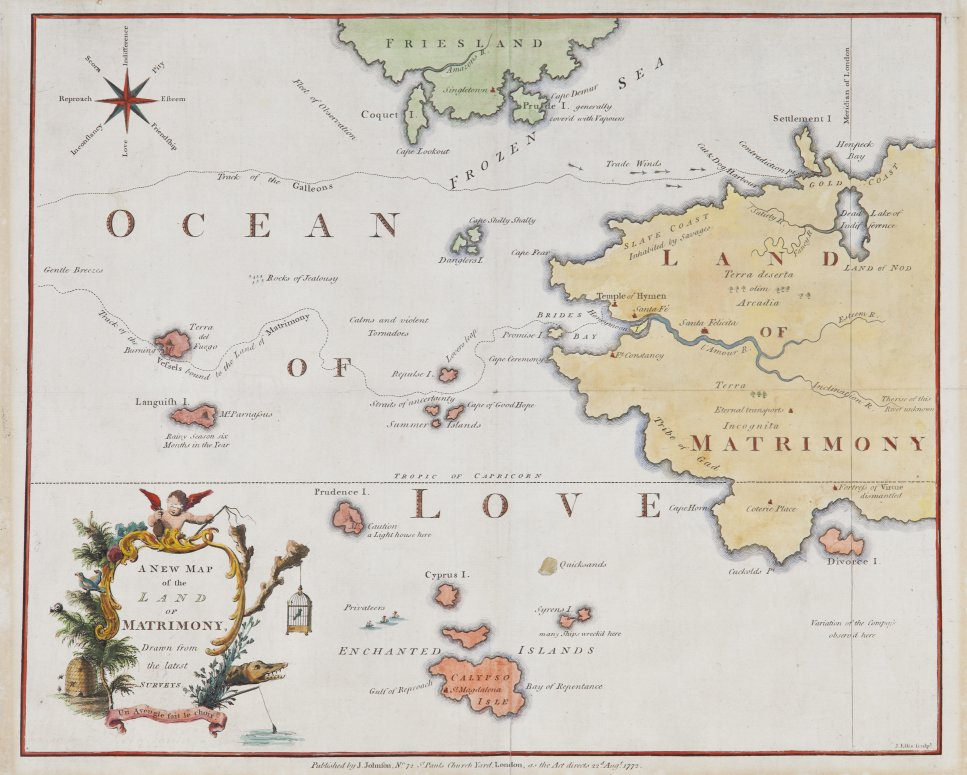
The Land of Matrimony, 1772
The Public Domain Review has an interesting collection of allegorical maps of love, courtship, and marriage, in multiple languages and styles, from the 17th to the 19th century. I’m partial to this very early map, La Carte de tendre; “conceived by Madeleine de Scudéry for inclusion in her novel Clélie (1654-61) and engraved by François Chauveau.”
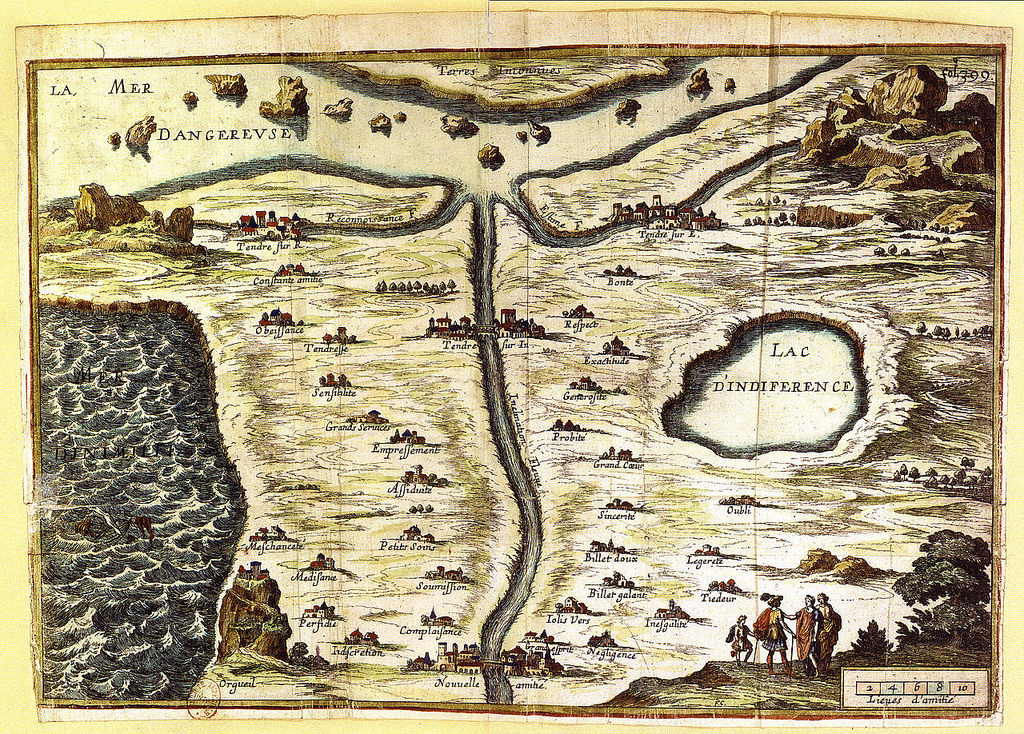
Here one can travel, by following the river of Inclination, from the town of Nouvelle Amitié (New Friendship) in the south to the town of Tendre (Love) in the north — that is if one can avoid the various pitfalls and obstacles which line the route, including the strangely inviting Lac D’Indiference (Lake of Indifference).
Maps were the memes of their time.
The reaction time problem
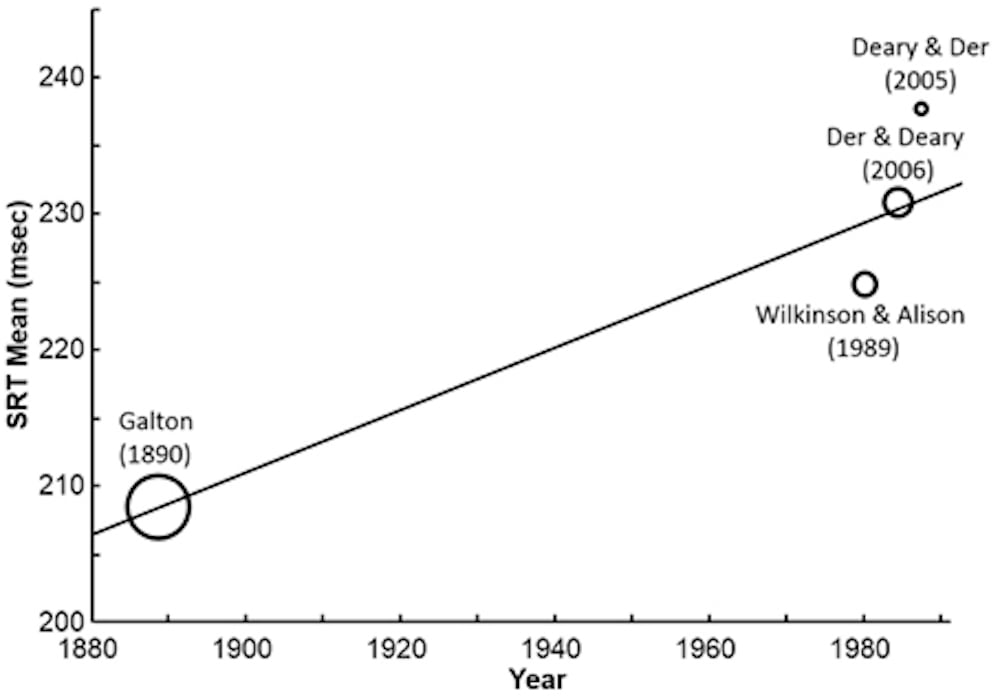
Francis Galton, a Victorian eugenicist and statistician, was obsessed with measuring reaction time as a proxy for general intelligence. In 1885, 1890, and 1892, he collected “data on the sensory, psychomotor, and physical attributes of 1,639 females and 4,849 males.” Eventually, though, reaction time gave way to other questionable measurements of generalized intelligence like IQ tests and scholastic aptitude scores, so most of us don’t keep track of our reaction times, if we’ve ever had it measured.
Here’s the thing, though — everyone who’s tried to repeat Galton’s experiments in the 20th and 21st century, across populations, varying the equipment used and the measurement process taken, etc., has never been able to get reaction times as fast as what Galton measured. IQ scores have generally risen over time; reaction times have slowed down. It’s a matter of milliseconds, but the effect is large: about 10 percent. It is quite possible that young adults in 19th century Great Britain were just plain faster than us.
Tom Stafford, writing at Mind Hacks, has some helpful caveats:
What are we to make of this? Normally we wouldn’t put much weight on a single study, even one with 3000 participants, but there aren’t many alternatives. It isn’t as if we can have access to young adults born in the 19th century to check if the result replicates. It’s a shame there aren’t more intervening studies, so we could test the reasonable prediction that participants in the 1930s should be about halfway between the Victorian and modern participants.
And, even if we believe this datum, what does it mean? A genuine decline in cognitive capacity? Excess cognitive load on other functions? Motivational changes? Changes in how experiments are run or approached by participants? I’m not giving up on the kids just yet.
Clunky touchscreens are easier to use than slick ones

I really enjoyed Amber Case’s essay “The Hidden Cost of Touchscreens.” It’s a quick but surprisingly thorough look at where touchscreen interfaces are inappropriate or just plain go wrong.
For instance, touchscreens in cars are problematic for anything that’s going to be used during driving, because well, touchscreens require looking at a thing. For muscle memory and mission-critical tasks, physical buttons are better.
But I also appreciated her nuanced, experience-driven take on ways to improve touchscreen design, where too often clean aesthetics have pushed out strict usability.
Touchscreen design could benefit from some basic design principles. Color-based interfaces take less time to parse when they are glanced at. Image-based interfaces take longer for the brain to process, and the lack of contrast can be confusing, because each item must be distinguished from adjacent items. When so many images look alike, service workers must rely on position and muscle memory for speedy use.
When I worked in food service and in the mailroom, the uglier touchscreens were always easier to work with. They were color coded with bright, contrasting colors, making the boundaries between numbers or items very obvious. I found that the colors reduced mistakes. I’d usually tap the right items after barely even glancing at the interface. After a while, I’d only check the screen for mistakes at the end of the process, before submitting an order or printing a receipt.
I think touchscreens in general are more usable now than they used to be, simply because of learning effects: more of us are used to dealing with touch interfaces in lots of different contexts, and we translate that familiarity wherever we go. At a certain point, though, we bump up against some hard limits of the human brain, eyes, and hands. Trying to fight against those hardly ever turns out well.
Rosa Parks’s Arrest Warrant
A courthouse intern on a housecleaning project named Maya McKenzie turned up a slew of rarely-seen original documents of the Montgomery Bus Boycott. They include Rosa Parks’s arrest warrant and court records, as well as a bond posted for Martin Luther King Jr. on charges of conspiracy, and more.
“A lot of times in our schools, when we teach about the movement, it’s all centered around one person, one figure, but what this does is open up that world to give the back story, to let them know that there were so many people that were involved,” said Quinton T. Ross Jr., the president of Alabama State, a historically black university, where a professor once used a mimeograph machine to run off thousands of fliers announcing the boycott.
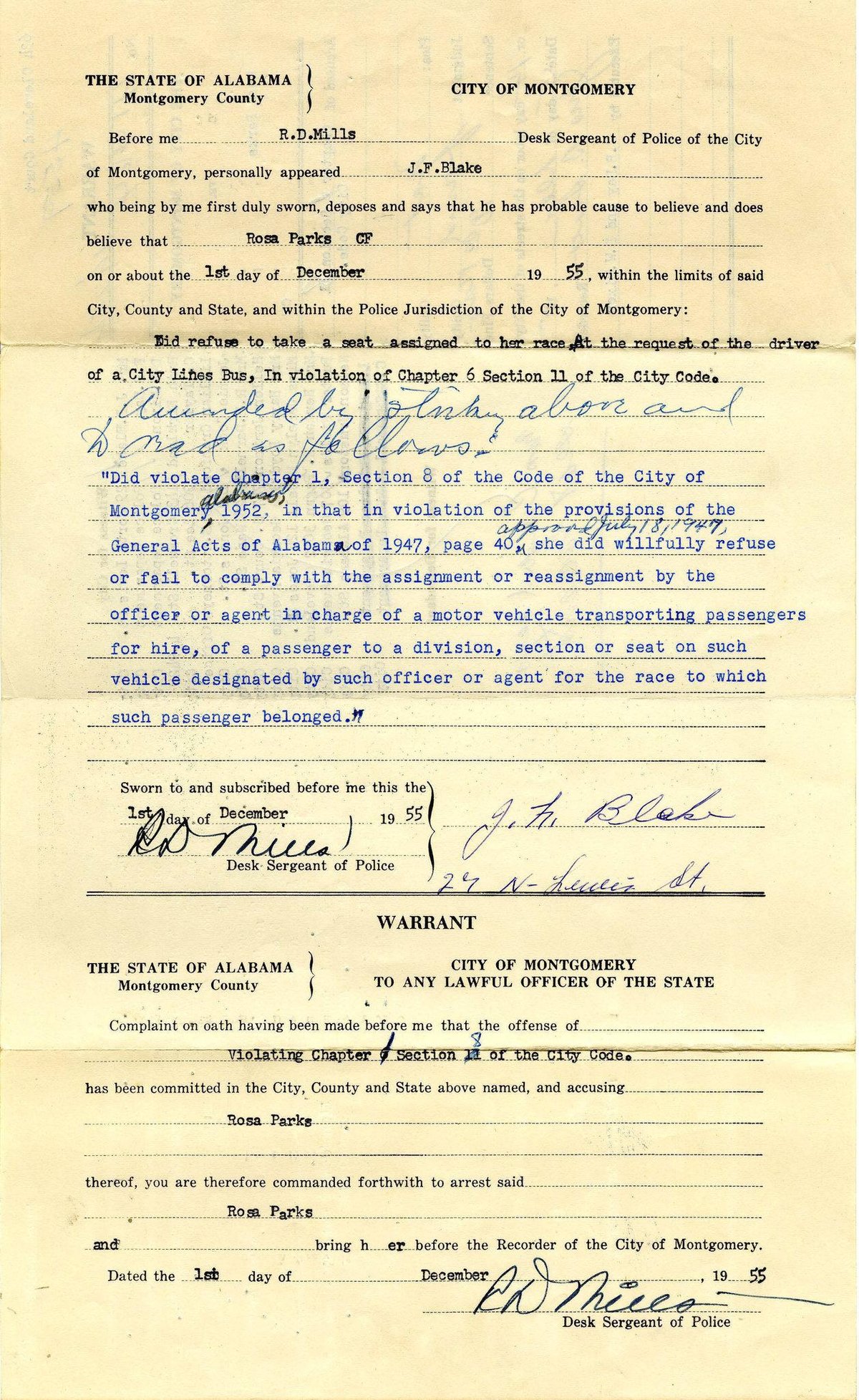
What’s odd is that the records appeared to have already been gathered together, but not for any clear reason. They had never been made public.
Goodbye, LeBron; Love, the Midwest
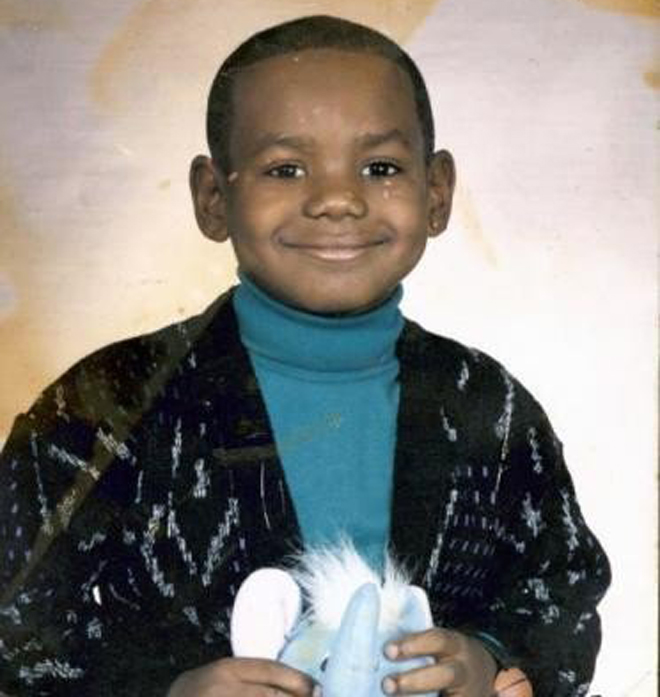
I don’t live in Cleveland or Akron. I live, and grew up, just north of Detroit, in an inner-ring suburb known for Thai and Vietnamese restaurants and multiple expressways.
I didn’t live in the midwest for LeBron’s first run with the Cavs. I lived in Philadelphia, a city that was sports-crazy in its own aggro east-coast way, but didn’t live and die with its sports teams in the same all-enveloping way. Any city with an Ivy League campus has pockets of people who don’t notice sports at all.
When LeBron moved to Miami, I moved to New York. It made sense for both of us; a better job on a bigger stage, hopefully a better life. But soon enough, we were both headed back to the Midwest; we were both headed back home.
For a hot minute, I thought we were both headed to Philadelphia again. But some dreams are too good to be true.
The Midwest is sports-crazy; the midwest is sports-starved. Free agents don’t want to play here. Owners don’t want to spend money. Championships cluster on the coasts.
When teams like the Warriors win, it’s compounded good news for a team moving to take advantage of San Francisco’s riches. When the Cubs or Packers or Cavs win, we talk about century-long curses lifted, quaint tales of tiny markets that could, and the uplift of entire regions.
Of the twenty best basketball players who ever played, nine of them have played for the Los Angeles Lakers. (Yes, I’m counting Karl Malone.) Only two ever played for Cleveland. (One of them was washed-up Shaq.)
Three of the best five — LeBron, Jordan, and Kareem — played in the Midwest. Two of them left for LA.
It was special to have LeBron James in the Midwest. In the age of player empowerment he ushered in, to play for a man he hated, at a time when blue states have flipped to red, when billionaire oligarchs are buying up whole cities, and the national discourse tries to erase everything in the region but its white reactionaries, LeBron was the best of us. He stood up, somehow taller and more regal than the sea of tall, regal men, unafraid to tell the truth. Through Ferguson, through Tamir Rice, through Trump and Trumpism, he stood up and told the truth. I won’t forget it.
He also dragged four outmatched teams to four straight Finals through sheer talent, intelligence, and force of will. I won’t forget that either.
I’m not happy he’s going to the Lakers. (As a Pistons and Sixers fan, we have history. However, I am cool with him getting out of the Eastern Conference.) But I’m happy in the hope that he will get to be happy.
Update: Strongly recommend today’s The Lowe Post podcast with Zach Lowe and Brian Windhorst, which digs into the tick-tock and the fallout of LeBron going to the Lakers, including some midwestern angst over what it means as a midwesterner to have so many of the good players bound to the coastal metropoles.
Goodbye to The Straight Dope
The Straight Dope — which some readers might know only as an online message board with impressive Google Juice — is closing up the weekly print column that got the whole mess started.
Why the change, and why now? With the planned sale of the Chicago Reader, the folks at Sun-Times Media, which will continue to own the Straight Dope, are re-thinking the once-a-week deep dive (sorta) on a single topic (usually) in question-and-answer format. It’s possible a successor to the Straight Dope will emerge, possibly with daily online content. But no decision has been made, and my role, if any, has not been determined. In the meantime, I’m thinking about publishing another Straight Dope book - it’s been nigh on 20 years since the last one.
However that works out, the Straight Dope legacy will remain intact. The Straight Dope archive - some 3,400 columns, most written by me, the balance by the Straight Dope Science Advisory Board, my online auxiliary - will remain accessible at www.straightdope.com. The Straight Dope homepage will continue to be updated with recycled classics. The Straight Dope Message Board (SDMB), the online community that has grown up around the column, will remain open for business.
The Straight Dope was and remains really important to me. It was an alt-weekly question-and-answer column about anything and everything. Pre-internet, I gobbled up the collected columns in paperback. My grandmother gave me my first copy, which I don’t know if she would have done if she’d known the semi-lewd contents inside. She just knew that like her, I liked to read and liked to know things. In college, I used to say that half the things I knew were things I’d read in The Straight Dope. After college, I moved to Chicago, and read it in the Reader regularly, where it now seemed tweedy and straight-laced. When I was talking to Jason about developing Ask Dr. Time, TSD was my first reference. I’m going to miss it.
The Toast archives are back! Enjoy “If Levar Burton and Yo-Yo Ma Were Your Dads”
Hidden treasures of Amsterdam’s river
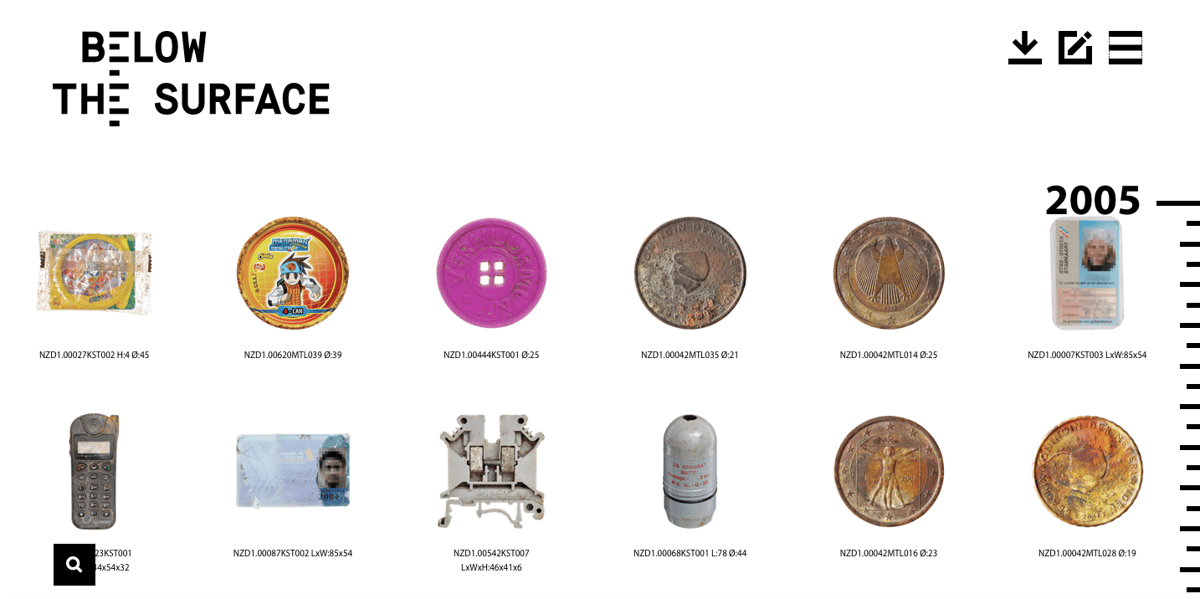
Between 2003 and 2012, civil engineers in Amsterdam excavated a brand-new North-South metro line along the banks of the river Amstel. A website (thankfully available in Dutch and English) documents what they found.
Rivers in cities are unlikely archaeological sites. It is not often that a riverbed, let alone one in the middle of a city, is pumped dry and can be systematically examined. The excavations in the Amstel yielded a deluge of finds, some 700,000 in all: a vast array of objects, some broken, some whole, all jumbled together. Damrak and Rokin proved to be extremely rich sites on account of the waste that had been dumped in the river for centuries and the objects accidentally lost in the water. The enormous quantity, great variety and everyday nature of these material remains make them rare sources of urban history. The richly assorted collection covers a vast stretch of time, from long before the emergence of the city right up to the present day. The objects paint a multi-facetted [sic] picture of daily life in the city of Amsterdam. Every find is a frozen moment in time, connecting the past and the present. The picture they paint of their era is extremely detailed and yet entirely random due to the chance of objects or remains sinking down into the riverbed and being retrieved from there. This is what makes this archaeological collection so fascinating, so poetically breathtaking and abstract at one and the same time.
If you don’t love browsing through lost IDs, credit cards, and everyday coins, a section called “Object Stories” highlights the more noteworthy finds: batteries from the 19th century, stoneware jugs and tankards from the 16th century, pieces of samurai swords, and more.
National Geographic’s Maps Archive
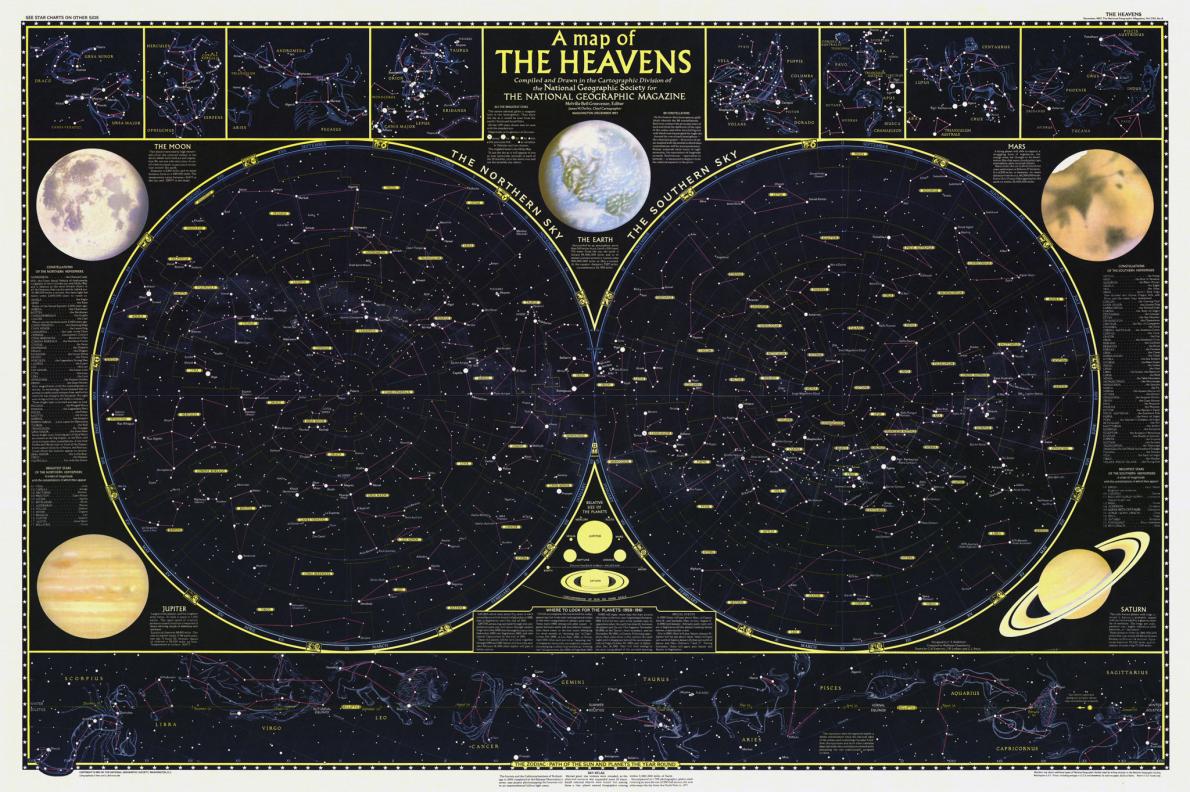
National Geographic is making digital copies of its century-plus archive of maps available to the public… with a twist. Immediate access to the full archive is subscriber-only. The rest of us get a new map a day, on Twitter, Instagram, or Facebook.
So you might get this gorgeous 1961 panorama of London, with individual hand-painted buildings…

… or you might get this 1894 sketch of Antarctica.

Which is not uninteresting, but it’s interesting for different reasons.
As a longtime advocate of digging in the crates, I have to applaud Nat Geo making creative use of its own archives. Even if the greedy part of me wants all the goodies at once.





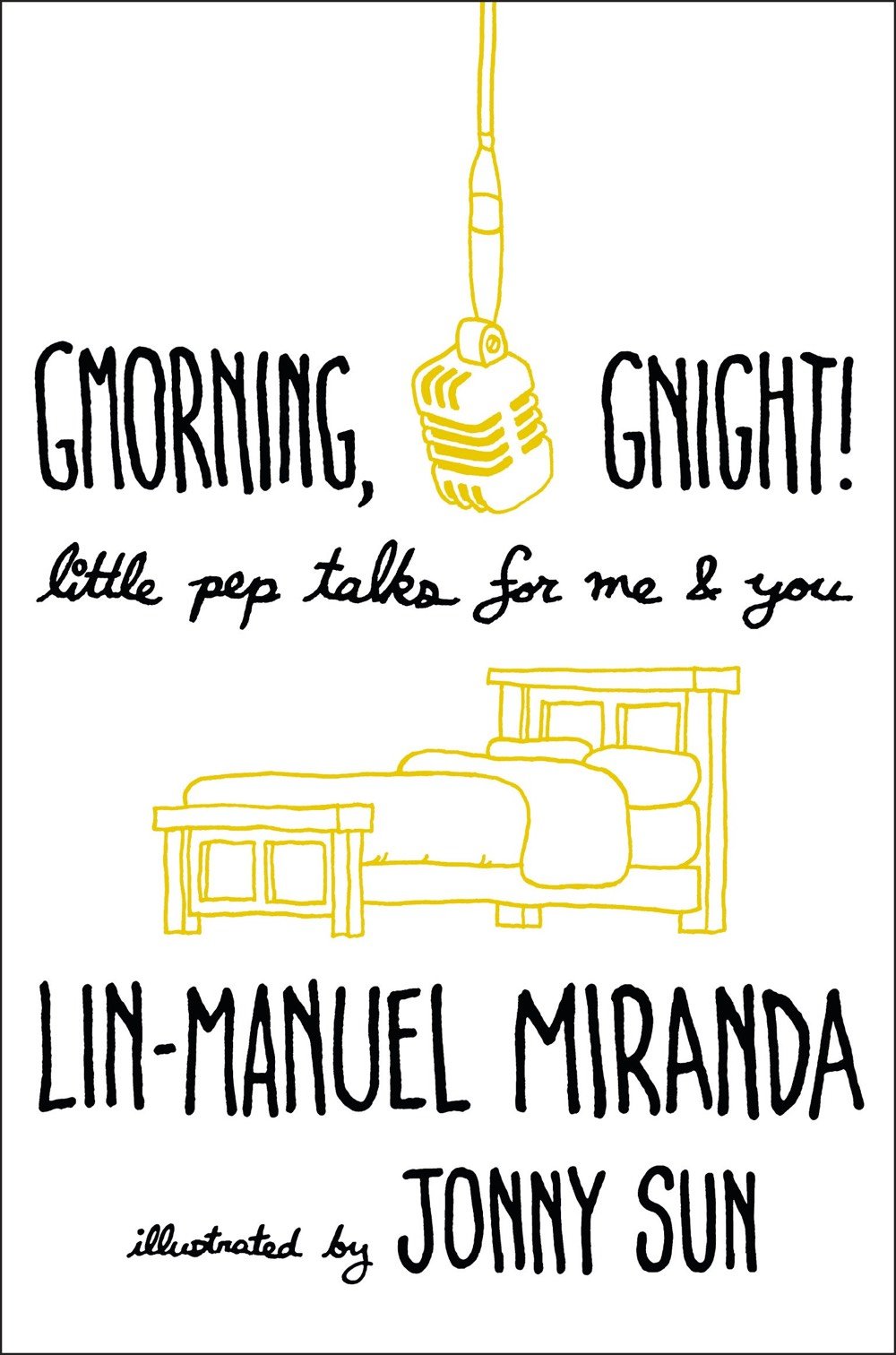
Stay Connected